
If you are coming to visit Provence, don't stop in Avignon!
Once here, like a siren, the city will entrance you and you won't want to leave!
And just to see the sights, you can spend days wandering the neighbourhoods within the city walls and never get bored.
Avignon is full of history and full of life.
Capital of the Vaucluse and the Côtes du Rhône, seat of the popes and city of art and culture, theatre, cinema, museums, big stores and little shops, Avignon is a small city that has everything a big one has, and then some...
From medieval streets and houses to private mansions from the Renaissance, passing through all its old and enticing squares, some no bigger than a tiny lane... And the diverse dining opportunities, ranging from family-run restaurants, good and inexpensive to some of the greatest Michelin-starred chefs.
Avignon invites you for a stay beyond all imagination.The historic city centre, the Popes' Palace , all the episcopal buildings and the Saint Bénézet Bridge are listed as world heritage sites by UNESCO.
The historic centre radiates from the Place de l'Horloge .
Here, you find the City Hall built between 1845 and 1851 over a former cardinal's palace of which it has kept the old fortified tower, transformed into a belfry in the 15th century with clock and Jacquemart. Next to it, the municipal theatre, also from the 19th century, houses the Avignon opera and, all the way at the top, the delightful Belle Époque style carrousel still turns.
Originally the forum of Avenio, the city's name under the Romans in the 1st century BC, the Place de l'Horloge is still the “centre” of Avignon. A meeting place, bordered by cafés and restaurants, the square is always bustling. Just like the Place du Palais higher up, a vast esplanade where you could spend the day just watching all the street performers in summer.
And as its name implies, here stands the formidable Popes' Palace, emblem of the city and awe-inspiring monument to the importance of Avignon in the Christian world of the Middle Ages.
Built in the 1300s, mainly by two popes - the austere Benedict XII and his successor, the much less ascetic Clement VI, - the palace would become the biggest gothic edifice in all of Europe. A tour of the palace, which includes the popes' private apartments with their fabulous frescoes, is one one of the musts of Avignon.
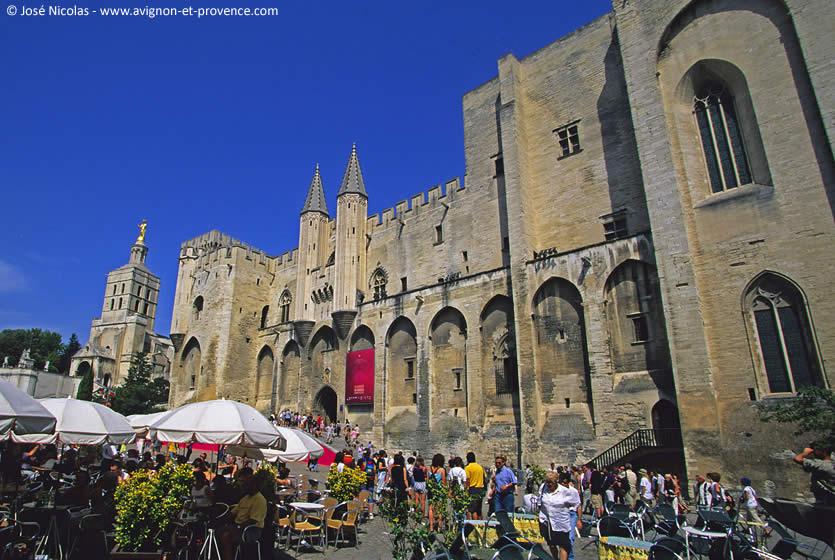
Palace of the Popes Square, Avignon Festival
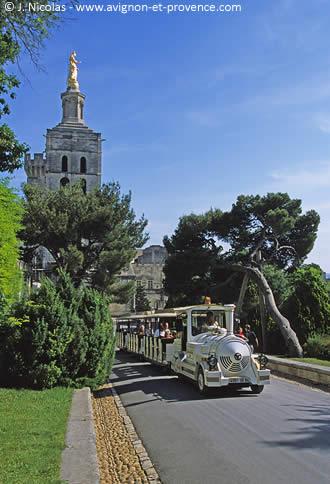
Next to the palace, the Notre-Dame des Doms Cathedral , built in 1150 in a Provençal Romanesque style, was put on the first very list of historic monuments in 1840. From the top of its bell tower, the statue of the Virgin Mary, entirely gilded in gold, 6 metres high and weighing 4500 kilos, blesses and protects the city.
Across from the palace, dragons and eagles stand guard over the imposing edifice of the Hôtel des Monnaies , once the city's mint. And not far away, the Petit Palais , a former cardinal's residence turned into a museum, houses an impressive collection of Italian primitive art, old sculptures by Avignon artists and paintings from the Avignon School.
If all this splendour and exuberance already has your head spinning, go up to the Rocher des Doms , the cradle of the city, for a refreshing break amongst the peacocks and swans by the pond. From this spot, you have panoramic views over the entire city, its tiled roofs and bell towers and over to Villeneuve-les-Avignon and all the surrounding areas.
At the bottom of the Place de l'Horloge , the main avenue, Rue de la République , divides the city into two. On one side, the Rue Saint Agricol leads to the chic and bourgeois quarter with the Rue Joseph Vernet , the 5th Avenue of Avignon where designer clothing and luxury goods shop abound, and the Place Crillon , with the prestigious Hotel d'Europe in a former private town mansion built in the 16th century for the Marquis de Graveson.
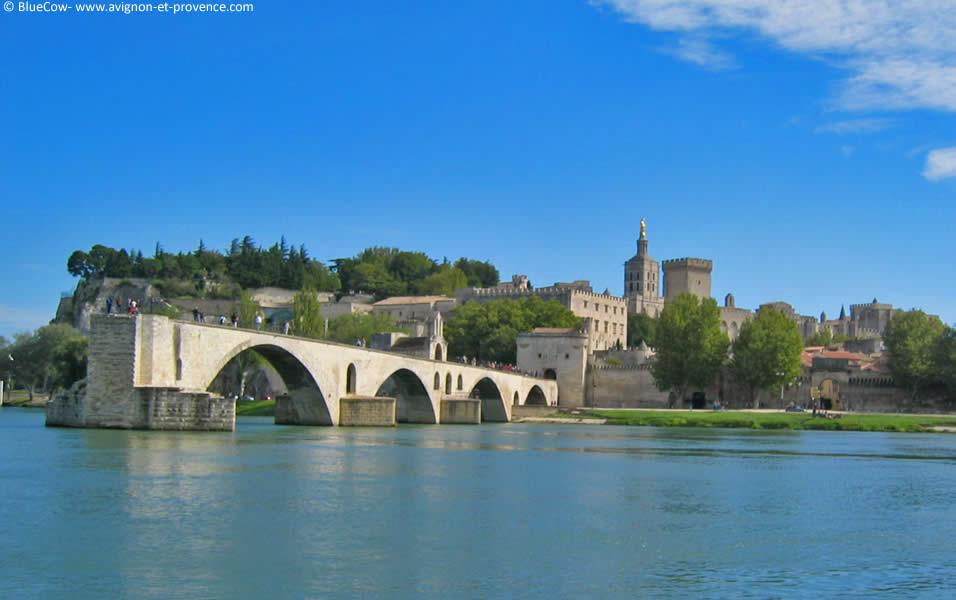
Panoramic view over Avignon from the Barthelasse Island
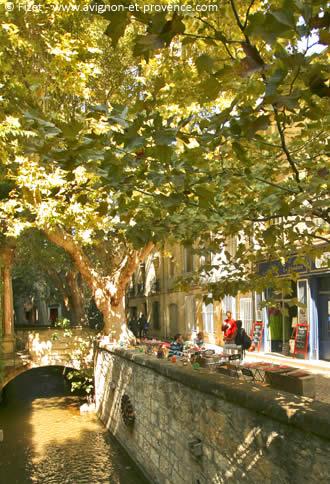
On the other side, the pedestrian and shopping zone leads to the Place Pie and the Halles , the covered market adorned with a hanging garden . A meeting place for the people of Avignon, the stalls offer all sorts of foods and treat. Don't go with an empty stomach!
Not far from there, the Place des Carmes also has two very popular markets: a flower and farmers' market on Saturday mornings and the flea market on Sundays. The square gets its name from the magnificent Carmelite cloisters and its 13th century convent church.
Or you can head to the bohemian quarter of Avignon and the Rue des Teinturiers bordered by the little Sorgue river. If it is not the centre of Avignon, the street is one of its “hearts”. Today haunted by artists and musicians as well as born and bred Avignonnais, this delightful cobblestone street dates from the Middle Ages and the period when the textile industry was in full swing.
If the water wheels, of which four still remain from their heyday, no longer turn, the street certainly swings with its wine bars, small cool restaurants, musical evenings, all in the shade of the sycamores and in an almost village-like ambiance.
If you want to open up your horizons, go do a tour of the ramparts . The Avignon city walls constitute the 2nd longest continuous wall in the world, after the Great Wall of China. You can access the walls' walkway from the Rocher des Doms or from the Saint Anne stairs behind the palace.
Then, go dance on the famous bridge of Avignon . The Saint Bénézet Bridge was built around 1180 – miraculously, according to legend, by a simple shepherd – to link the city to Villeneuve-les-Avignon.
Over the years, a war and successive flooding by the Rhône partially destroyed the bridge. Today, the 12th century Saint Nicholas Chapel remains, as well as four arches of which the span constitutes, according to a prestigious civil engineer, an amazing feat for the period.
At the foot of the bridge you will find the landing pier for the cable ferry that will take you free of charge to the Barthelasse Island for a stroll in the countryside just a stone's throw from the city.
Unless you prefer exploring one of the museums of which Avignon has many. Between the collections of contemporary art (the Lambert Collection ) and of paintings ( Musée Angladon and Petit Palais ), the museum of Fine Arts ( Musée Calvet ), of archaeology ( Musée Lapidaire ) and of period furnishings and decorative arts ( Musée Louis Vouland ), you will be spoiled for choice.
And let's not even talk about the religious edifices!
Rabelais wanted to call the city the Ile Sonnante, or the Chiming Island, because of all the churches, chapels and convents. We can't list all of them here but mention should be given to the exquisite Saint Pierre Basilica , particularly captivating when illuminated at night, the majestic Saint Didier Collegiate Church and the Protestant church of the Temple Saint Martial.
Everywhere, just around a corner or on a small square, you will come across a penitents' chapel or small church, all of them housing treasures and artworks of inestimable historic value.
A city to be savoured in all seasons thanks to the many events that take place throughout the year, Avignon really takes on another dimension during its “5th season” in July, when the Avignon Theatre Festival takes place.
This festival of dance, music and theatre was founded in 1947 by the actor and director Jean Vilar (2016 will be the 60th festival). The shows are performed everywhere throughout Avignon, even in the streets. Today, it enjoys international renown but, with the less formal Festival Off , a close audience rapport has been maintained.
Advice to visitors: with all the pedestrian zones and one-way streets, driving can be difficult for those who don't yet know the city. On top of that, parking is sometimes a nightmare. If you are staying in one of the city's hotels, inquire at reception about the best way to park. If you are coming just for the day, consider leaving your car in one of the lots just outside the ramparts, such as the Parking des Italiens or on the Ile Piot; both of them have a free shuttle service into town every few minutes that even operates late into the evening in summer.
Art of living
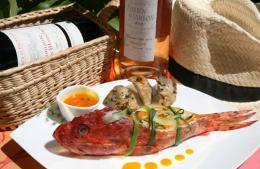
Gastronomy, markets of Provence, regional products, Christmas traditions, celebrities of Provence....
Where to sleep?
Numéro 15 – Les Confidences
160 EUR/night*
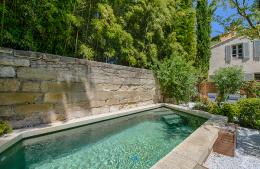
Bed and breakfast - Avignon and the surroundings
454 EUR/night*
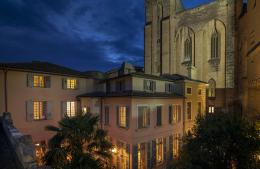
Hotels - Avignon and the surroundings
450 EUR/night*
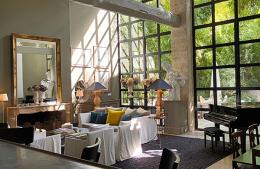
Vacation rental - Avignon and the surroundings


10 Top-Rated Things to Do in Avignon
Written by Lisa Alexander Updated Dec 22, 2023 We may earn a commission from affiliate links ( )
An excellent starting point for exploring Provence , the historic city of Avignon awes with its stunning papal palace. The UNESCO-listed Palais de Papes was the residence of seven Popes from 1309 to 1377 and is a testimony to the wealth and power of Christendom during the Middle Ages.
The tourist appeal of Avignon goes beyond its amazing UNESCO World Heritage Sites. This city is known as a center of art and culture. Attending festivals are some of the main things to do in Avignon throughout the year, from the popular summertime Jazz Festival to a traditional Christmas market in December.
Enjoy the relaxing Provençal atmosphere of this small town as you explore the quaint streets, such as the Rue des Teinturiers and elegant squares like the Place des Corps Saints. At the heart of Avignon, the Place de l'Horloge is lined with shady plane trees and filled with cafés where patrons sit and watch the world go by.
Avignon also makes a good base if you want to explore nearby towns and attractions. Discover more places to visit in and around this historic city with our list of things to do in Avignon.
See also: Where to Stay in Avignon
1. Palais des Papes
2. pont saint bénézet, 3. rocher des doms, 4. musée du petit palais, 5. basilique métropolitaine notre-dame des doms, 6. eglise saint-didier, 7. place de l'horloge, 8. basilique saint-pierre, 9. avignon festivals, 10. musée calvet, where to stay in avignon for sightseeing, day trips from avignon, provence's ancient roman sites, hilltop villages of the luberon, saint-rémy de provence, villeneuve-les-avignon, map of things to do in avignon, other interesting places to visit near avignon.
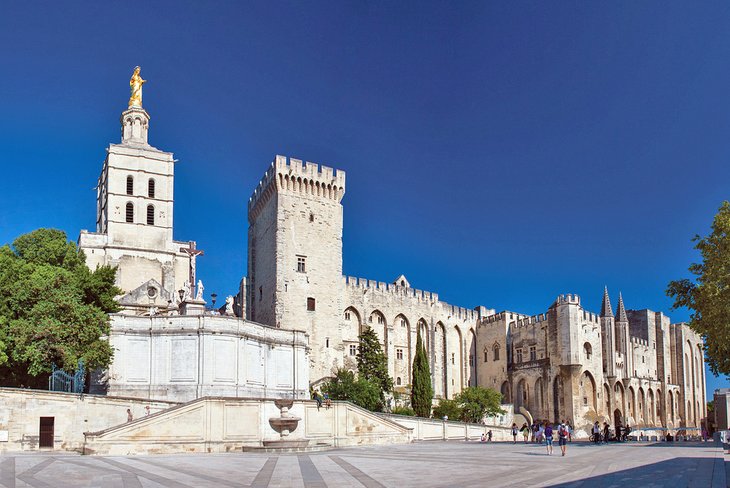
To visit the Palais des Papes is to witness the power of the Papacy during the Middle Ages.
Designated as a UNESCO World Heritage Site , this imposing palace was the most important monument in Christendom during the 14th century, when Pope Clement V moved the papal court from Rome to Avignon.
You can take a tour of the interior to see the 20 rooms that are open to the public. Although most of the furnishings have disappeared, the interior offers a sense of the vastness of the space. The halls, stairways, bedrooms, and chapels were all built on a grand scale around a central courtyard.
Highlights include the Great Audience Hall , an enormous hall embellished with wall paintings; the Grand Tinel banquet room; the Saint Martial and Saint John chapels , decorated with well-preserved frescoes created by the Italian painter Matteo Giovanetti; and the Great Clementine Chapel, a huge single-aisled church where official ceremonies were held.
From the Great Chapel, there is an entrance to the loggia where the large traceried Fenêtre de l'Indulgence (Window of Indulgence) offers a view of the Great Courtyard . From this window, the Pope used to give his blessings to the faithful.
Address: Place du Palais, Avignon
Official site: http://www.palais-des-papes.com/en
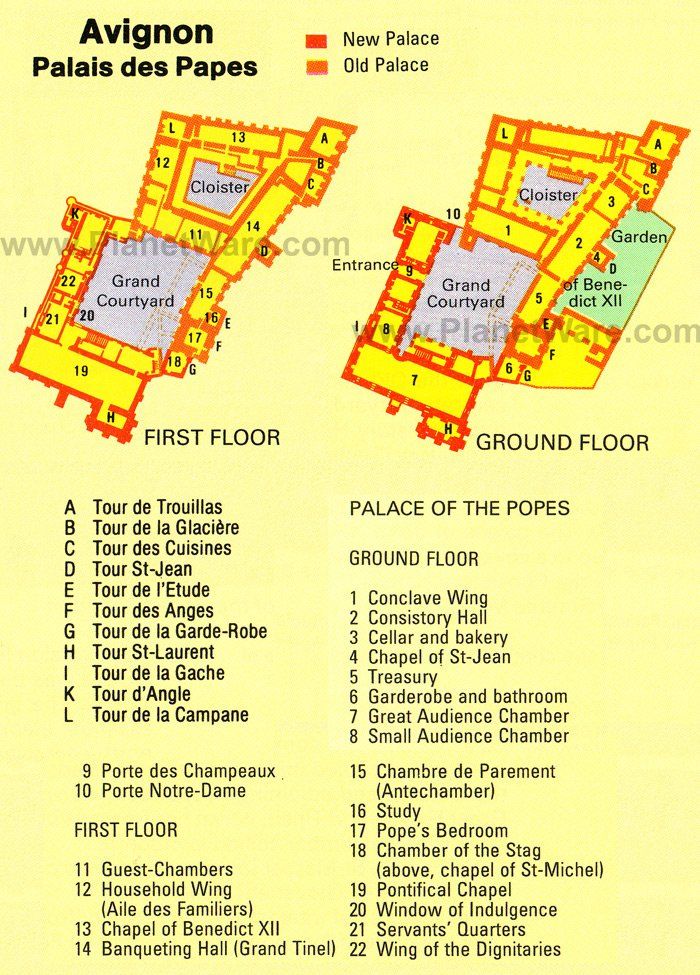
This graceful 13th-century landmark is one of Avignon's most iconic sites, and walking its length is among the top things to do in Avignon.
The Saint Bénézet Bridge is intriguing for its romantic half-ruined state and legendary association. Many are familiar with the famous song about the bridge (" Sur le Pont d'Avignon "), which was originally composed in the 16th century.
During the Middle Ages, the Pont Saint Bénézet was an essential crossing on pilgrimage routes between Spain and Italy. The bridge was used for transportation across the Rhône River until the 17th century (when the structure collapsed).
The Pont Saint Bénézet is listed as a UNESCO World Heritage Site and is open to the public as a museum. The site features multimedia displays that show how the bridge and its setting evolved over the centuries. The entry ticket includes an audio-guide. You can also admire the 13th-century Chapel of Saint Nicolas, which is part of the bridge.
A short walk from the Pont is a delightful public park, the Jardin du Rocher des Doms . Built on the Rocher des Doms hillside, this leafy English Garden, with its ponds, water pools, and terraces, provides sensational views and a refreshing environment for relaxation.
Address: Boulevard de la Ligne, Avignon
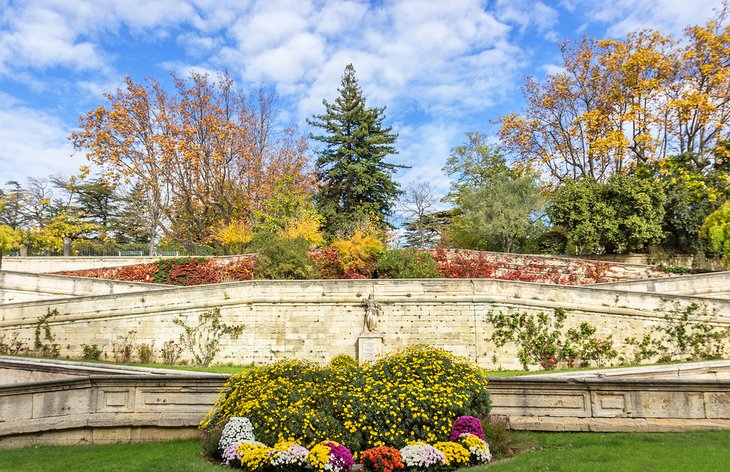
A short walk away from the Palais des Papes, the Rocher des Doms is a rocky promontory that offers an exceptional panoramic view of Avignon. This location has a gorgeous park on its summit, which is a wonderful place for a leisurely stroll.
From the gardens, you can see the Palais de Papes, the Pont Saint-Bénézet, the Rhône, and the islands of Barthelasse and Piot in the river, as well as the village of Villeneuve-lès-Avignon on the far bank.
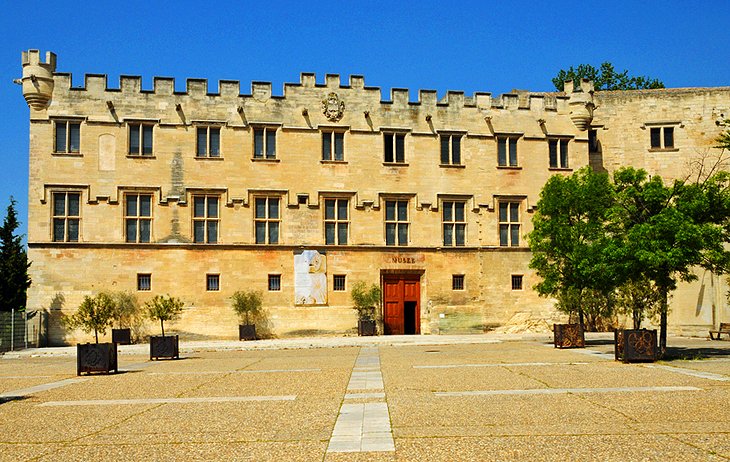
Built between the 13th and 15th centuries, the Petit Palais was the residence for Avignon's episcopal bishops before Pope Clement V created the Palais des Papes. This UNESCO-listed building was designed as a Gothic fort and is distinguished by the crenelated outer wall, a defensive feature typical of medieval and Renaissance fortresses.
The Petit Palais houses a fine arts museum with an exceptional collection of medieval art, Italian Renaissance paintings, Provençal paintings, and medieval Provençal sculptures. The collection includes masterpieces by Italian painters, including Sandro Botticelli and Louis Brea. The museum's most famous piece is Botticelli's Virgin and Child painting.
Temporary exhibits, related to fine arts topics, are held at the museum on occasion.
The Petit Palais museum has a café with outdoor seating in a quiet courtyard. The café offers a selection of tea, coffee, hot chocolate, and pâtisseries.
The museum is open year-round daily except on Tuesdays and holidays.
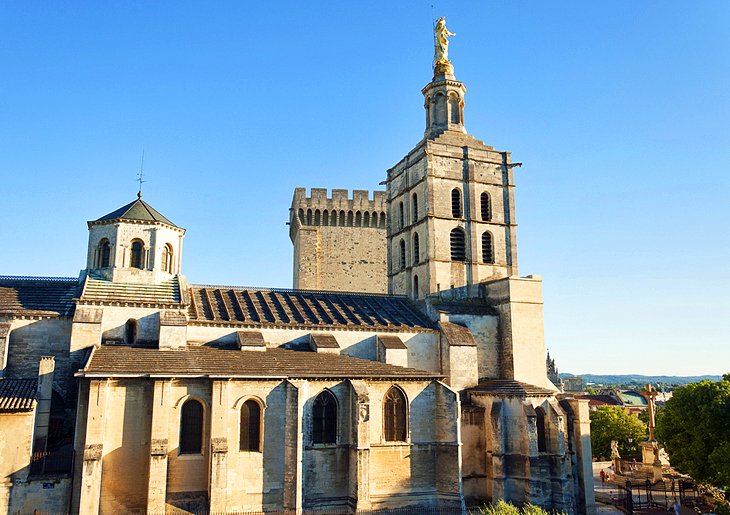
Although this building pales in comparison to the nearby Palais des Papes, the Basilique Métropolitaine Notre-Dame des Doms is still worth a visit. The monument stands on the Rocher des Doms hillside, which affords views of the Rhone Valley.
This beautiful cathedral has a serene 12th-century interior. While the nave, bell tower, and portico are Romanesque, other elements of the building were added in the 15th and 17th centuries.
Upon entering through the main doorway, you'll notice the remains of frescoes by Simone Martin. Inside the cathedral, there is an inspiring sense of space and intimacy.
The sanctuary is filled with noteworthy works of art, including a 12th-century marble bishop's chair, the Romanesque (former) main altar, the Late Gothic tomb of (pope) Jean XXII, and 15th-century frescoes portraying the Baptism of Christ.
On the cathedral's exterior, a splendid gilded statue of the Virgin crowns the tower with her hands outstretched to welcome the faithful.
The Basilique Métropolitaine Notre-Dame des Doms is open year-round daily.
Address: Place du Palais des Papes, Avignon
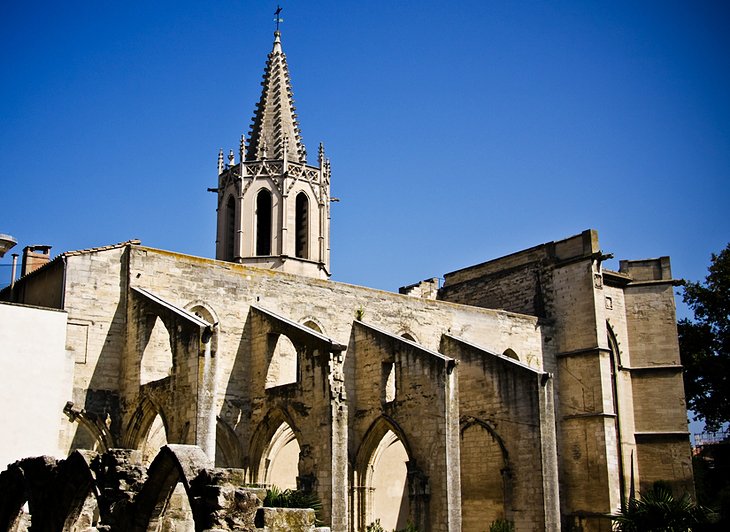
To the east of the Rue de la République stands the single-aisled Church of Saint-Didier.
Built between 1356 and 1359, the Saint-Didier Church exemplifies Provençal Romanesque architecture with its thick stone walls and large nave that gives the impression of an exceptional spaciousness.
This church contains one of France's earliest Renaissance works of art, the Way of the Cross, created between 1478 and 1481 by the Italian painter Francesco Laurana.
There are also remarkable 14th-century paintings such as the depiction of Christ's Crucifixion. Another noteworthy feature of this church is the Late Gothic pulpit with a flamboyant decoration style.
Address: Place Saint-Didier, Avignon
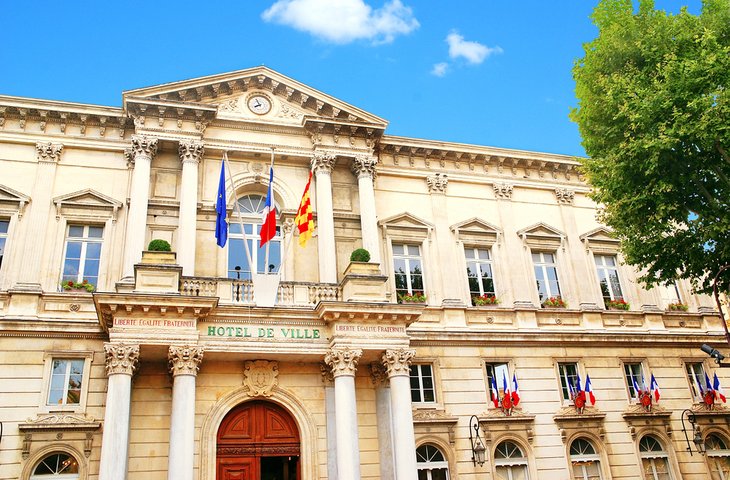
The idyllic Place de l'Horloge is a pleasant place to relax after a morning of sightseeing, at an outdoor café under the shady plane trees. Near the Palais des Papes, this beautiful square is the very center of Avignon life.
On the west side is the theater and the Hôtel de Ville (Town Hall). While the Hôtel de Ville was built in 1845, the building incorporates a charming 14th-century clock tower with life-sized figures on top, known as " jacquemarts ," that strike the hours.
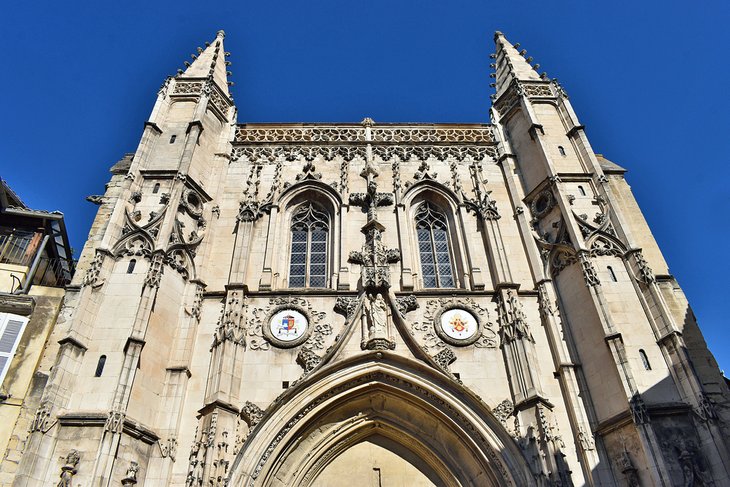
This site was dedicated to Saint Pierre of Luxembourg in the 7th century and the relics of the saint are kept here. Built in 1356, the Basilica of Saint-Pierre has a beautiful Gothic façade and carved Renaissance wooden doors dating from 1550.
The church houses several impressive sculptures, as well as paintings by Simon de Châlons, Parrocel, and Nicolas Mignard. There are also splendid Baroque choral scenes from the mid-17th century.
Classified as a Historic Monument , the Basilique Saint-Pierre is open to the public for visits daily year-round, free of charge.
Address: Place Saint-Pierre & Place des Châtaignes, Avignon
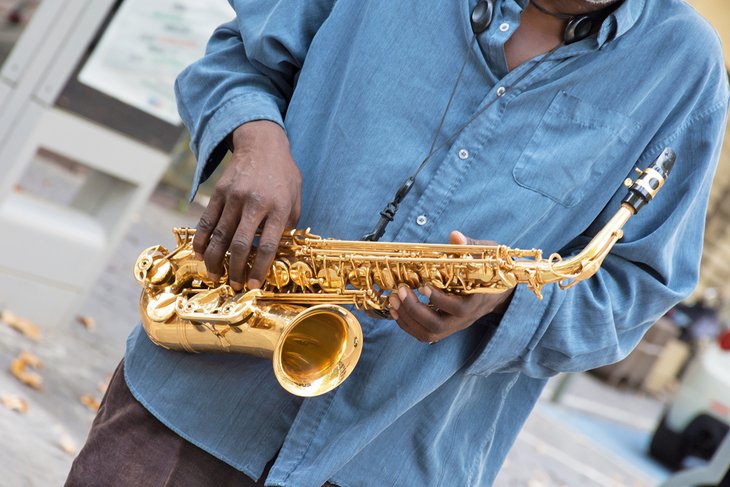
Avignon hosts dozens of cultural events and festivals throughout the year.
One of the biggest summertime events in Provence, the Festival d'Avignon presents a diverse cultural program that offers plenty of things to do, including theater productions, film screenings, dance performances, lectures, book readings, and workshops. The festival begins in early July and includes several events every day for over two weeks. Events are held at various indoor or outdoor venues throughout the city.
One of the most well-attended festivals is the Avignon Jazz Festival in late July and early August that takes place at the atmospheric Cloître des Carmes courtyard. This happening event is known as a "launching pad" for up-and-coming jazz musicians from all over Europe.
Other highlights of the cultural events calendar are the Agricultural Festival , which showcases products from farms of the region; the Médiévales des Carmes (a medieval festival that's free of charge) held on the second weekend of September; the Parcours de l'Art - Contemporary Art Festival in October; the Blues Rock Festival , in the nearby own of Châteaurenard, in October; and a Christmas market in December.
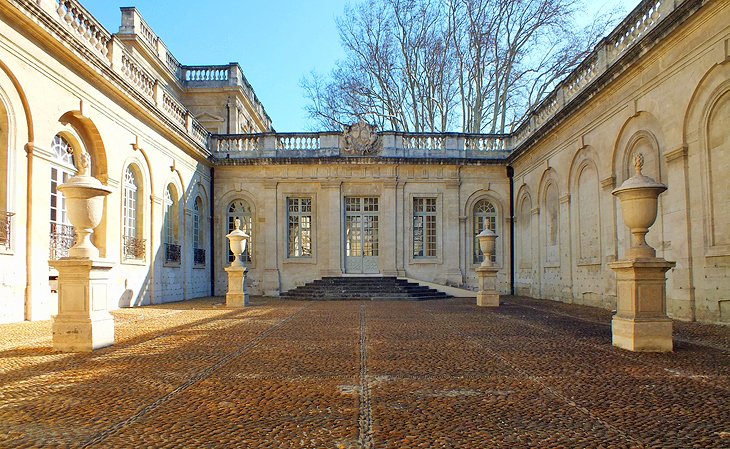
The Musée Calvet has a wonderful collection of antique sculptures, medieval paintings by Provençal masters, Italian paintings from the 16th to 19th centuries, French paintings from the 16th to the 20th centuries, as well as a selection of Spanish and Dutch works.
The museum began as the private collection of the doctor, a native of Avignon, Francois Esprit Calvet. Since 1833, the museum has been housed in the 18th-century Hôtel Villeneuve-Martignan near the Place de l'Horloge.
Address: 65 Rue Joseph Vernet, Avignon
Most tourists enjoy staying right in the historic center of Avignon, near the Palais des Papes and the Place de l'Horloge. Some of the more affordable hotels are near the railway station, about a 10-minute walk from the Place de l'Horloge. We recommend these highly rated hotels in Avignon:
Luxury Hotels:
- In an ideal location at the center of Avignon, the elegant five-star Hôtel d'Europe is a short walk from all the top attractions. The hotel occupies a renovated 16th-century mansion and has a Michelin-starred restaurant.
- La Mirande hotel has 26 exquisitely decorated rooms in a sumptuous 18th-century townhouse overlooking the Palais des Papes. This five-star hotel has a Michelin-starred fine-dining restaurant and a lounge where afternoon tea is served. Guests may choose to participate in the hotel's cooking classes.
- An upscale contemporary-style hotel, the four-star Hôtel de l'Horloge is steps away from the Place de l'Horloge, close to dozens of cafés and restaurants. Some of the guest rooms feature terraces.
Mid-Range Hotels:
- The Hôtel Garlande is found in a charming pedestrian area, at the center of Avignon, near the Eglise Saint-Didier. This three-star hotel occupies a renovated 18th-century building; guest rooms feature chic contemporary-style décor.
- The four-star Hôtel Mercure Pont d'Avignon Centre is about a five-minute walk from the Pont Saint Bénézet. The hotel's contemporary-style guest rooms are outfitted with flat screen televisions and coffeemakers.
- The cheerful rooms at the three-star Kyriad Avignon - Palais des Papes have pleasant views; some rooms overlook the Place de l'Horloge. Guests will appreciate the convenient location near many restaurants and cafés.
Budget Hotels:
- Mid-way between the train station and the Place de l'Horloge, the three-star Hôtel Central Avignon is a short walk away from the Palais des Papes. The hotel has a garden courtyard where breakfast is served.
- The Hôtel Le Colbert is tucked away on a quiet street between the railway station and the Place de l'Horloge. This two-star " hôtel de charme " features a shaded outdoor patio (where the continental breakfast is served) and quaint rooms but no elevator.
- The three-star ibis Avignon Centre Gare is just across from the Avignon train station and near the town's ancient ramparts. Guest rooms are compact but stylish and modern. Hotel amenities include a restaurant, 24-hour front desk reception, and a breakfast buffet.
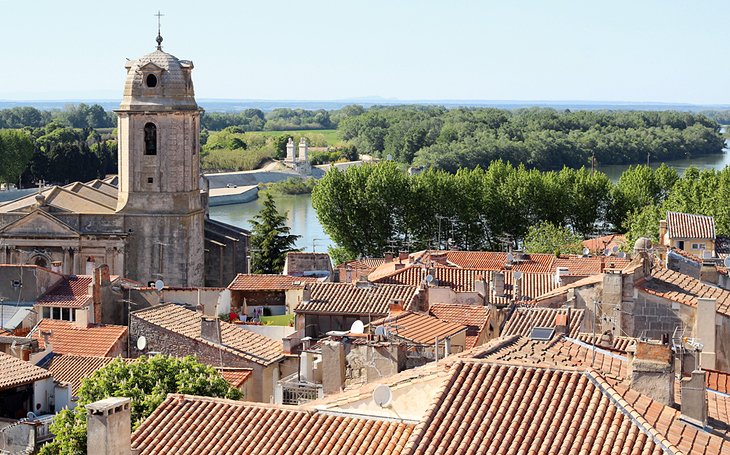
Only a 20-minute train ride from Avignon, Arles is a typical Provençal town, with a slow-paced lifestyle, pleasant outdoor cafés, and fascinating historic sites.
The highlights of Arles include a well-preserved 1st-century Roman Amphitheater and a UNESCO-listed Romanesque church.
For art lovers, the Fondation Vincent van Gogh is not to be missed, along with the Van Gogh Self-Guided Walking Tour , which identifies the landmarks captured in Vincent van Gogh's vivid brushstrokes.
Those who appreciate Vincent van Gogh's artwork will also enjoy the Van Gogh in Provence Small-Group Day Trip from Avignon . This unique tour stops at the sites in Arles and Saint-Rémy-de-Provence that are pictured in some of Van Gogh's most famous paintings.
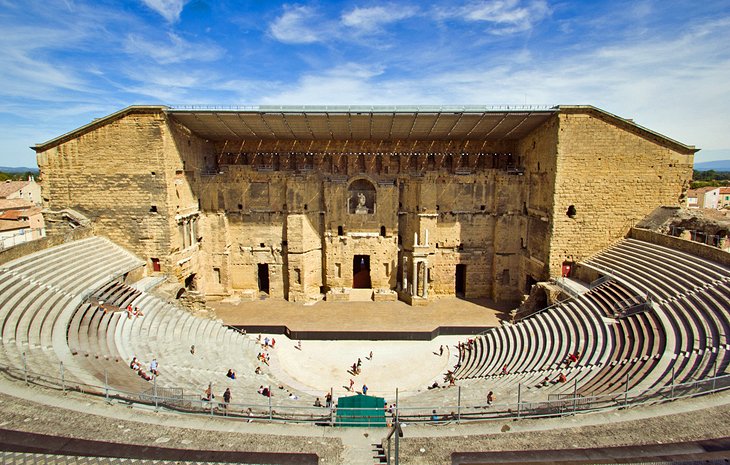
During ancient times, the area that is now Provence was home to a thriving Roman colony with bustling towns. Many of the Roman monuments have survived intact, such as the remarkable Roman Theater in the UNESCO-listed town of Orange that has seating for an audience of 7,000 people.
An array of well-preserved Roman monuments also await in Nîmes , a cultured town with an appealing old-world ambience. More fascinating archaeological sites are found in Vaison-la-Romaine : the remains of Roman porticoed houses, exquisitely detailed mosaics, and paved streets featuring gutters.
The sophistication of classical-era Roman civilization is perhaps best seen in the UNESCO-listed Pont du Gard aqueduct , a masterpiece of civil engineering that extended for 50 kilometers to supply water to the region.
The best way to see some of these amazing sites is by taking an organized tour. The Roman Sites Small-Group Day Trip takes travelers to the impressive ancient sites of Nîmes while sharing stories of Roman history and culture. This tour also stops at the UNESCO-listed Pont du Gard and the medieval town of Uzès, at the border of Provence in the Languedoc-Roussillon region .
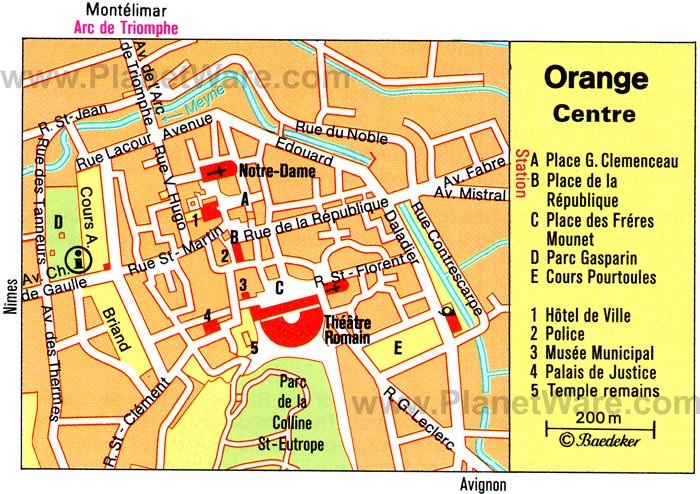
With its vibrant lavender fields and picturesque medieval hilltop villages, the Luberon is an appealing off-the-beaten-track destination in the Haut-Vaucluse area of Provence.
This idyllic rural area is protected as a UNESCO-listed nature reserve and is only accessible by car.
For an easy way to discover this lovely corner of Provence, take the Full-Day Highlights of Provence Tour from Avignon . This tour includes visits to the perched villages of Gordes and Roussillon, along with a stop at the spectacular fortified town of Les Baux de Provence.
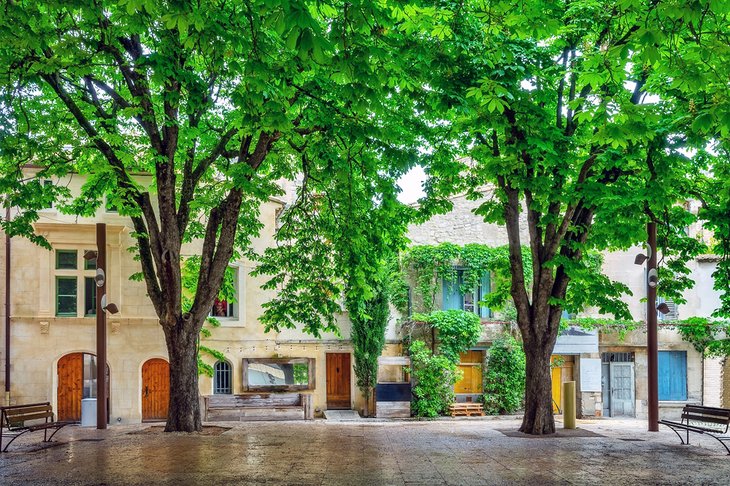
One of the sites that inspired Vincent van Gogh, Saint-Rémy de Provence is a characteristic Provençal village with elegant buildings, pleasant squares, and charming pedestrian streets.
About 20 kilometers south of Avignon in the northern foothills of the Alpilles, this village offers stunning views of the countryside.
Saint-Rémy de Provence is also well known for the Glanum Excavation Site where ruins from the ancient Graeco-Roman town are found. This extensive archaeological site includes the Monumental Gate from the 1st century BCE and a monument in memory of Julius Caesar.
Another famous person associated with the village is Nostradamus , who was born in Saint-Rémy in 1503. Admire the peaceful fountain that features a bust of Nostradamus.
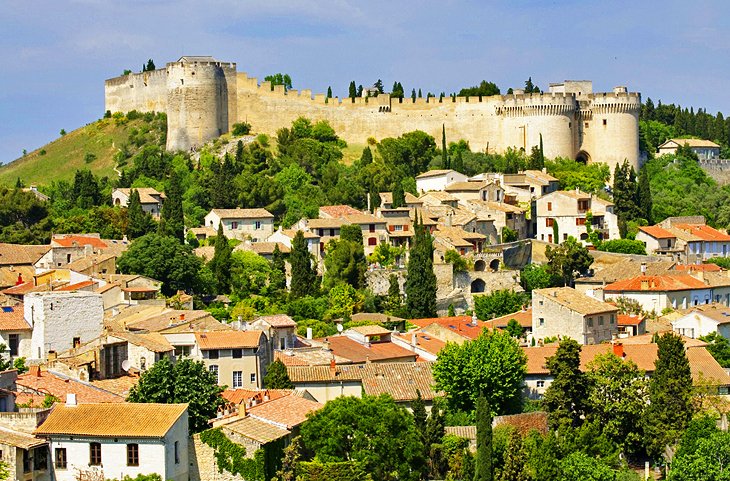
An easy 10-minute drive from Avignon, the village of Villeneuve-les-Avignon has a fascinating medieval fortress.
Built in the 13th and 14th centuries, the Fort Saint-André sits atop Mont Andaon and offers a magnificent view of Villeneuve, Avignon, Mont Ventoux, and the Lubéron and Alpilles mountain ranges.
The village also has an outstanding museum, the Musée Pierre-de-Luxembourg on the Rue de la Republique. One famous piece is the Coronation of the Virgin Mary , painted by Enguerrand Quarton in 1453. There are also noteworthy 17th-century paintings by great masters, including Philippe de Champaigne, Nicolas Mignard, and Reynaud Levieux.
Also worth visiting is the Chartreuse du Val de Bénédiction chapel built in 1352. The Gothic tomb of Pope Innocent VI lies within the chapel and a beautiful cloister adjoins the church.
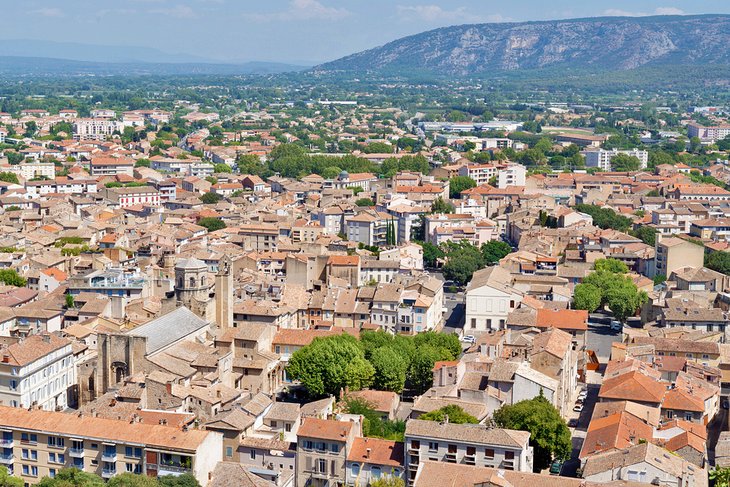
The little provincial town of Cavaillon has a rich cultural heritage, revealed in its remarkable historic monuments.
The Cathedral of Saint-Véran, founded around the 12th century, exemplifies Romanesque Provençal architecture. Its exterior is rather less attractive, but inside are lovely decorative capitals in the apse and a fine cloister.
Cavaillon also has a beautiful synagogue on the Rue Hébraïque (near Place Castil-Blaze) that is easily recognized by its arcades. Built in the Rococo style in 1772, the synagogue was later altered on many occasions. The synagogue now houses the Musée Juif Comtadin .
The Hôtel Dieu Archeological Museum on the Place Jean Bastide exhibits artifacts mainly from the Gallo-Roman period, along with Gallo-Greek antiquities and medieval items including a Merovingian altar-table. One room contains some interesting items of equipment from the old hospital dating from the 17th and 18th century.
A ticket to the Archeological Museum includes admission to the Judeo-Comtadin Museum in the historic synagogue on the Rue Hébraïque.
This sun-drenched town is surrounded by melon-growing farms. As would be expected, Cavaillon has a wonderful melon festival in early July.
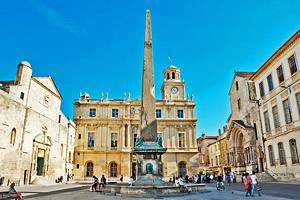
Highlights of Provence : Avignon is a great starting point to explore the many other interesting historic towns of Provence . The ancient ruins, leafy town squares, and outdoor cafés (painted by Van Gogh) of Arles are just 45 minutes away by train. Aix-en-Provence , another quintessential Provençal town, is one hour away by car or one hour and 30 minutes by train.
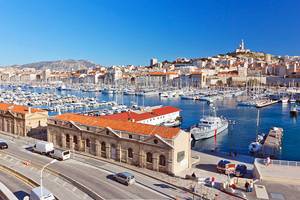
Seaside Splendor and Sunny Towns : The bustling seaport and cosmopolitan town of Marseilles is only 30 minutes away on the TGV fast train (or one hour by car). Many attractions near Marseilles are also worth a detour, such as the quaint fishing village of Cassis and the quintessentially Provençal town of Aix-en-Provence.
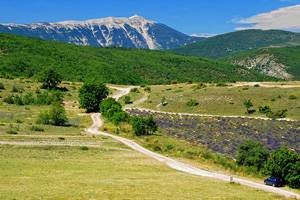
Charming Countryside : Travelers with more time will enjoy exploring the Lubéron area of Provence's Haut-Vaucluse countryside (about an hour's drive away), with its charming hilltop villages and picturesque landscape of rolling hills, valleys, and peaceful farmlands. The iconic Mont Ventoux in the Haut-Vaucluse is the highest mountain peak in Provence.
More on France


Things to do in Avignon
Discover the places and activities not to be missed

Avignon, the Popes’ city Looking for a picturesque, vibrant, and historically rich destination in France? Look no further than Avignon! Nestled in the heart of Provence, this enchanting city is a must-visit for travelers seeking an unforgettable experience. With its breathtaking architecture, charming cobblestone streets, Avignon is a true gem waiting to be explored.
- Pont d’Avignon
The Popes’ Palace
Doms garden, on the other side of the rhône.
From the iconic Palais des Papes, a UNESCO World Heritage site, to the vibrant local markets bursting with aromas of fresh produce and fragrant herbs, Avignon offers a unique blend of culture, art, and gastronomy. Immerse yourself in the vibrant atmosphere of the Avignon Festival, the largest theater and performing arts event in the world, or wander through the quaint streets, discovering hidden cafes and boutique shops. Whether you’re a history buff, a food enthusiast, or simply seeking a romantic getaway, Avignon is sure to captivate your senses and leave you longing for more.
Pont d’Avignon
As the famous French song goes… “on y danse, on y danse”… But there’s so much more to discover! The world-famous Pont d’Avignon, or Pont Saint-Bénézet , is often the starting point for exploring the city’s historic centre. Although today it no longer joins the two banks of the Rhône, the bridge offers a pretty view of the city of Avignon and the Rocher des Doms. A great chance to snap some photos of the Popes’ Palace before venturing into the old town!
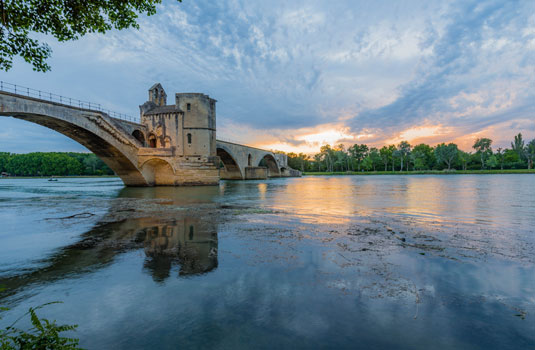
Did you know?
The Pont d’Avignon received the “Tourisme et Handicap” label (recognition of reliability and quality of tourist service to disabled persons) in 2016.
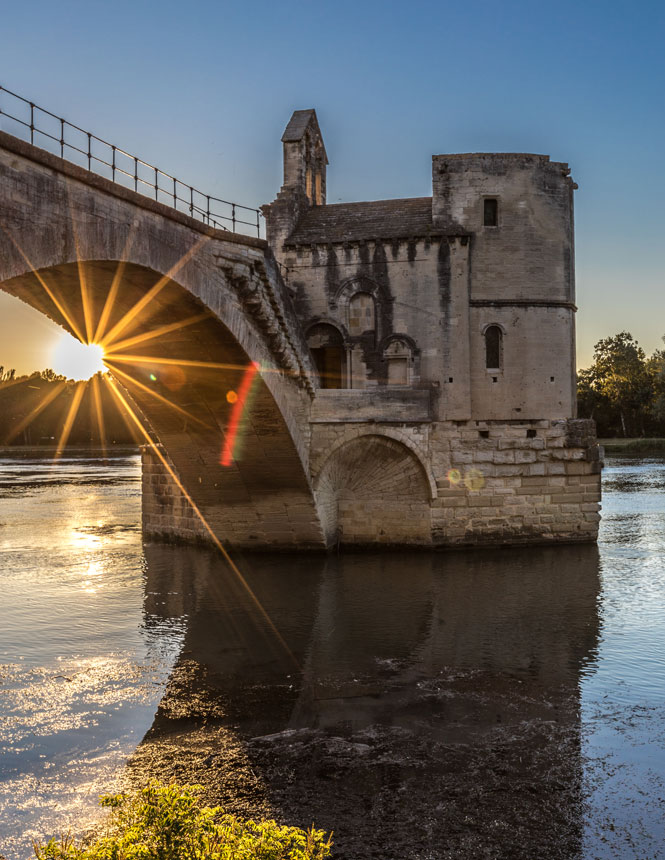
It’s impossible to talk about Avignon without mentioning the celebrated Popes’ Palace, listed as UNESCO World Heritage site
Given the Palace’s colossal size, looming over the town, it’s perhaps no surprise that this is the biggest gothic palace in the world. Definitely a must-see! Once inside the Palace, choose between a themed guided tour or freely wander around, accompanied by a digital tablet so you don’t miss anything! From the Pope’s private apartments to the frescos painted by the artist Matteo Giovannetti, the Popes’ Palace is an immense playground for lovers of architecture and history.

Firm favourite
Relive the grandeur of the Popes’ Palace thanks to the Histopad – an augmented reality tablet – included in the price of each ticket!
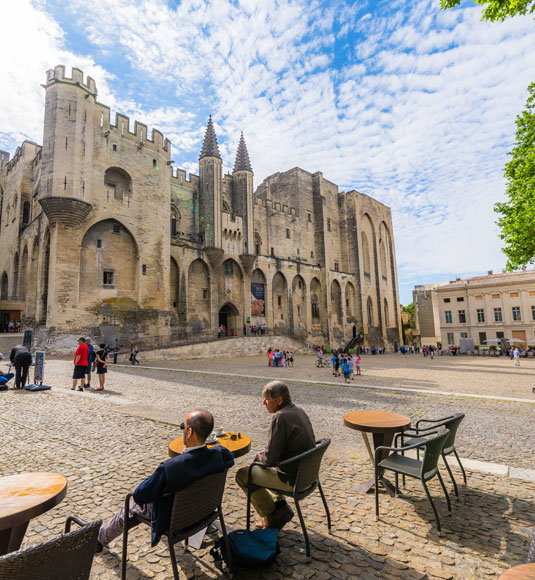
With more than 600,000 visitors per year, the Popes’ Palace is one of the 10 most visited monuments in France. An unmissable part of Avignon!
An ideal place for a stroll, go to the Doms Garden to recharge your batteries and take a refreshing break on hot summer days.
At the weekend, go for a walk as a family, as a couple, whether you’re particularly sporty or you simply want to admire the landscapes. Several spots offer a magnificent view over the surroundings, from the Rhône plain up to Mont Ventoux – it is a beautiful Provençal scene! Another great idea is to stroll around the side of the lake – children will be amazed by the swans and carps and will surely want to stop and have a look, ice cream in hand!
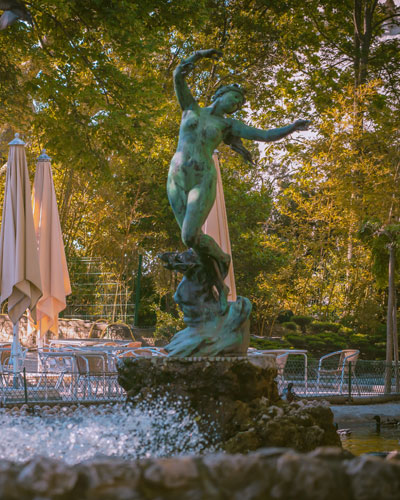
Take the little train to get to Doms Garden – even the journey up to the garden is a lovely experience which will delight both children and parents.
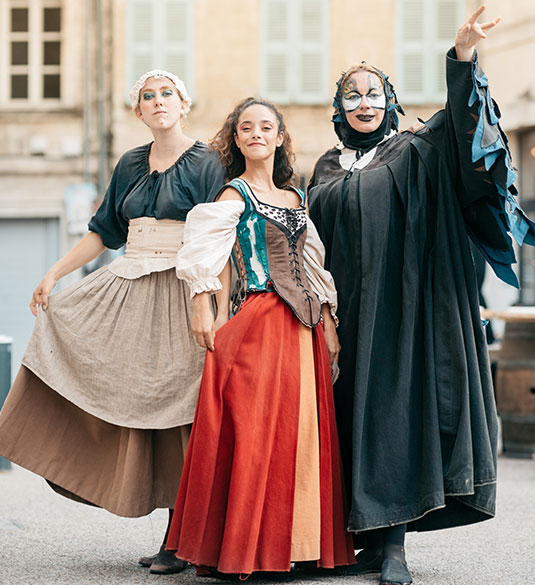
The festival d’Avignon
One city, 2 festivals, more than 1,000 performances.
Since 1947, the world of theatre and live performance has come together in Provence for 3 weeks every July. The city becomes one big stage – from pavements to cinemas, from gardens to the main courtyard of the Popes’ Palace – a whirlwind of colours, languages, and styles. African dance mixing with Chinese theatre, renowned literary authors mingling with contemporary comedians… It’s clear that the Avignon Festival is one of a kind!
By crossing the bridge which spans the Rhône (Daladier, not the Pont d’Avignon, as you may have realised…) the day continues in Villeneuve-lès-Avignon, a medieval-looking village with an impressive, dominant fort on the Mont Andaon. Only a few kilometres from Avignon, this military architectural masterpiece boasts a stunning view of the Mont Ventoux, the Alpilles and the Luberon. Further down – in the heart of the village – is La Chartreuse. Founded by Pope Innocent VI, today this is a cultural centre and artists’ residence which welcomes visitors curious to discover the monastic atmosphere in the cloisters, the 40 cells and the chapel.
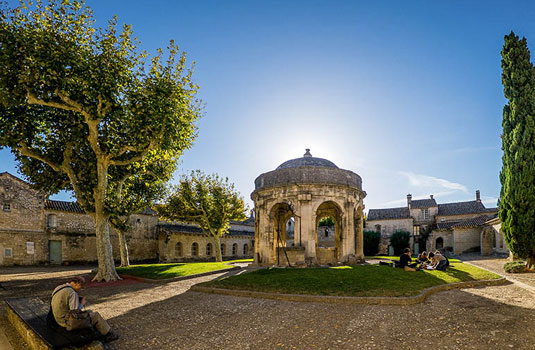
Another unmissable gem: the Abbey of Saint-André and its gardens, which boast a fantastic view over the Popes’ Palace and the Rhône valley. These romantic gardens are home to a range of different areas: tuscan-style flowerbeds, a one-hundred-year-old olive grove, panoramic patios…
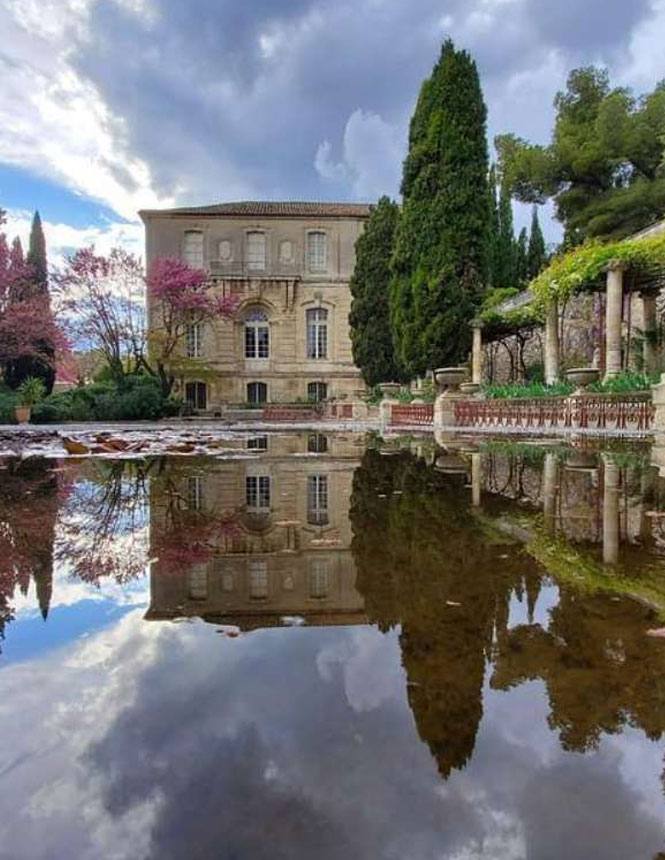
Outdoor activities in Avignon and surrounding areas
Avignon’s natural surroundings offer ample opportunities for outdoor activities and exploration.
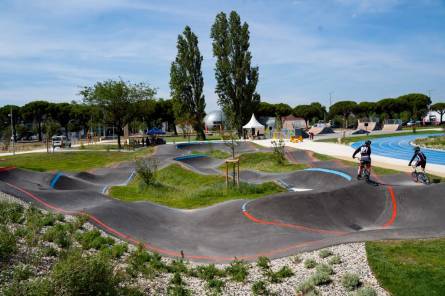
Pumptrack de la Plaine des sports Avignon
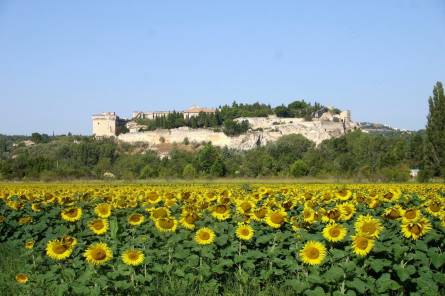
La Rive droite du Rhône-balade à vélo-50 Villeneuve-lez-Avignon
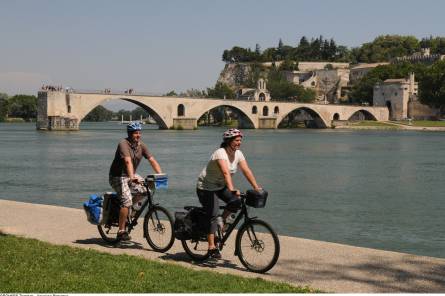
Bike ride on Barthelasse Island – Countryside in the city Avignon

L’Île de la Barthelasse-balade à vélo-4 Avignon
Itinerary ideas.
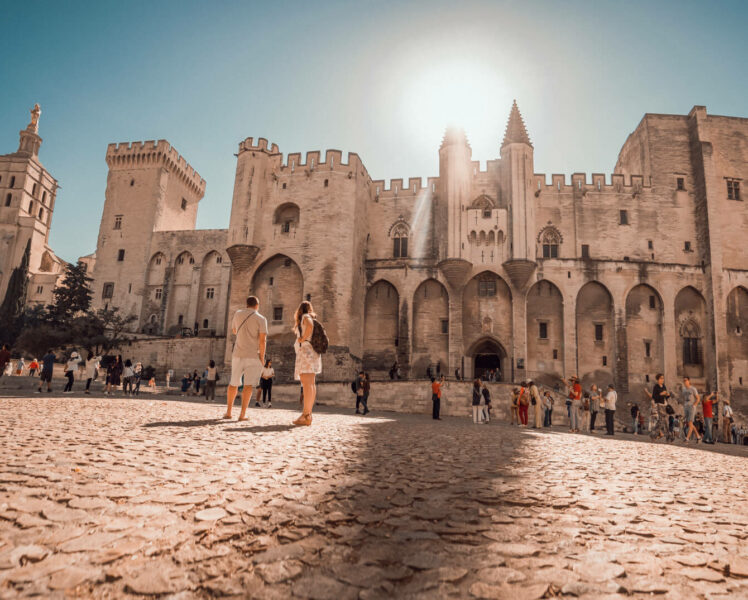
Avignon in the time of the Popes
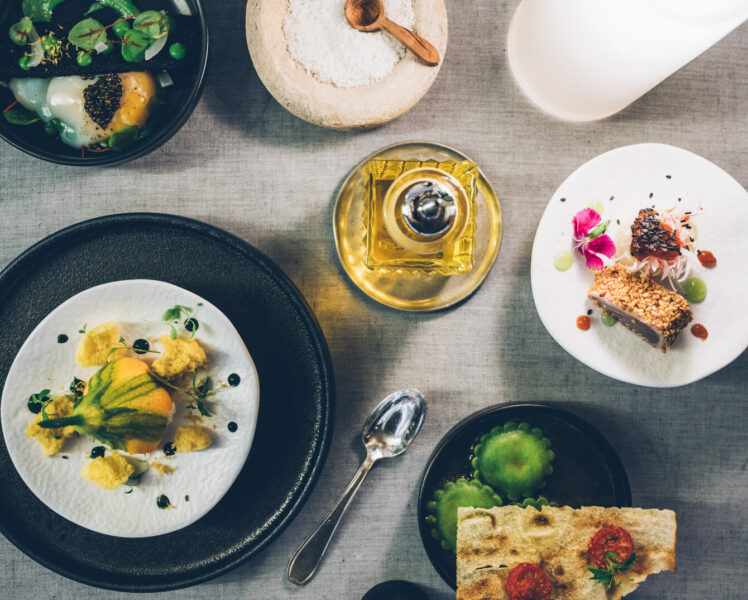
Avignon for food lovers
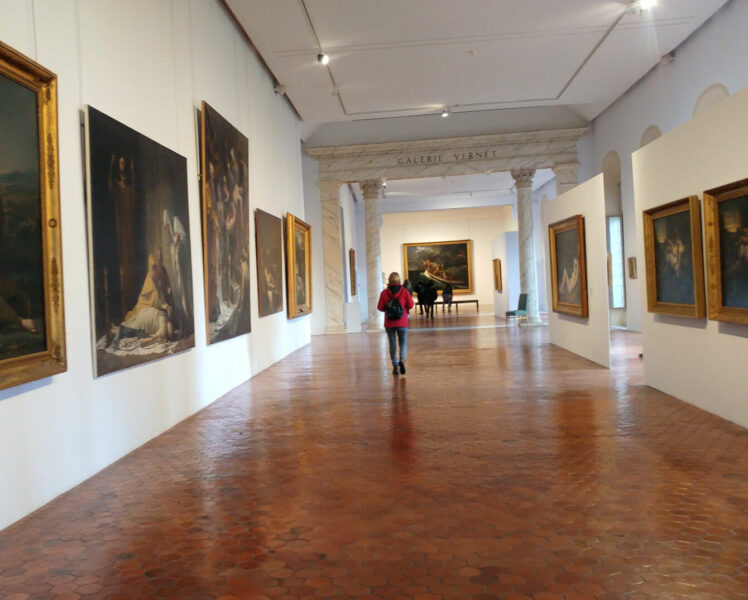
The cultural side of Avignon
Planning your visit to avignon.
When planning your visit to Avignon, it’s important to consider the best time to go. The summer months of June to August are the peak tourist season, with warm weather and a bustling atmosphere. However, these months can also be crowded, so if you prefer a quieter experience, consider visiting in the shoulder seasons of spring or fall. Avignon is well-connected by train, making it easy to reach from major cities in France. Once you arrive, the city is compact and easily walkable, making it convenient to explore on foot. There are also several options for accommodation, ranging from luxury hotels to budget-friendly guesthouses. Whether you’re planning a short weekend getaway or a longer stay, Avignon is sure to enchant you with its beauty and charm.
Practical information
Access Direct TGV (high-speed train) to Avignon from – Paris Gare de Lyon by TGV (2 hours 38 mins) – Roissy Charles de Gaulle by TGV – Lille– Nantes – Rennes – Strasbourg – Nice – Geneva (3 hours) – London by Eurostar (6 hours) More information: www.sncf-connect.com Prepare your journey: www.thetrainline.com
Paid parkings: Parking du Palais des Papes , parking des Halles et parking Jean Jaurès Free parkings: île Piot , Parking des italiens
Public transport Orizo is the public transport company in Avignon ORIZO Shop Avenue de Lattre de Tassigny 84000 AVIGNON – 04 32 74 18 32 Monday to Friday 8am to 12:30pm and 1:30pm to 6pm and Saturday 9am to 12pm
The Pont d’Avignon through the seasons
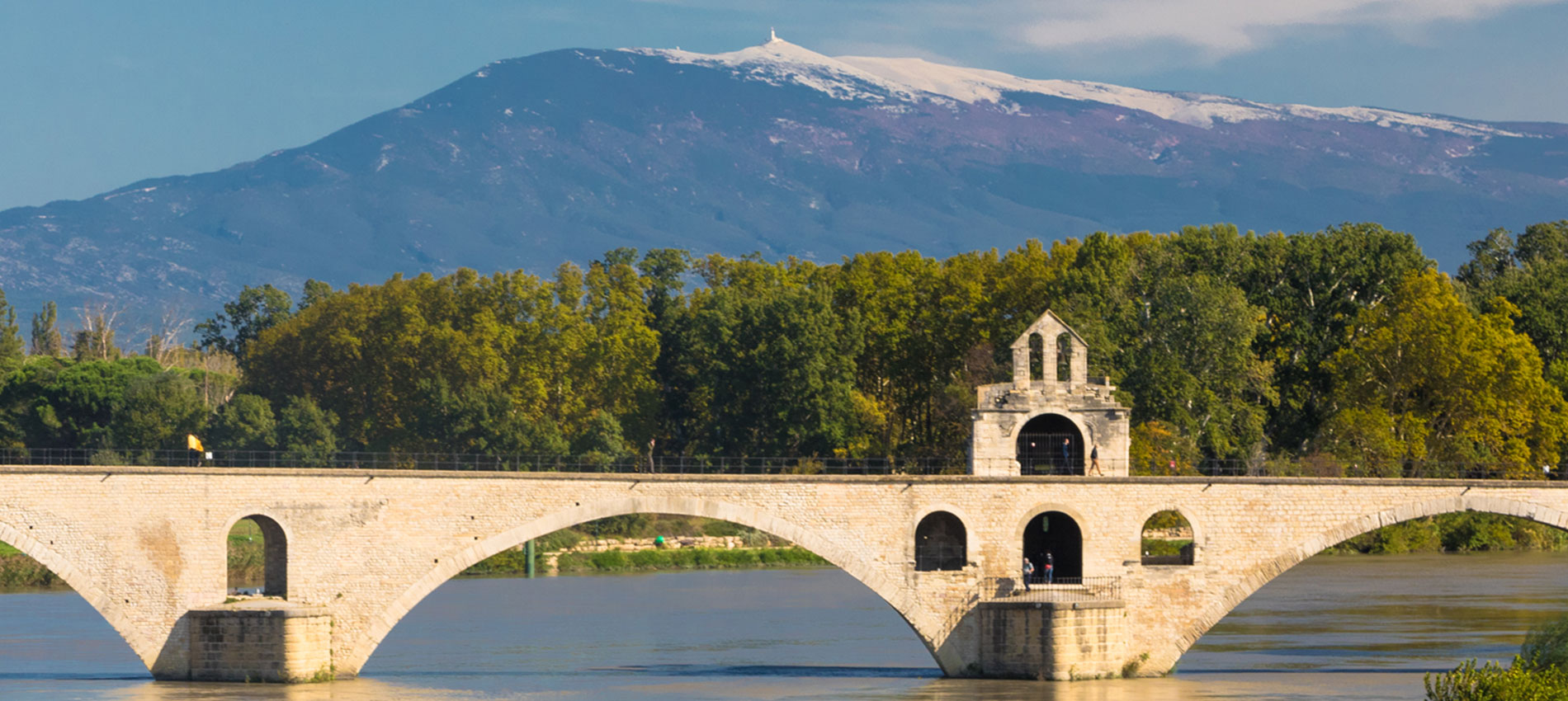
- Search Please fill out this field.
- Manage Your Subscription
- Give a Gift Subscription
- Sweepstakes
How to Plan the Perfect Trip to Avignon, France
This enchanting French city is home to a historic palace, delicious food, and one of the oldest hotels in the country.
Lindsay Cohn is a writer, editor, and avid traveler who has visited 45 countries across six continents — and counting. She contributes to Travel + Leisure, Hotels Above Par, InsideHook, Well+Good, The Zoe Report, and more.
:max_bytes(150000):strip_icc():format(webp)/Lindsay-Cohn-8b22fb2d452f46f5a256755f4d0f42a5.jpeg)
A must-visit on any trip to the south of France , Avignon oozes history and culture. Set on the Rhône river, it’s best known for the enormous Palais des Papes (Popes' Palace), which reflects its pinnacle as the seat of the Catholic papacy in the 14th century. However, the ever-enchanting city actually dates back to Roman times and also possesses plenty of other photogenic attractions such as Rocher des Doms and Pont Saint-Bénézet.
A delicious destination to say the least, it’s home to a storied Provençal market, as well as many superb restaurants, from haute French dining to neighborhood bistros. Character-rich accommodations also await travelers after sightseeing and savoring. With direct trains from Paris, many travelers use Avignon as a springboard to explore the rest of Provence. But it’s certainly worth spending a few days here.
Gatsi/Getty Images
To help you plan the perfect trip to Avignon, we tapped three travel experts who also happen to be full-blown Francophiles to get the inside scoop on the best things to do in the capital of the Vaucluse department.
Top 5 Can’t Miss
- Visit the massive Palais des Papes (Popes' Palace) for a glimpse into the city’s papal history.
- Get a taste of local life at Les Halles d'Avignon.
- Snooze in classical French style at Hôtel La Mirande.
- Sample Provençal cuisine at a Michelin-rated restaurant or a cozy corner bistro.
- Sip and swirl world-class red wine in nearby Chateauneuf-du-Pape.
Christophe Bielsa
Best Hotels and Resorts
Hôtel la mirande.
Located right next to the Palais des Papes, Hôtel La Mirande is a five-star respite with a lovely atmosphere and rooms decorated in classical French style. “I love the underground space for cooking classes and private dinners ... as well as the cozy fireside bar for afternoon tea in the winter,” says Florence Gaudin, product manager at French Side Travel and on-the-ground guide partner for Black Tomato .
Auberge de Cassagne & Spa
For a refuge that’s just a short drive outside the city center, set your sights on Auberge de Cassagne & Spa . “A gorgeous Provençal house-turned-hotel with 35 impeccably decorated rooms, excellent spa facilities, a superb fine-dining restaurant, and beautiful gardens, it really feels like a luxury countryside retreat and is always a winner with our most discerning clients,” says Graham Carter, co-founder of Unforgettable Travel Company and leading France specialist.
La Divine Comédie
“My go-to suggestion for travelers who want a boutique stay that’s right in the heart of Avignon, La Divine Comédie took nearly seven years to rebuild,” says Carter. “Gilles, a stylist from Paris, and his partner, Amaury, converted a derelict building into a beautiful five-key, homestay-style property.” Each bedroom is individually styled and full of character with dozens of hand-picked art pieces and decorative accents.
Hotel d'Europe
One of the oldest hotels in France, Hotel d'Europe traces its roots back to the 16th century. Since then, it has been lovingly refurbished, but still retains a timelessness and enduring sense of regality. Travelers remark about the genuine hospitality and sophisticated decor. The shaded terrace is a lovely spot for a cocktail during the warmer months. And you can’t beat the location, just steps from the old city walls and Palais des Papes.
Buena Vista Images/Getty Images
Best Things to Do
Palais des papes.
Surrounded by medieval stone ramparts, the Palais des Papes (Popes' Palace) is a fortress and palace that served as the papal residence for most of the 14th century. Whether you’re interested in the religious or historical aspects of the UNESCO-listed site, it’s worth visiting to see one of the most emblematic landmarks in all of France.
Les Halles d'Avignon
A great place to get a taste of local life, Les Halles d'Avignon is a historic indoor market with many vendors selling traditional local products. Jason Susinski, director of product for Kensington Tours and Provence expert, encourages visitors to browse the selection of fresh produce, meats, cheeses, seafood, and baked goods. It also has a lovely vertical garden and cafes to stop for a coffee break in between shopping.
Oleg Anisimov/500px/Getty Images
Musée du Petit Palais
While most of the tourist attention focuses squarely on the Palais des Papes, it’s far from the only cultural attraction worth checking out in Avignon. First opened in 1976, Musée du Petit Palais boasts an impressive collection of Renaissance paintings, from local papals to those brought by Italian clergy.
Rocher des Doms
Lace up your hiking boots (though sneakers will certainly suffice) and get outside to soak in the panoramic views from Rocher des Doms, a peaceful park with gardens, fountains, and a privileged vantage point overlooking the city, river, and famous Pont Saint-Bénézet.
Châteauneuf-du-Pape
While there’s lots to do in Avignon itself, fans of old-world vin won’t want to miss the chance to sip and swirl the nectar of the gods on a day trip to nearby Châteauneuf-du-Pape (about 25 minutes away). One of the most well-known wine regions in all of France , it’s famous for producing top-quality reds and brims with many charming vineyards for tastings.
trabantos/Getty Images
Best Restaurants
Hiély lucullus.
One of the best restaurants in Avignon, Hiély Lucullus blends the cuisines of Provence and Peru in a deliciously creative way. The flavors and soul of both places come to life through tasting menus. Because it’s popular and books out so far in advance, Carter recommends securing a reservation well ahead of your trip.
Fou de Fafa
Looking for something a bit more laid-back that’s still guaranteed to be memorable and downright delicious? Fou de Fafa never disappoints. It’s casual and inviting, with homespun charm, elegant dishes, and a lovely terrace for an alfresco dinner.
Another resplendent option for lunch or dinner, and a favorite of Gaudin's, Avenio treats patrons to delectable plates like a goat cheese tart with smoked duck breast and an herb-crusted baked cod that channels the legacy of Provençal cuisine while bringing something new to the table. The setting is chic and modern yet relaxed. Not surprisingly, the tables book up fast.
La Fourchette
La Fourchette is an elegant neighborhood bistro serving traditional recipes like smoked haddock salad, curry fried oysters, and ratatouille made with seasonal ingredients. Photographs, books, and wood inject the space with heaps of warmth and personality.
Foodies and history buffs both flock to Sevin in equal measure. Set in a medieval residence next door to the Palais des Papes, it’s a historic gem for contemporary eats. If the weather and availability allow, try to snag a table on the terrace. And don’t forget to peruse the wonderful wine list.
Aleh Varanishcha/Getty Images
Best Time to Visit
While many travelers pack Avignon into a summer Provence itinerary, Gaudin is partial to the months of May, June, September, and October because of the great weather (it’s less hot than peak summer). Plus, you still get the advantage of long, sunny days to roam and explore. March and April tend to be quiet — with the exception of the week leading up to Easter — so it’s a good option if you’re looking to avoid the crowds and save a few bucks.
How to Get There
High-speed, direct trains run from Paris to Avignon throughout the day. The journey takes about two hours and 30 minutes and costs $62. You can easily pick up a rental car from Sixt at the Avignon TGV train station (Gare d'Avignon TGV) to explore beyond the city, too. International flights also land at Marseille Provence Airport (MRS), which is about 90 minutes away.
anamejia18/Getty Images
How to Get Around
It’s easy to navigate Avignon on foot. With so much to see and do in the surrounding countryside of Provence — from wineries and olive oil mills to lavender fields and medieval villages — Susinski recommends arranging a private guided tour to gain entry into some local experiences or renting a car to explore at your leisure.
Avignon travel guide

Visit Avignon (Provence-Alpes-Côte d'Azur, France)
Avignon is a historic town on the Rhone river in Provence, and a beautifully preserved medieval town surrounded by the original fortified city walls. The part of Avignon that is of most interest to visitors falls inside the fortifications and is called the intra-muros quarter, and the bridge (the Pont d'Avignon) which is just outside the walls.
The central historical part of the city, including the Palace of the Popes, the Saint-Benezet bridge, and the fortification walls that surround the city, is now a protected UNESCO heritage site and Avignon is also listed as one of the French 'secteur sauvegardé' towns (see Historic towns of France ).
Exploring Avignon
France This Way review: we recommend you allow two or three days to visit Avignon. Although you could perhaps visit the principal monuments in the town in a one day visit, you will discover there is a lot to enjoy and you will also want to spend time in one or two cafes and restaurants!
There is much more to Avignon than famous sites, and during a visit you will see a wealth of beautiful buildings, historical churches, a fine collection of museums, several gardens, an extensive pedestrianised historic center, and lots of cafes and bars.

The heart of Avignon for visitors has the Palais des Papes and the Place de l'Horloge to the north, the Pont d'Avignon just outside the city walls to the north-west of the Palace, and the main historic centre in the streets around the Palace and the Rue de la Republique, which is a long boulevard to the south of the Place de l'Horloge.
Many visitors will start a visit in the Place de l'Horloge and the large open area in front of the Pope's Palace, but note that the main Avignon Tourist Office is at the southern end of Rue de la Republique, several hundred metres south of the Place de l'Horloge, and has a great deal of useful information and maps to help you make the most of your visit - so we would also make that a priority! Among these are three suggested routes to explore the centre:
- the Promenade des Papes, that explores the streets around the Palais des Papes, the Pont Saint-Bénezet and the Rocher des Dome Park: an indispensable route that takes about an hour (excluding entry to the two monuments)
- the Promenade of the Museums and Townhouses, in the Place de l'Horloge and the streets such as Rue Joseph Vernet and the Rue des Fourbisseurs to the east and west of the Rue de la Republique, a route that takes about two hours (excluding entry to the museums)
- the Promenade "Au fil des Rues d'Antan", in the eastern part of the historic centre of Avignon, exploring the less visited part of the town and taking about three hours
Our own favourite regions in the centre of Avignon are the streets around Rue Joseph Vernet in the north-west of the historic centre, and the pedestrian area to the west of the Rue de la Republique and around the Church of Saint-Didier.
Place de l'Horloge and Place du Palais
The centre of the town for 500 years, this open square has the town hall dominating one side, with the 19th century theatre next door. Although the town hall was built in the 19th century, it incorporates the original clock-tower in its construction.
The square has been extensively remodelled over the centuries and took its present form at the end of the 19th century after earlier market buildings had been cleared away to make a more open space. As well as being surrounded by attractive buildings you will also find numerous restaurants here in the shade of the plane trees around the edges of the square: although these are not typically the highest quality restaurants in the town they are in a lovely location.
Adjacent to the north corner of the Place de l'Horloge is the main square in front of the Pope's Palace, the Place du Palais. As well as the Palais des Papes, you can also see the imposing Museum of the Petit Palais and the Conservatory of Music in this square.
Palace of the Popes (Palais des Papes)
One of the most important gothic buildings in Europe, the Palais des Papes is also one of the most impressive buildings in Europe. The size and grandeur of the palace can't be seen from a photo, but it is very large and dominates the square in front of the palace - which allows a clear view of the whole building.

Avignon was home to the popes from 1309 - 1377 and they built the palace while in exile here. Following centuries of neglect, misuse and attack the Palace has now been renovated and is finding a new lease of life as a tourist attraction. Guided tours will show you many of the highlights and chapels etc within the palace. The Palace is enormous, and comprises an 'old palace' and a 'new palace'. There are numerous gothic towers and splendours in the palace.
The interior of the Palace of the Popes is now much more austere than it would have been in days gone by. Although some effort has been made to recreate / renovate some of the original features e.g. the walls in the Pope's bedroom, the interior is still very barren. Nevertheless it remains a fascinating experience to pass through the great rooms where such important matters of state and politics were debated and plots were hatched.
The smaller, grassed inner courtyard is a highlight of the visit, as is the extraordinary chapel, 52 metres long, which forms part of the 'new palace', various frescoes and a grand staircase. Art exhibitions of a high quality are often held in the vast rooms of the palace.
See also Popes Palace for visitor information.
Advertisement
Pont d'Avignon (Pont St Benezet)
Not far from the Pope's Palace is the famous Pont d'Avignon, well known around the world because of the nursery rhyme about the bridge. Constructed in the 12th century, only 4 of the 22 original sections of this bridge now remain - the bridge was frequently damaged by the Rhone flooding and by war, and repairs were often made until the 17th century at which time efforts to maintain the bridge were finally abandoned.
The author of the famous song "Sur le Pont d'Avignon" is unknown. Interestingly, the original version was "Sous le pont d'Avignon" ('Under the bridge...") rather than "Sur le Pont d'Avignon" ("On the bridge...") and referred to the dancing on the island below - Island Barthelasse. The bridge no longer reaches the island.
France This Way review: because of it's fame visitors all want to see the Pont Saint-Benezet but in our opinion it was the one disappointment of a visit to Avignon: a road now passes under the bridge and to be honest we have seen lots of bridges elsewhere in France that are much more scenic and more interesting.
See article about the Pont d'Avignon

Rocher des Doms Gardens
The Rocher des Doms Park and gardens is up a grand sweeping entrance to the side of the cathedral (left of the Palace of Popes) and is a large English style gardens with various water features and views back across the city and the Rhone River. This is a good place to go if you are getting hot and bothered on the streets of Avignon!
Avignon Museums
There are many interesting museums in Avignon - for these see separate article about the Museums of Avignon
Pedestrian centre and shopping in Avignon
The main shopping region is partly pedestrianised and found around the bottom of the Place de l'Horloge east of the Rue de la Republique where there are numerous boutiques, shops and art galleries etc.
For 'high-street' shops follow the Rue de la Republique straight down from the bottom of the Place de l'Horloge. This long straight boulevard continues right to the edge of town and the railway station, and is lined with lots of impressive 19th century buildings (it was in the 1850's that rail opened to Marseille and Nice, bringing prosperity to the town). The Avignon tourist office is also along this road.
In these streets you will find more impressive churches (such as the Church of Saint-Pierre and the Church of Saint-Didier) and monuments - there are numerous features and things of interest to discover as you simply amble around Avignon, even if we don't list them all here!
Attractions nearby
A short distance north of Avignon you can visit the pretty village of Chateauneuf-du-Pape , now best known for the wines produced in the region but originally developed around a castle built by the popes in exile.
A visit to Avignon is ideally combined with trips to the other important historic towns in this region such as Arles , Nimes and Orange , as well as a visit to the most beautiful villages of the Luberon region to the east of here.
You can find more travel ideas in the Vaucluse guide and the Provence guide .
Photos of Avignon
Click any picture to start the gallery

Arrange a visit to Avignon
Book hotels, car hire and flights.
- Book a visit
Hotels in Avignon
Booking.com: best prices
For great prices on car hire throughout France and Corsica please visit our recommended partner at RentalCars.com
Reserve excursions
Map of avignon and places nearby, visit near avignon with france this way reviews.

Papal Palace, Avignon
The Papal Palace in Avignon is the most imposing gothic palace in Europe

Avignon Bridge
The Pont Saint-Benezet is the remaining part of the bridge on the Rhone in Avignon that was immortalised in the nursery rhyme 'Sur le pont d'Avignon'

Villeneuve-les-Avignon
Losing out in visitor numbers to famous Avignon across the river, in Villeneuve-lès-Avignon you will also find several places and sights that are interesting

Chateauneuf-du-Pape
Chateauneuf-du-Pape is a pretty village in Vaucluse, overlooked by a ruined castle and well known for the wines produced nearby

Saint-Laurent-des-Arbres
Saint-Laurent-des-Arbres is a small historic village with several imposing historic monuments in the Gard department

Saint-Remy-de-Provence
The historic monuments here are a testament to St-Remy-de-Provence's claim to be one of the oldest towns in France, and the time that Van Gogh spent here is also celebrated
... or see ALL recommended places to visit in Vaucluse
Tourist classifications for Avignon
Avignon is classified as a historical protected town centre' (secteur sauvegardé)
Address: Avignon, Provence, 84000, France || GPS coordinates: latitude 43.948, longitude 4.8059
Plan your visit to Avignon, Vaucluse
Sightseeing & tourist attractions to visit nearby.
- Avignon Centre : heritage site
- Notre-Dame-de-Bon-Repos de Montfavet (Avignon): religious monument
- Villeneuve-les-Avignon : secteur sauvegarde
- Fort Saint-Andre: national monument (2 km)
- Jardin du château de Brantes: remarkable garden (9 km)
- Jardin aquatique « Aux fleurs de l'eau: remarkable garden (11 km)
- Glanum: national monument (18 km)
- Beaucaire : recommended detour (20 km)
- Pernes-les-Fontaines : recommended detour (21 km)
- Orange Roman Theatre : heritage site (21 km)
- Pont du Gard : grand site of france (22 km)
- Carpentras : town of art and history (23 km)
Market days in Avignon, France
Regular market(s) are held in Avignon each every day except Monday. (Markets are held in the morning unless stated.)
The French version of this page is at Avignon (Francais)
French Places
We can help you visit any town, village or region of France...
Popular & Useful
① Ideas & inspiration ② Maps of France ③ Explore by region ④ Route planner ⑤ Places (by dept.)
France This Way copyright 2006 - 2024
- Cookies & privacy
- Index of places
Must-see attractions in Avignon
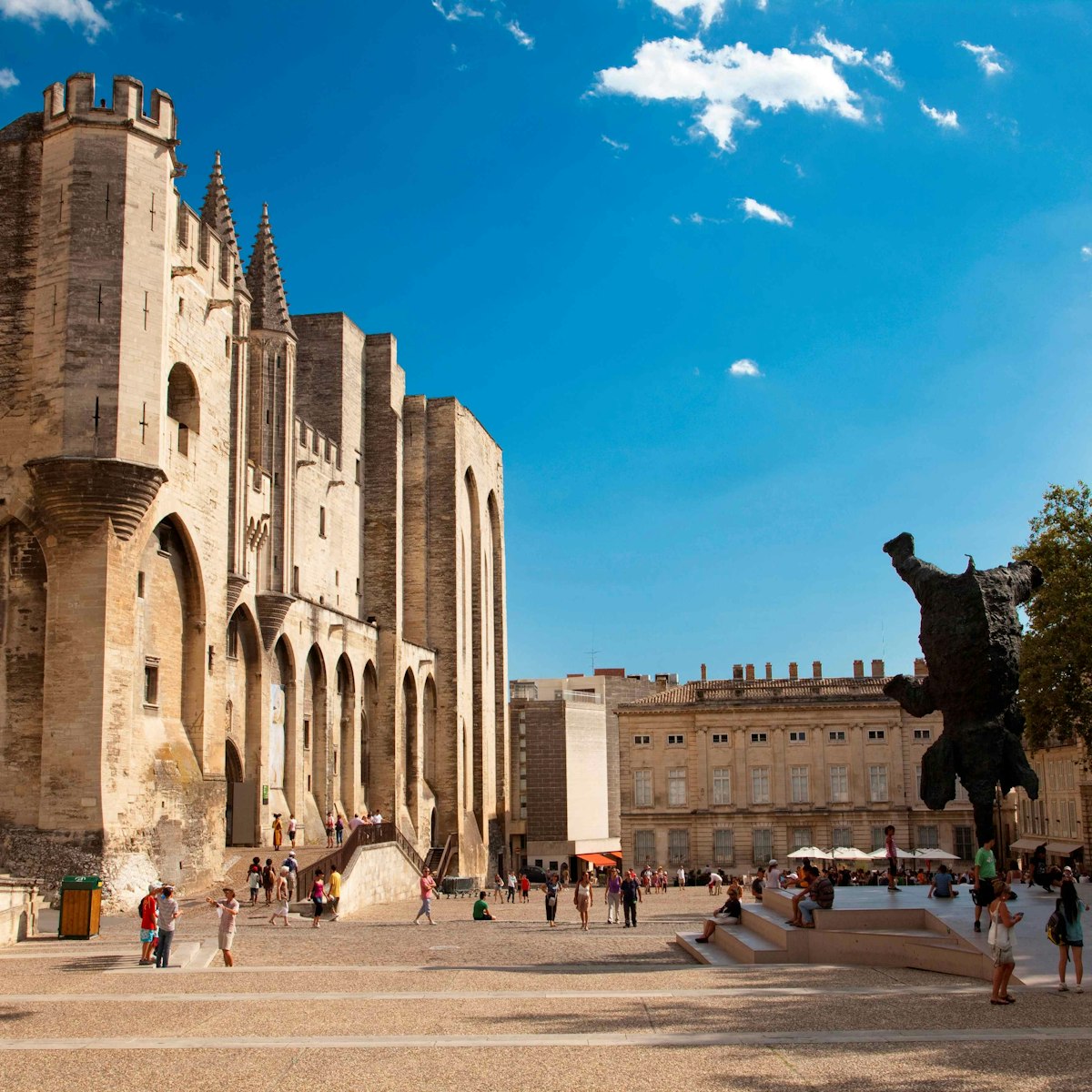
Palais des Papes
The largest Gothic palace ever built, the Palais des Papes was erected by Pope Clement V, who abandoned Rome in 1309 in the wake of violent disorder after…
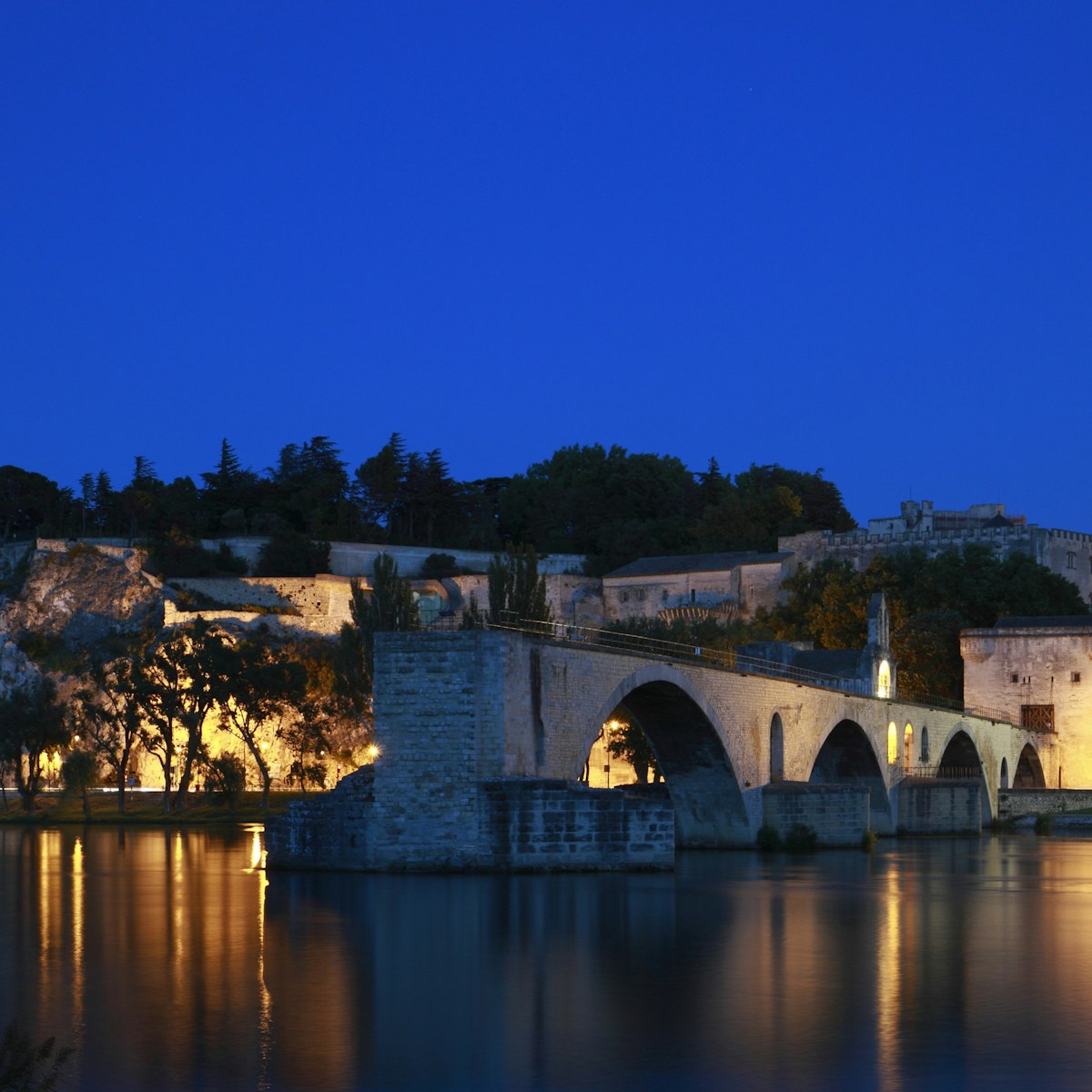
Pont St-Bénézet
Legend says Pastor Bénézet (a former shepherd) had three visions urging him to build a bridge across the Rhône. Completed in 1185, the 900m-long bridge…
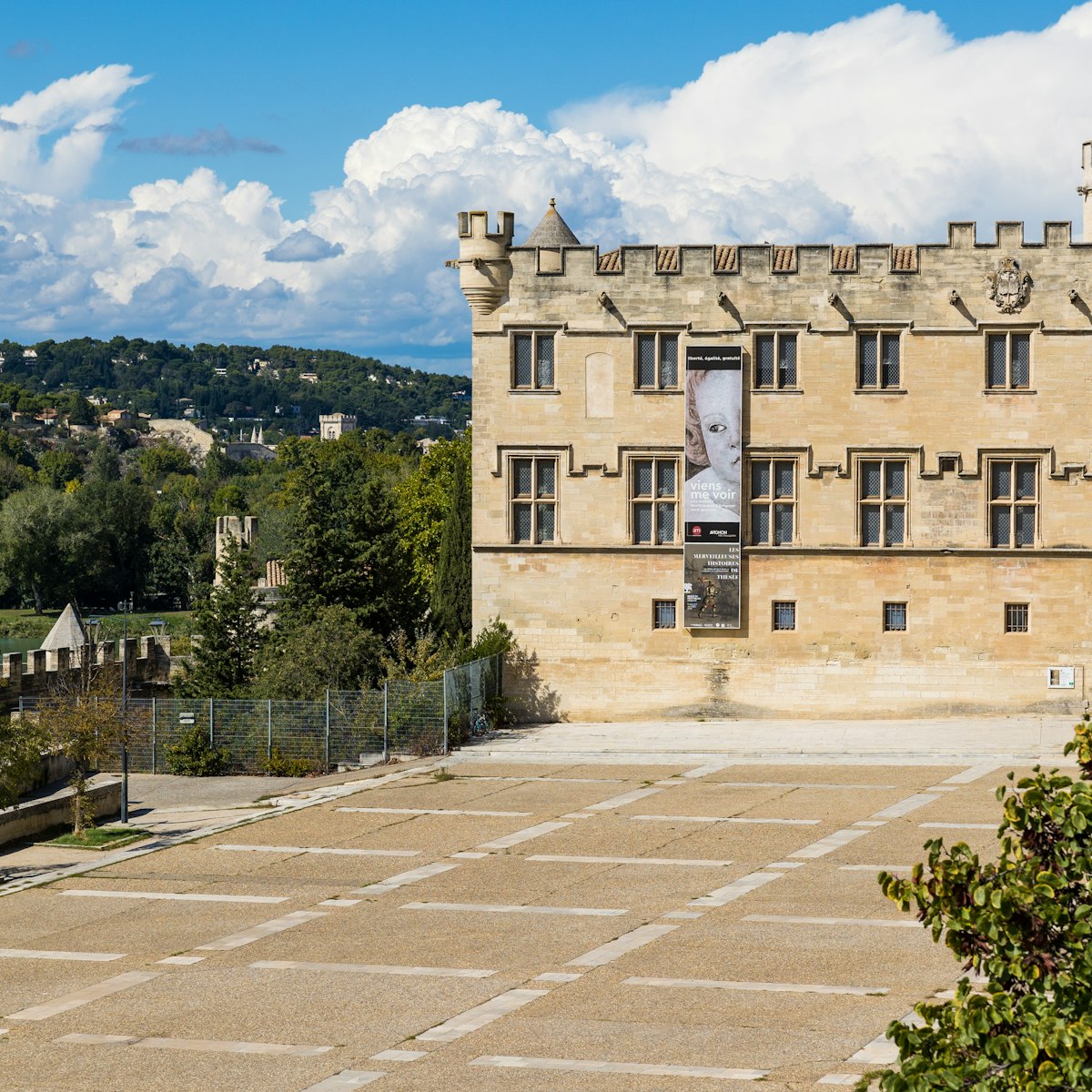
Musée du Petit Palais
The archbishops' palace during the 14th and 15th centuries now houses outstanding collections of primitive, pre-Rennaissance, 13th- to 16th-century…

Musée Angladon
Tiny Musée Angladon harbours an impressive collection of realist, impressionist and expressionist treasures, including works by Cézanne, Sisley, Manet,…
Place du Palais
This impressive vast square surrounding the Palais des Papes provides knockout photo ops. On top of the Romanesque 17th-century cathedral stands a golden…
Musée Lapidaire
Housed inside the town's striking Jesuit Chapel is the archaeological collection of the Musée Calvet, newly displayed since 2015. There's a good display…
Collection Lambert
Reopened in summer 2015 after significant renovation and expansion, Avignon's contemporary-arts museum focuses on works from the 1960s to the present…
Musée Calvet
The elegant Hôtel de Villeneuve-Martignan (built 1741–54) provides a fitting backdrop for Avignon's fine-arts museum, with 16th- to 20th-century oil…
Basilique St-Pierre
Basilique St-Pierre, in the centre of the walled city of Avignon, was built between the 14th and 16th centuries in the Flamboyant Gothic style.
Église et Cloître des Carmes
Construction on this Romanesque and Gothic Carmelite church and cloister began in the 13th century. It became one of the first theatre and dance venues of…
Porte St-Charles
Porte St-Charles is one of the entryways to Avignon's Unesco-registered walled city, located on the walls' southwestern edge; it's a modern-day breach cut…
Porte de la République
Porte de la République is one of the gateways to Avignon's walled city, located on the southern edge of the walls, and across from the central train…
Porte de I'Oulle
Porte de l'Oulle is one of the entryways to Avignon's walled city, located on the northwestern edge of the walls, near the River Rhône and Pont d'Avignon.
Porte du Rhône
Porte du Rhône is one of the entryways to Avignon's Unesco-registered walled city, located on the northwestern edge of the walls, near Pont St-Bénézet.
Porte de la Ligne
Porte de la Ligne is one of the entryways to Avignon's Unesco-registered walled city, located on the northen edge of the walls, near the River Rhône.
Porte St-Dominique
Porte St-Dominque is one of the entryways to Avignon's Unesco-registered walled city, located on the western edge of the walls, near the River Rhône.
Porte St-Roch
Porte St-Roch is one of the gateways to Avignon's walled city, located on the southwestern corner of the walls; it's particularly well preserved.
Porte St-Lazare
Porte St-Lazare is one of the entryways to Avignon's Unesco-registered walled city, located on the northeastern edge of the walls.
Porte Magnanen
Porte Magnanen is one of the entryways to Avignon's Unesco-registered walled city, located on the southeastern edge of the walls.
Porte Limbert
Porte Limbert is one of the entryways to Avignon's Unesco-registered walled city, located on the southeastern edge of the walls.
Église de St-Agricol
The relics of the patron saint of Avignon, St Agricol, are kept in this 14th-century church.
- 1.1 History
- 2.1 By plane
- 2.2 By train
- 2.4 By boat
- 3 Get around
- 4.1 Museums
- 7.2 Mid-range
- 7.3 Splurge
- 9.2 Mid-range
- 9.3 Splurge
- 10 Stay healthy
Avignon is the capital of the French department of Vaucluse in Provence-Alpes-Côte d'Azur , and is on the banks of the Rhône river. Avignon was one of the European Cities of Culture in 2000 and its historical centre has been inscribed on the UNESCO World Heritage list . Prior to the latter's annexation by France in 1791, Avignon was the papal capital of the independent Comtat Venaissin .
Understand [ edit ]

Avignon is famous as the city to which the Popes fled when leaving the corruption of Rome in the 14th century. Le Palais des Papes (Palace of Popes) which was built then is the world's largest Gothic building. It was largely emptied over the centuries, and its vast stone rooms are filled with little more than old frescos, but it is still an imposing building. The Ramparts themselves were erected to keep the plague and invaders out during the turbulent Middle Ages, when Avignon belonged to the papacy and not the French crown.
Its early history is much older than the popes, however. Avignon occupies a strategic location for several reasons - it is at the confluence of two once-mighty rivers: the Rhône, still one of the biggest rivers in France, and the now largely-dammed Durance. Both were important routes of trade and communication even in prehistoric times. In addition, there is a long island in the Rhone that made it possible to ferry people and goods across, and later bridge the river, more easily than in other places.
The city has a population of 92,000 people (2017), 16,000 of which live 'intra-muros,' or within the ramparts built in the 14th century.
The city is now sprinkled with buildings and monuments ranging from the new to the old, the very old, and the ageless.
History [ edit ]
Avignon has been continuously inhabited since the stone age, when habitations were built in caves in the “Rocher des Doms”, a massive outcropping of rock rising over the banks of the Rhône. Today, a public park with benches, views over the surrounding countryside, a café and playground is on top of the Rocher.
The Romans had a presence in Avignon, though the walls they built lie buried somewhere under the modern streets. Vestiges of the forum can still be seen, lying unassumingly near the Rue Racine and the Rue Saint-Étienne, to the west of the city.
Then, in medieval times, the town grew to an important center of communication and trade. The stone bridge spanning the Rhone was one of only three between the Mediterranean and Lyon. It was undoubtedly for its strategic location and ease of travel that it was chosen by the papacy as home within the then kingdom of Provence. The presence of the papacy made Avignon into a city of great political and economic activity. The old city wall, now visible only as a street that circles the centre of the town (changing names 5 times in the process!) was much too small and a larger wall, still visible today, was necessary to protect its bulging population. Wealthy Cardinals built extravagant palaces known as livrées both within Avignon and across the river, in Villeneuve-lès-Avignon.
The city teemed with activity and building as architects, builders, artists flocked to the town. At that time, within the city walls there were over 100 churches and chapels - many of which have been transformed since then into everything from shops to a movie theatre! The wealth and activity generated by the presence of the papacy spilled out into the region, so that even small villages nearby boast a rich architectural past.
- 43.944971 4.805789 1 Office de Tourisme d'Avignon , 41, cours Jean Jaurès BP8 , ☏ +33 4 32 74 32 74 , [email protected] . Apr-Oct: M-Sa 09:00-18:00, Su holidays 10:00-17:00; Festival: daily 09:00-19:00; Nov-Mar: M-F 09:00-18:00, Sa 09:00-17:00, Su 10:00-12:00 . In the season there is also an information point at the TGV Station ( updated Jun 2015 )
Get in [ edit ]

By plane [ edit ]
By train [ edit ], by bus [ edit ].
Avignon is connected to most other European cities with Flixbus. For regional travelers, following your common source, you can take: the Vaucluse département buses of the "TransVaucluse Network"; departmental buses of Bouches-du-Rhône, whose schedules are available on Lepilote [dead link] ; or departmental "cars du Gard", working under the name of "Edgar". All lines to the terminal bus station Avignon, which is near the train station and the walls surrounding the city center.
By boat [ edit ]
While there is no regular boat line in Avignon, you can arrive by boat in Avignon via river cruises.
By car [ edit ]
From Paris or Lyon , you can reach Avignon by the Autoroute du Soleil and take the Avignon-Nord exit and follow the N107 then the D225 towards AVIGNON Centre . This urban road leads straight to the famous Avignon bridge just before where you have a large pay car park (car park the Palais des Papes), which leads directly onto the Place du Palais des Papes in the heart of the city.
Other parking solutions, the municipality has set up 2 "relay parking + free shuttle" lots, with one bus every 10 minutes from 10:00 to 22:00. The first "Parking Italians" , accessible the D225 road which runs. Circuit the shuttle drops users in the intramural centre, near the Town Hall Square; the second is located on the Ile de la Barthelasse (head Villeneuve lès Avignon and follow the signs). The shuttle drops users at Gate Oulle, about 200 m from the bridge of Avignon (Saint Bénézet bridge).
From Montpellier or Nîmes , exit on the A9 (exit Roquemaure, the first after the junction with the A7), then follow the direction Avignon.
Get around [ edit ]

The old city centre is not very big and can be easily explored on foot. An automatic bike sharing scheme called Vélopop' allows you to ride along. Smartcard needed.
See [ edit ]

Other popular tourist destinations include: the 43.950926 4.806701 3 Place du Palais , just next to the 43.949381 4.805918 4 Place de L'horloge , though someone may find these places shockingly expensive, and overcrowded in season. Within a short distance in just about any direction are some smaller squares frequented by the locals, and much lower prices. Like 43.948215 4.810381 5 Place Pie , with its covered market (open 06:00 to 13:00 everyday) which sells fresh produce, cheeses, wines, and produits du pays .
Museums [ edit ]
Avignon has its share of museums, ranging from modern art museums to museums housing artefacts from the Roman and pre-Roman days.
Do [ edit ]
- If you are confident about biking, there are a lot of places to bike to.
- Rugby league: SO Avignon [dead link] play in Elite 1, the top French tier for 13-a-side rugby. Their home ground is Parc des Sports (capacity 10,000) 3 km southeast of town centre. The playing season is Sept-April.
Events [ edit ]
- The International Congress Center . Was created in 1976 within the outstanding premises of the Palace of the Popes and hosts many events throughout the entire year.
- Avignon Fair , Chemin des Félons , ☏ +33 4 66 54 81 71 , +33 6 20 87 91 19 . mid-April . A modern-style fair. The wine competition of the Rhone Valley, organised upstream since 1980, gives its official results at this fair. ( updated Aug 2018 )
Buy [ edit ]
- 43.950515 4.813365 1 Flea Market , Place des Carmes . Every Sunday morning . Browse the tables looking for your hidden treasure.
- 43.947802 4.810338 2 Food Market , Les Halles d'Avignon, place Pie . Every morning except Monday . Local specialties like olive oil, tapenade, local wines, cheeses, and pastries can be found at the market along with fresh local produce. Cooking classes are available on Saturday mornings.
- 43.952006 4.805199 3 Pure Lavande , 61, rue grande Fusterie , ☏ +33 490147005 . This boutique specializes in lavender and lavender products.
Eat [ edit ]
Budget [ edit ].
- 43.947876 4.809532 1 Le Palais des Pâtes , 38 Rue du Vieux Sextier . ( updated Feb 2023 )
- 43.944331 4.807971 2 Chez Bodus Le Garçon Boucher , 1 Rue Saint-Michel . Hamburger ( updated Feb 2023 )
- 43.947659 4.811519 3 Caf'Thiers , 12 Rue Thiers . ( updated Feb 2023 )
- 43.949754 4.812421 4 Mamma rosa , 19 Rue Portail Matheron . ( updated Feb 2023 )
- 43.948578 4.80392 5 Rossini Sandwicherie , 4 Rue Félix Gras . ( updated Feb 2023 )
- 43.946096 4.811823 6 El Taquito , Rue de la Bonneterie . Mexican ( updated Feb 2023 )
- 43.944494 4.807889 7 L'Épicerie de Ginette , 25 Pl. des Corps Saints . ( updated Feb 2023 )
Mid-range [ edit ]
- 43.948211 4.80643 8 D'Ici et d'Ailleurs , 4, rue Galante , ☏ +33 4 90 14 63 65 . "Fresh products on a sunny terrace." ( updated Feb 2023 )
- 43.945895 4.807727 9 Fou de Fafa , 17 Rue Des Trois Faucons , ☏ +33 4 32 76 35 13 , [email protected] . dinner from 18:30 . Quality French food with an international twist. ( updated Feb 2023 )
- 43.949364 4.807755 10 L'Epicerie , 10, Place Saint Pierre ( tucked in a nice little square just south of the Palais des Papes ), ☏ +33 49 0827422 . Try the Assiette Epicière for a plate full of provençal specialities such as tapenade, ratatouille, with a salad and some ham. ( updated Feb 2023 )
- 43.949903 4.803392 11 Restaurant EAT , 8 Rue Mazan . French cuisine ( updated Feb 2023 )
- 43.945815 4.807824 12 Avenio , 19 Rue Des Trois Faucons . French cuisine. ( updated Feb 2023 )
- Cafe In Et Off , Place Du Palais Des Papes . ( updated May 2023 )
Splurge [ edit ]
- 43.950044 4.806921 13 Restaurant Sevin , 10 Rue de Mons ( just south of the Palais des Papes ), ☏ +33 4 90 86 16 50 . A well-known Provençale chef. An excellent vegetarian menu is available. ( updated Feb 2023 )
- 43.948327 4.806084 14 Hiély Lucullus , 5 Rue de la République . Haute French restaurant with Peruvian influences. ( updated Feb 2023 )
Drink [ edit ]
The Rhone valley around Avignon is a major wine-growing region. The most famous wine is Châteauneuf du Pape , which translates as "the Pope's new house"; in medieval times there were some Popes based in Avignon . The reds are better known but there are also some fine whites.
- 43.948576 4.805403 1 Le Vin Devant Soi wine shop , 4 rue Collège du Roure ( just off of Rue de la République, south of the Place de l'Horlorge ), ☏ +33 4 90 82 04 39 . M-Sa 10:00-19:30 . This wine shop has a permanent tasting machine set up with 32 wines. You purchase tasting credit for however much you like, they give you a card that you can put in the tasting machine to select the wine you want to taste. Tastes come in three different sizes, with different prices for different wines. The staff is very friendly, and there is a nice atmosphere. ( updated Nov 2023 )
Sleep [ edit ]
- 43.953102 4.799374 1 Auberge-Camping Bagatelle , Île de la Barthelasse . This hotel, hostel and camp site is on Ile de la Bathelasse in the centre of the Rhone. This is perhaps the best place to stay on a budget. It has great facilities and offers perhaps the best view of the centre of Avignon. Carries a basic menu restaurant. Another benefit is that is placed directly between Avignon and the opposite town Villeneuve-les-Avignon, both begin within 10 minutes walk. €16.56 with complimentary breakfast .
- 43.944597 4.800701 2 Hotel d'Angleterre , 29 Boulevard Raspail ( 10 minutes walk from bus and train station ). some rooms with bathroom. Small hotel located within the city walls. Has a small private car park. Its use is free of charge if you can find a place for your car. €40 .
- 43.939795 4.805895 3 Altera Roma Hotel , 13-15 Avenue Monclar ( just behind the central station, which faces the main avenue of downtown and the bus station ), ☏ +33 4 90 86 20 14 , fax : +33 4 26 23 68 31 , [email protected] . Family-run hotel overlooking a flowered garden, within a private carpark. Internet wi-fi available in the whole building. Renovated rooms with the typical Provencal style. 7 languages spoken. Private taxi service. Double room with en suite shower and bathroom €30-60, studios and apartments from €75, breakfast €7 can be taken in the garden in season 07:30-11:00 .
- 43.944724 4.805073 4 Hotel Boquier Avignon , 6 rue du portail Boquier ( in old city, near the tourism office ), ☏ +33 4 90 82 34 43 . Check-in: 13:00 , check-out: 11:00 . A charming hotel in a 18th-century house. 55-69 .
- 43.947573 4.805949 5 [formerly dead link] Hotel Danieli , Rue de la République . Very central with air conditioning and a good breakfast. €80 per night for a double during the summer, more expensive during the Festival d'Avignon. .
- Mas du Clos de l'Escarrat Route de Carpentras chemin de l'Escarrat. €80 Bed & Breakfast
- 43.944154 4.806993 6 Hotel Le Colbert , 7 rue Agricol Perdiguier , ☏ +33 4 90 86 20 20 . Individual air conditioning room from €78 .
- 43.942912 4.797995 7 Au Saint Roch , 9 rue Paul Mérindol, 84000 Avignon ( South West from the middle age city ), ☏ +33 6 90 16 50 00 , fax : +33 4 90 82 78 30 , [email protected] . Nice hotel with a very quiet garden. From €48 to €65, €7.50 for breakfast .
- 43.950347 4.803439 8 Hotel d 'Europe , 12 Place Crillon . 5-star €350 .
- 43.950077 4.807656 9 'La Mirande Hotel , 4 place de la Mirande . 5-star hotel housed in a 700-year-old converted townhouse. €400 and up .
Stay healthy [ edit ]
- 43.920945 4.805952 2 Henri Duffaut Hospital , 305 r Raoul Follereau , ☏ +33 4 32 75 33 33 .
- 43.94555 4.842439 3 Clinique Urbain V , chem Pont des Deux Eaux , ☏ +33 826 399 990 , fax : +33 4 32 74 24 41 .
Connect [ edit ]
Cope [ edit ], go next [ edit ].
The surrounding region is full of interesting sites, There are three sites inscribed on the UNESCO World Heritage List
- Arles is full of Roman and Romanesque monuments and worthy of a full days exploration. 17 min from Avignon by TER.
- Orange just a short train ride to the north is home to one of the finest Roman theatres in Europe
- Le Pont du Gard is about 30 km to the west it is probably the finest Roman aqueduct still in existence, and a great place for hiking and canoeing.
- Tarascon a medieval town, just a short train ride to the south
Other notable sites nearby are:
- Nimes which has a huge Roman amphitheatre and a famous Greek temple
- Châteauneuf-du-Pape is a short train ride north and is home to some of France's most famous vineyards
- Aix-en-Provence , town of water - town of art, founded by the Romans.
- UNESCO World Heritage Sites
- UNESCO tag to be fixed
- Has custom banner
- Has map markers
- Has mapframe
- Airport listing
- Articles with dead external links
- Listing with Wikipedia link but not Wikidata link
- Do listing with no coordinates
- Eat listing with no coordinates
- Articles with formerly dead external links
- Usable cities
- Usable articles
- City articles
- Has Geo parameter
- All destination articles
- Pages with maps
Navigation menu
Follow our travels on Instagram!

Top 10 Things to do in Avignon, France
Known as the gateway of Provence , Avignon is a popular base for exploring the wider region. It’s often chosen as a convenient place to stay , but once visited, it wins people over and becomes a firm favourite in its own right.
A city in name, the inner heart of Avignon feels more like a lively village in reality. Behind the beautifully preserved ramparts lay streets bursting with history, alive with the sound of music, and adorned with art. It’s a city that will seduce you and have you yearning to return.
At first glance, it may appear there aren’t too many things to do in Avignon. Indeed, most of the guides I’ve come across include more day trips from Avignon , than information about what to do in the city itself! But if you just want to stay put and enjoy what the city has to offer for a few days, or a few weeks , there’s plenty to keep you busy during a holiday in Avignon.
Read also: Best vacation rentals in Avignon
Top Avignon Attractions
With so many things to do in Avignon and the surrounds, I’ve decided to focus this list on the central city area. If you’re looking for more inspiration for things to do in Provence, check out my 7-day South of France itinerary , Day Trips from Aix , and Day Trips from Avignon articles.
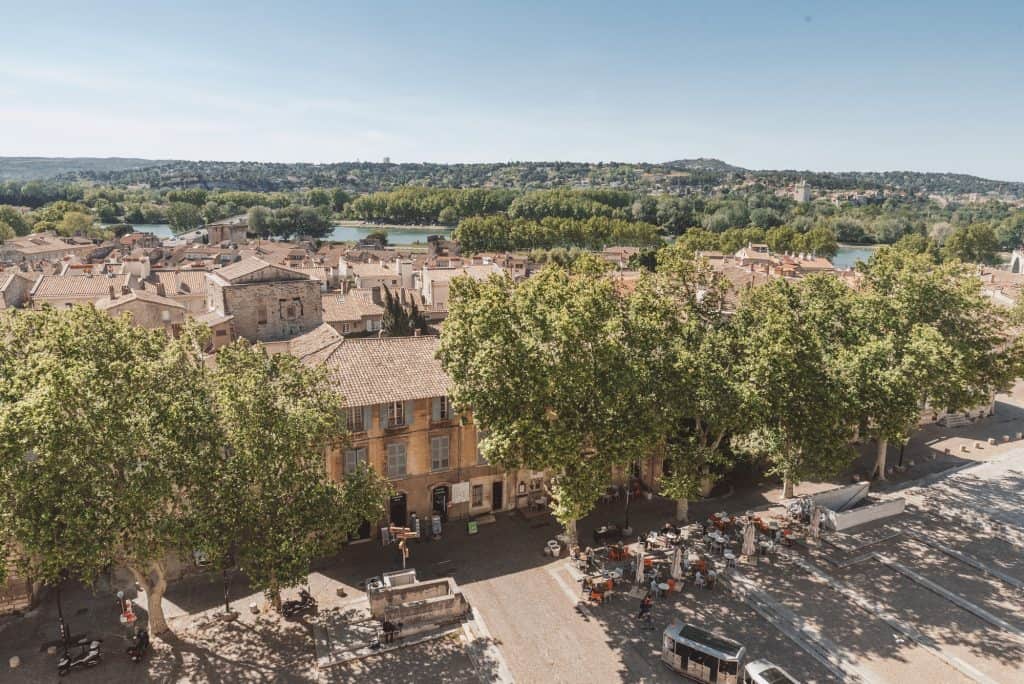
#1 PONT D’AVIGNON
When we first arrived in France, I bought an antique painting featuring a pretty bridge adorned with a petite chapel. It wasn’t until we moved to Provence a year later, that I recognised it as Avignon’s Pont Saint-Bénézet (often simply called Pont d’Avignon).
Once an important connection between the papal state of Comtat Venaissin and France, the bridge traversed the entire 900m over the Rhône river. After the original wooden version was destroyed, a stone version with 22 arches was rebuilt in its place. But over time, the river eroded the bridge’s iconic arches and they would collapse under the pressure of the swelling river.
4 arches and the Chapel of Saint Nicholas are all that remain of the once-stately bridge. Immortalised by the French song ‘Sur le Pont d’Avignon’ the bridge has earned a special place in the hearts of many, both in France and abroad.
To visit, you need to buy a ticket (purchase at the same time as you buy your ticket to the Pope’s palace for the best price). But the best views of the bridge itself are from above at the Rocher des Doms, or below on the île de la Barthelasse.
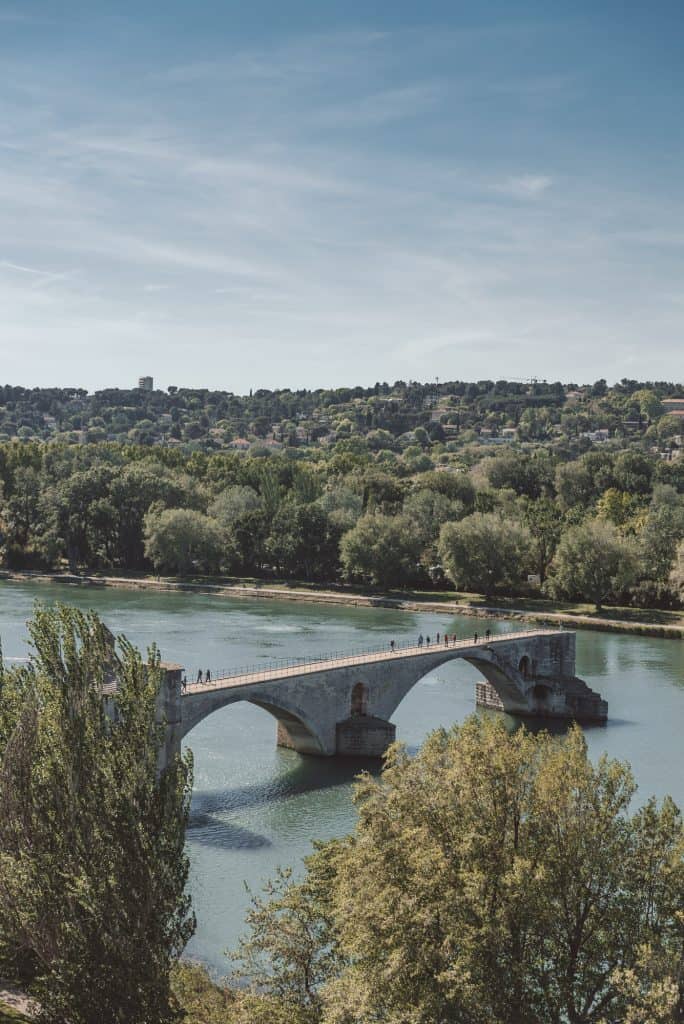
#2 RUE DES TEINTURIERS
If you entered the walls of the old city another way, you may never even know this little treasure existed. I’d visited Avignon plenty of times before, but it wasn’t until I stayed overnight in the city that I learned of the street of the waterwheels – rue des Teinturiers.
This utterly charming corner of Avignon was once the heart of the town’s textile industry. And the narrow arm of the Sorgue River that flows here was the driving force. Nowadays its values are mainly aesthetic, but four waterwheels still adorn the street as a memento of the once flourishing trade.
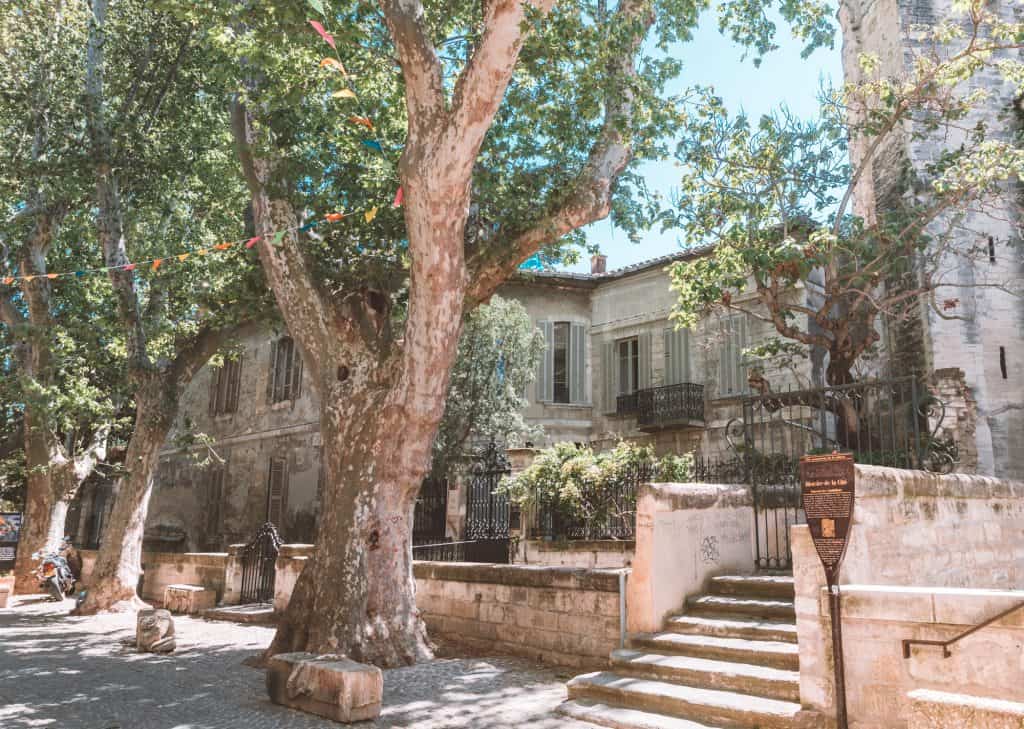
The street extends from the town walls through to Rue des Lices – in the direction of the centre ville. Walking down through the street, you’ll pass under the leafy sycamore trees alongside the canal. Dainty footbridges allow access to the historic residences on the one side, while the other is brimming with cafés whose terraces spill out onto the cobbled lane.
Notable buildings on the street include the Maison du IV de Chiffre – one of the oldest houses in Avignon, built in a gothic style. The Pénitents Gris d’Avignon – a beautiful chapel and home to the oldest brotherhood in Avignon. And the Couvent des Cordeliers which is all that remains of what was once one of the biggest churches in Avignon.
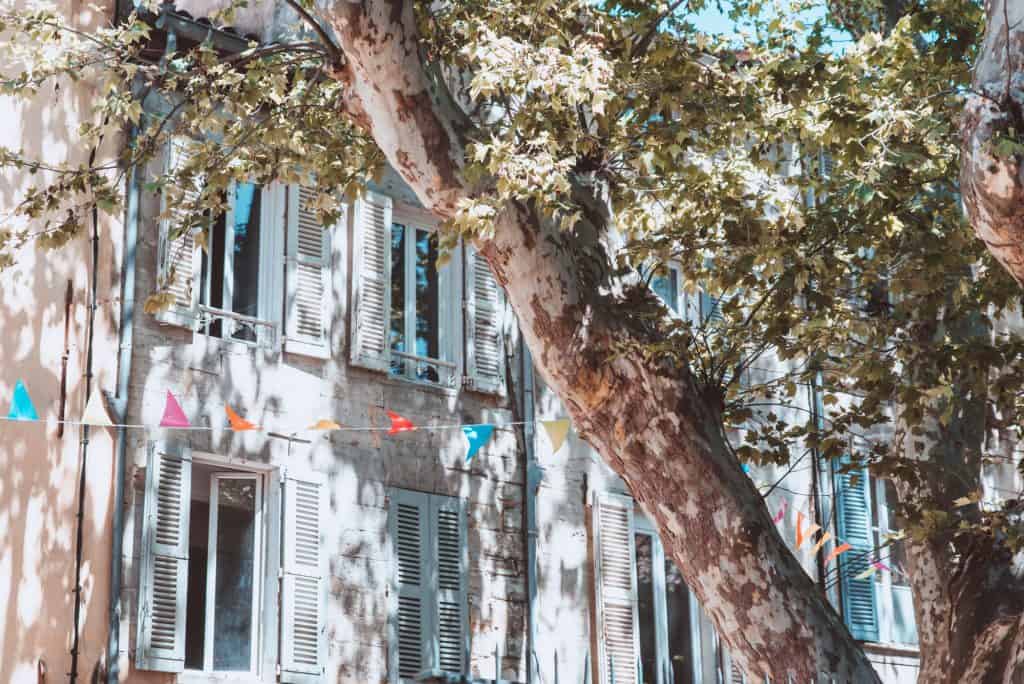
Looking for more Provence travel inspiration? Don’t forget to join our free Facebook group Provence Travel Planning !
#3 PALAIS DES PAPES
No trip to Avignon would be complete without visiting the majestic Pope’s Palace. The largest gothic palace in the world, the Palais des Papes dominates the Avignon cityscape and draws all eyes to its grand towers and angular battlements.
While you can certainly appreciate the palace from the outside – perhaps while sipping a café creme in the square out front – you’ll appreciate it all the more after taking a tour of the interior. Admire the 14th-century frescoes and pick up a histopad (included in the admission price) to reveal what the empty rooms and chapels of the palace once looked like.
It’s an interactive experience that makes the tour so much more informative and enjoyable. By paying for admission, you’ll also be able to scale one of the palace’s towers for incredible views over the city, the river Rhône, the île de la Barthelasse and beyond.
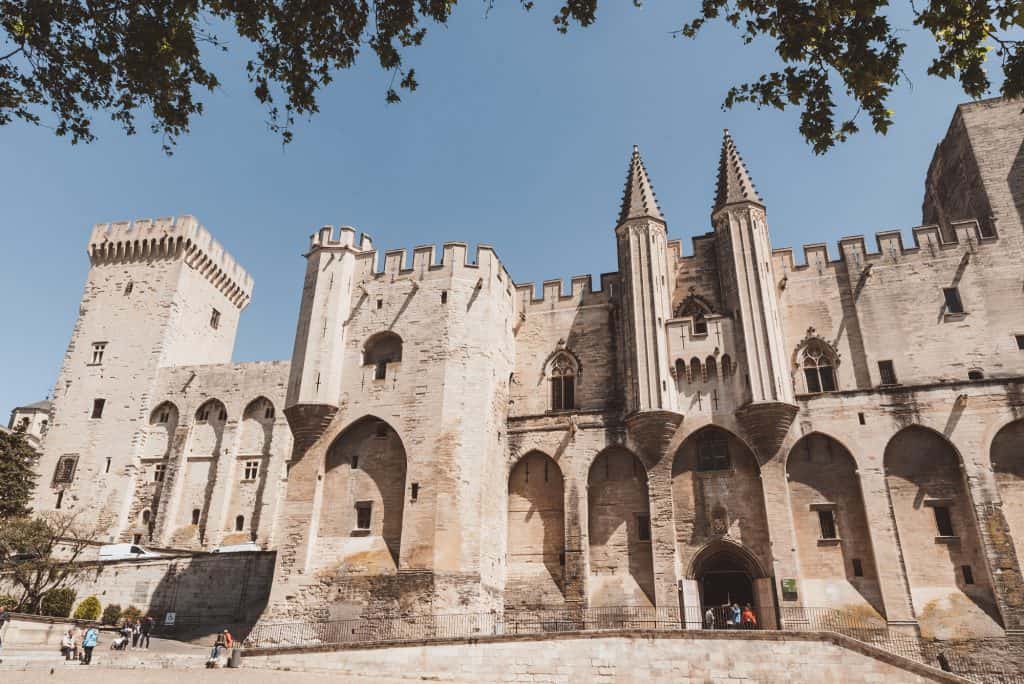
#4 FERRY TO L’ÎLE DE LA BARTHELASSE
Separating Avignon from Villeneuve-les-Avignon is the island of Barthelasse. A peaceful sanctuary just a stone’s throw from the bustling city centre, it’s the perfect place to have a picnic, a riverside stroll, or a leisurely bike ride.
To get there, you can simply walk or drive over the Édouard Daladier bridge, or take the more scenic route with the free ferry service. The navette fluviale leaves from behind the Pont d’Avignon, near the base of the stairs to the Rocher des Doms, at regular intervals throughout the day.
The schedule varies per the seasons and is listed at the entrance to the dock. Dogs and bikes are permitted on the ferry also.
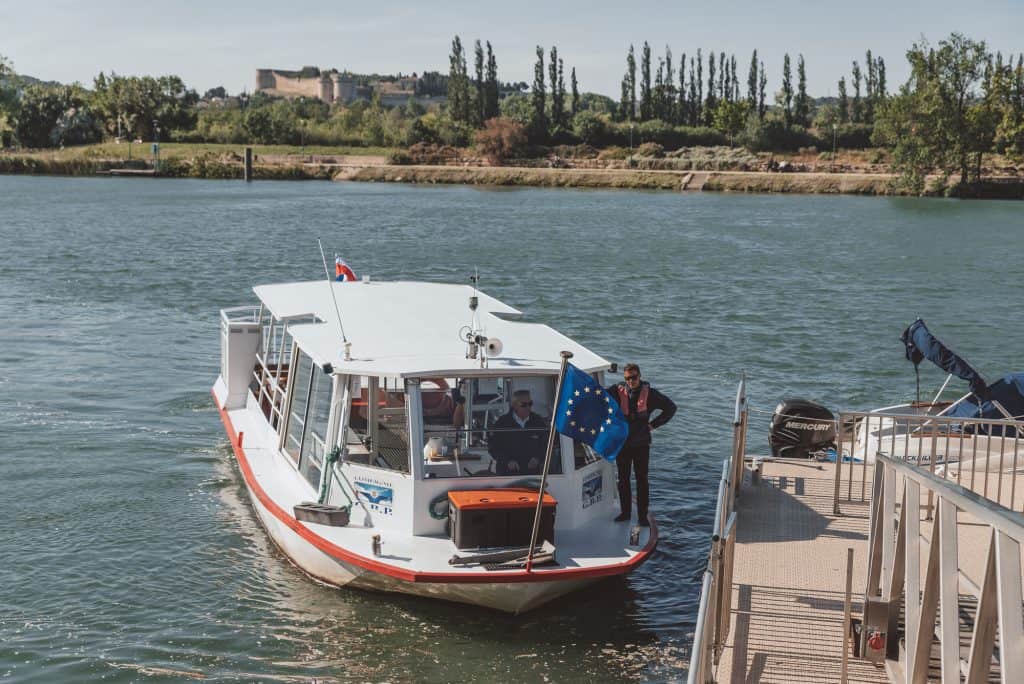
Among the largest river islands in Europe, the fertile soil of Barthelasse Island is laced with orchards and vineyards, and it provides the perfect habitat for many species of wildlife. Visit the Manguin Distillery to taste the exquisite fruit brandy on offer, have lunch on the terrace at Le Bercail, and pick up some locally grown produce direct from one of the farm-gate stores.
If you want to extend your stay on the island, La Bastide des Anges provides a farmhouse setting in which to get to know the island more intimately.
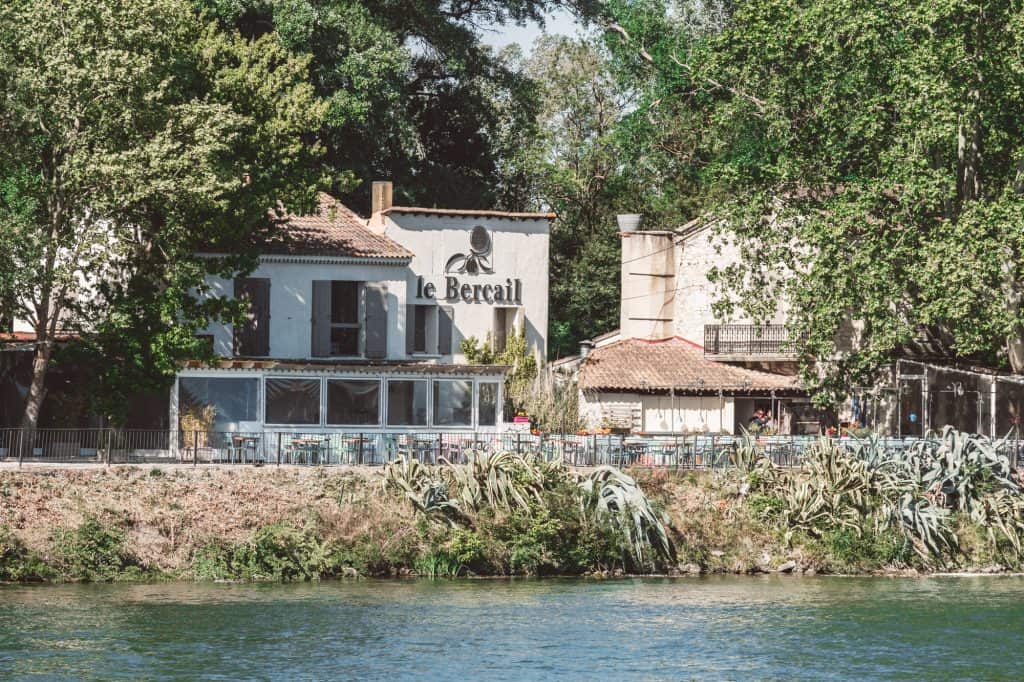
#5 LOSE YOURSELF IN THE OLD CITY STREETS
Avignon’s historic centre is an attraction in itself. One of the best ways to kill a few hours is to stroll the streets without an agenda and see what treasures you unveil. Duck into lanes to find hidden galleries, walk through ancient stone archways to discover sheltered gardens and climb stone stairs for the best views over the city.
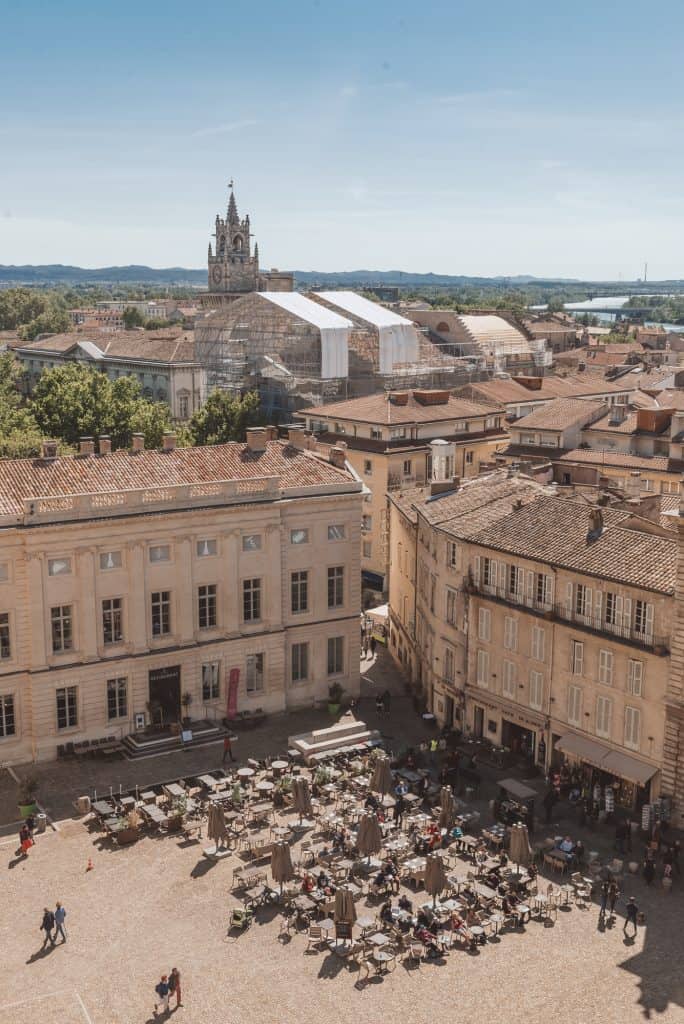
In reality, it’s actually quite hard to get lost, as inevitably you’ll stumble across a landmark or the imposing city walls. And it’s a beautiful way to get acquainted with the Southern city and to admire the history that’s still etched into the buildings and cobblestone streets.
Deep within the city walls is a pedestrian area where ambling takes on an even more leisurely manner. Pop into the stores that catch your eye, grab an ice cream to cool off and pause to give the storekeeper’s dog a belly rub…
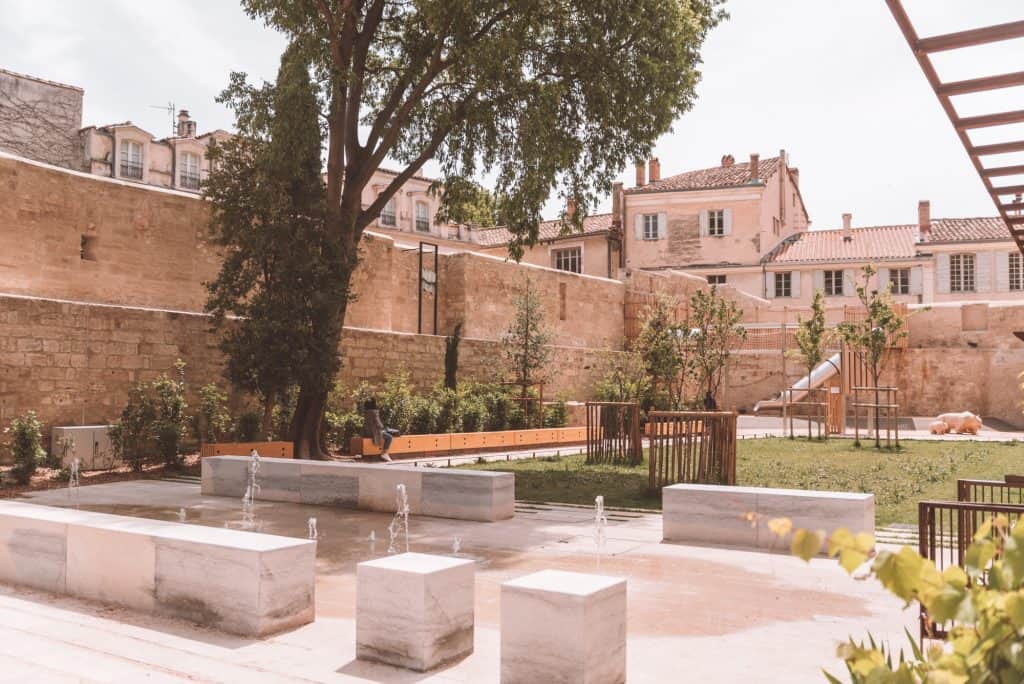
#6 LES HALLES FOOD MARKET
Is there a market in the world more romanticised than that of a traditional Provençal market?
Provence is famous for its markets (and perhaps the lifestyle they represent) and Avignon is home to one of the most famous markets in the region. Les Halles is its name, and unlike most markets, it’s a permanent fixture in the city’s landscape.
The somewhat industrial-looking building that houses the iconic Avignon market belies the delightful scenes that meet you within. The indoor market is brimming with local delights – ranging from delicately prepared pastries right through to produce still speckled with the dirt it was plucked from hours before.
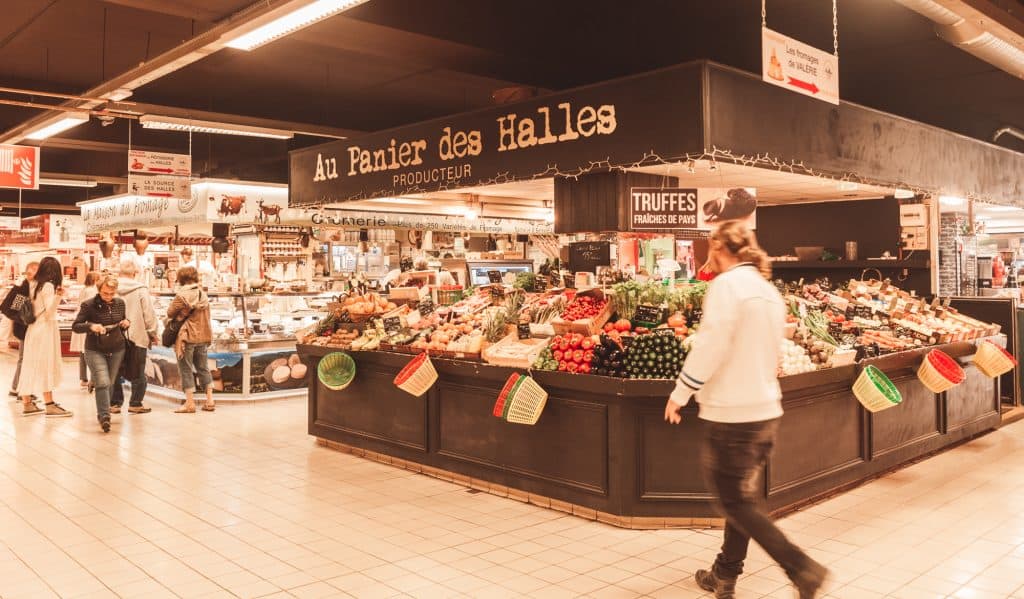
Much more than a market, Les Halles is a meeting point, a one-stop-shop, and as some might say, the heart of the community. Open Tuesday through Sunday, it’s positively bustling on weekends. Particularly on Saturday mornings when local chefs give live demonstrations of their expertise.
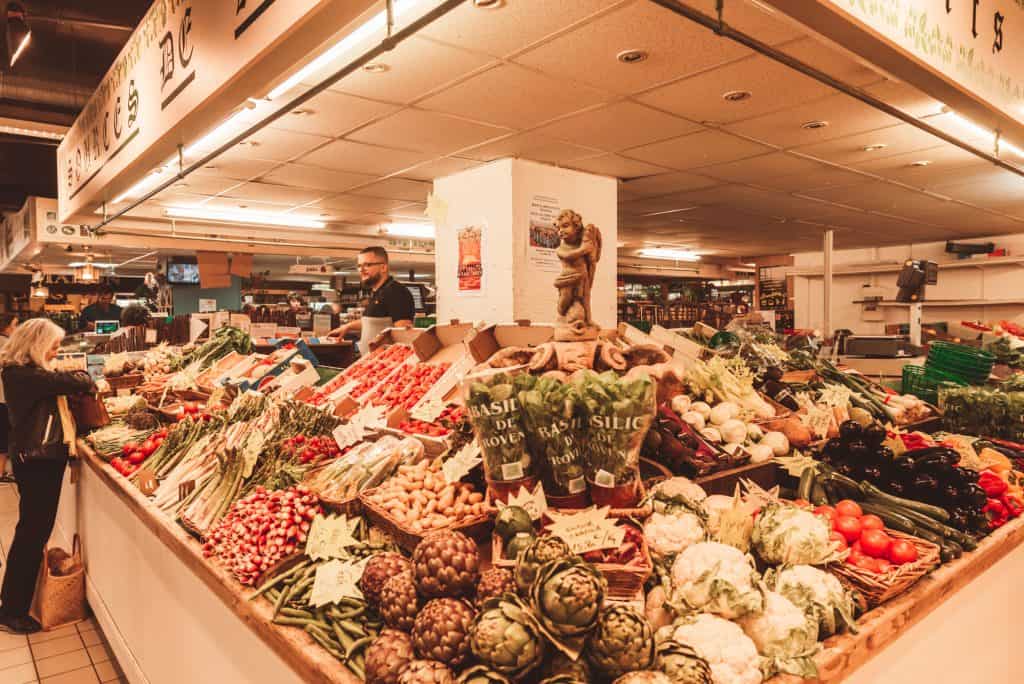
#7 ROCHER DES DOMS
In an otherwise level city, the raised Rocher des Doms gardens offer a fresh perspective and a unique vantage point. Rising almost ethereally from the banks of the Rhône, a stone stairway leads the path to this enchanting garden.
Despite its elevated position, the treescape of Rocher des Doms provides a welcome respite from the sun, or protection from the mightiest of mistral winds. This makes it suitable for visiting all year round. But it’s in the warmer months that it really shines.
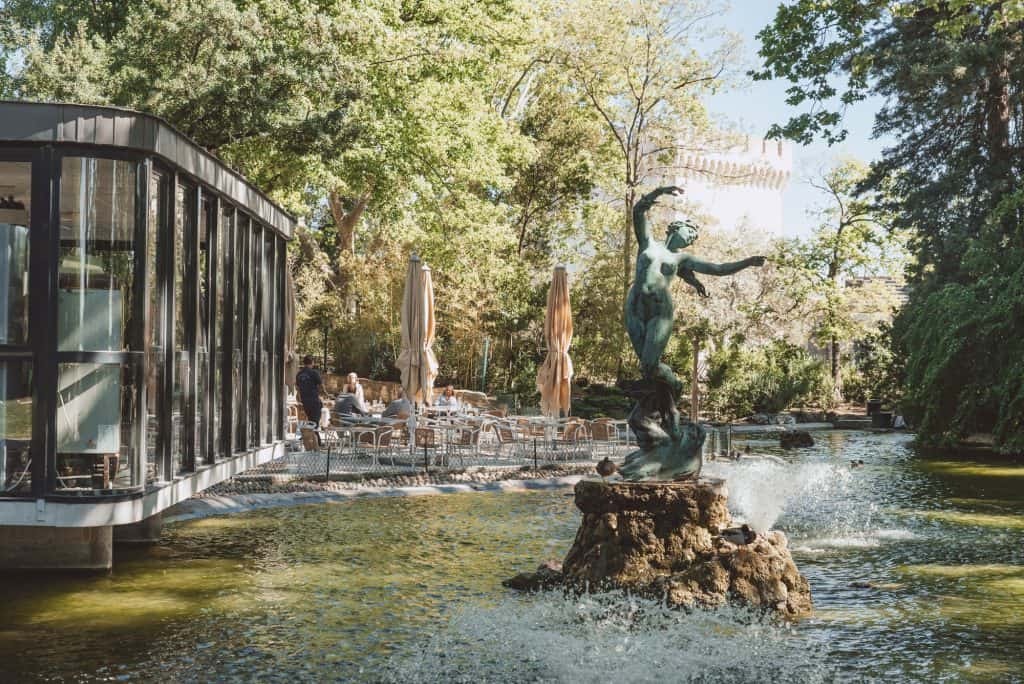
Sit and sip rosé at the café terrace, relax on a bench next to the pond, or take a stroll to one of the lookout points for unbeatable views over the Pont Saint-Bénézet and towards Villeneuve-lès-Avignon with its unmistakable hilltop fort.
To get there, take the stairs from the Boulevard de la Ligne or from behind the palace on Rue des Escaliers Sainte-Anne, or walk up and around the Avignon Cathedral. If you’re feeling less energetic, there’s also a little tourist train that will take you on a short tour of the old town and Rocher des Doms gardens for €9. Catch it from outside the Pope’s Palace.
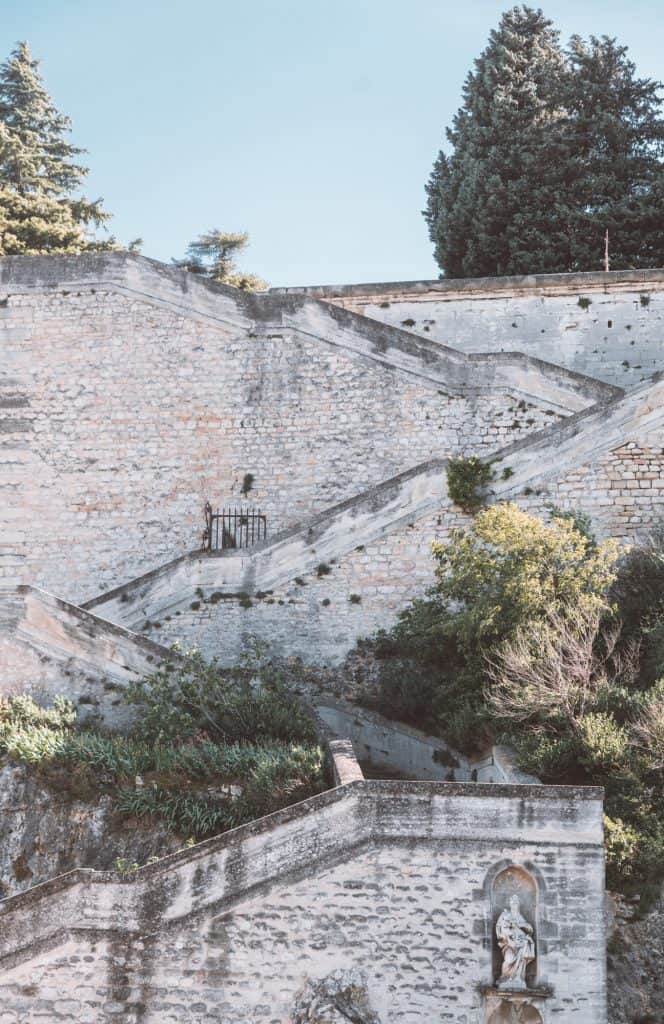
#8 FESTIVALS OF AVIGNON
Every July, the streets of Avignon are alive with the sights and sounds of dance, music and theatre performances throughout the city. The official Festival d’Avignon is the oldest festival in France and draws in thousands of visitors from around the world. While the festival most famously takes place in the courtyard of the Palais des Papes, it also spills out into other unsuspecting corners and crannies around the historic city.
The existence of a second festival, the Off Festival , running almost concurrently with the main festival, means every park, courtyard, hall and theatre throughout the city is abuzz with excitement.
With so much going on, it’s easy to get overwhelmed if you try to do too much. I recommend instead to chose a couple of ‘must-see’ shows and then let the others lure you in as you take in the atmosphere on the streets. Due to the popularity of the festival, accommodation within Avignon in July is booked up fast, so get in quick if you plan on attending this artistic spectacle.
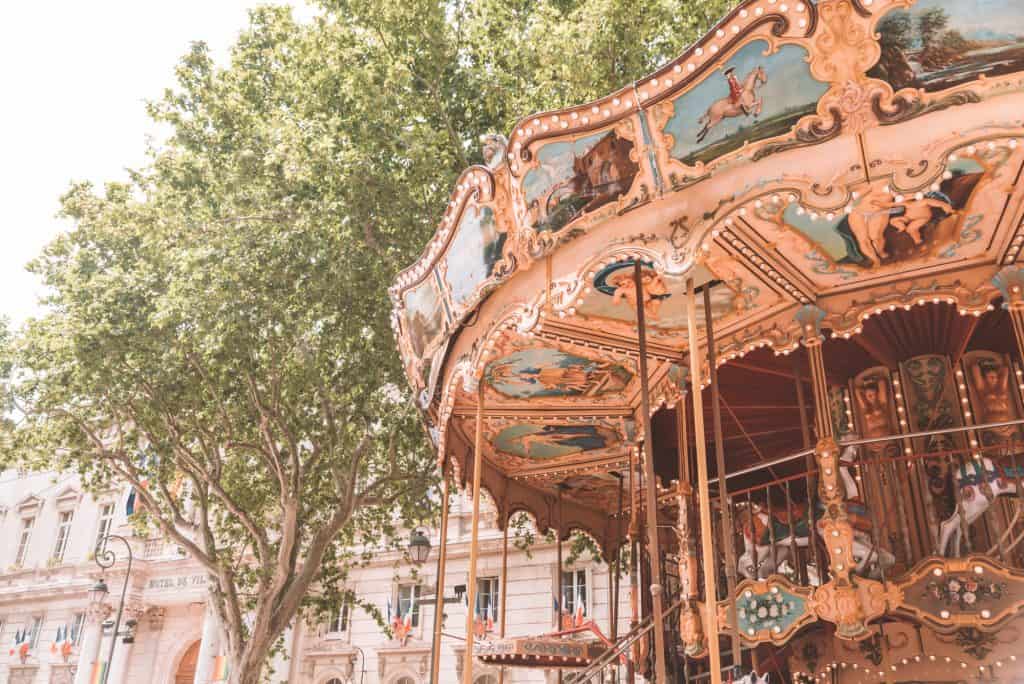
#9 ART & HISTORY MUSEUMS
In a city so entrenched in history as Avignon, it’s no surprise that museums and galleries take centre stage. Find yourself in a world of art and grandeur, where often the buildings housing the exhibits are as attractive as the works displayed within.
Pop into the Musée du Petit Palais to view one of the most revered collection of medieval art in the world. Visit Musée Angladon for ancient archaeological findings of Greek, Roman and Paleo-Christian influence. Or bear witness to some of the greatest artwork produced by local artists – including Van Gogh, Picasso and Cézanne – at the Musée Angladon .
Many of Avignon’s museums are free to visit – making them accessible for all to enjoy. You can download a map of where to find the various Museums of Avignon here .
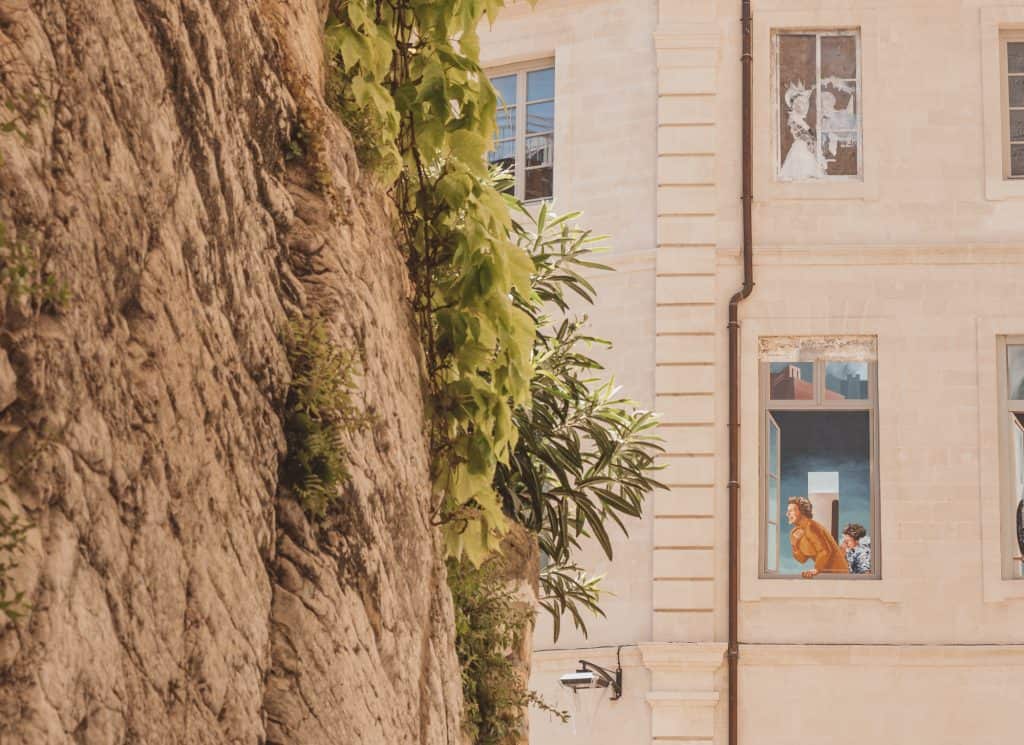
#10 FIND UNIQUE TREASURES TO TAKE HOME
Within Avignon’s walled city you’ll find a plethora of beautiful boutiques and shops. Alongside the usual suspects (the big name brands synonymous with any high street), there are independent stores selling everything from regional goods to antique treasures.
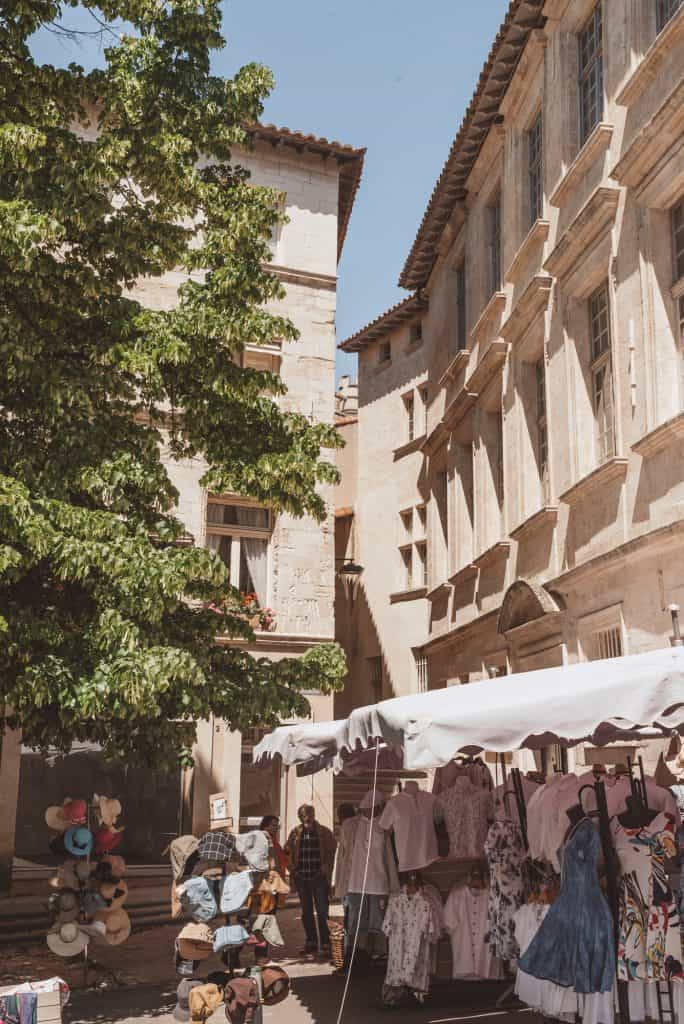
Head to the city’s pedestrian-only zone to browse the beautiful stores and indulge in some window shopping. Pop into CQFD for a bespoke collection of French-made and eco-friendly gift and homewares (I could spend all day in this stunning store!). Les Délices du Luberon for all your Provençal foodie finds. Le Château du Bois (also featured in my Provence Gift Guide ) for the finest lavender products. Or Vox Populi for the very finest interior decoration by designer Pascale Palun – presented in an exquisite showroom.
If bargain hunting is more your style, head to the weekly brocante staged outside Les Halles every Tuesday and Thursday.
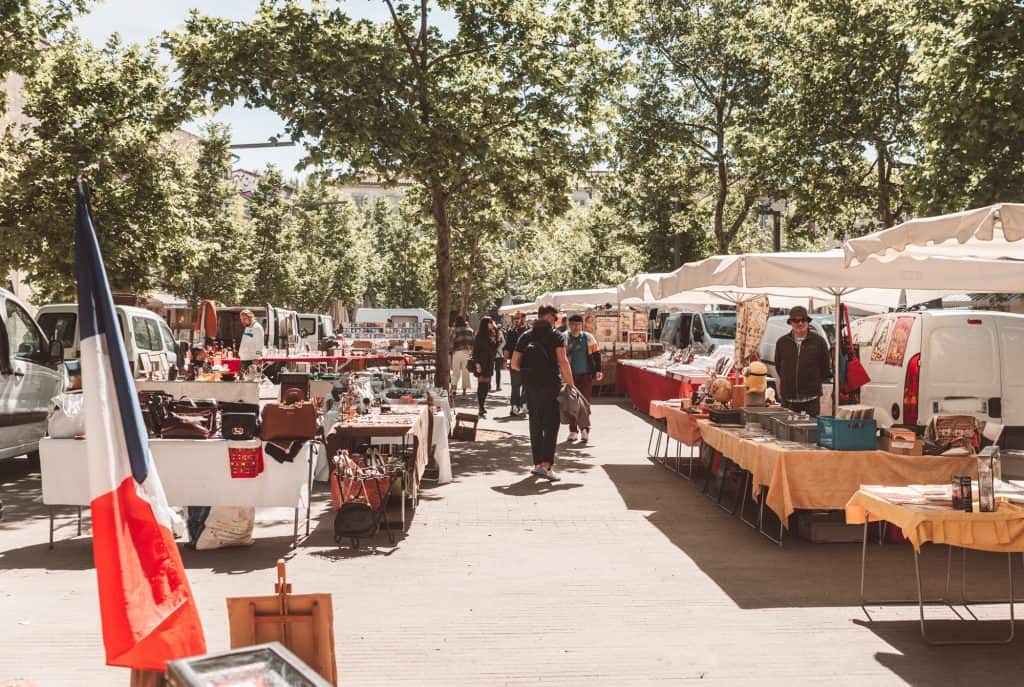
Where to eat in Avignon
Avignon is an exciting gastronomic hub. Not only is it home to several Michelin starred restaurants, but the city’s chefs are known to delight with their clever and often innovative creations.
Whether you’re wanting to try home-cooked regional specialities, upmarket French cuisine, or low key bistro fare, Avignon does it all – and well. Pop into Pollen for an ever-changing, seasonal menu in a comforting atmosphere. Savour a meal in the sumptuous surroundings of La Mirande. Or book a table at the crowd-pleasing Fou de Fafa (anyone else singing along to this Flight of the Concords song right now?!) to satiate the taste buds.
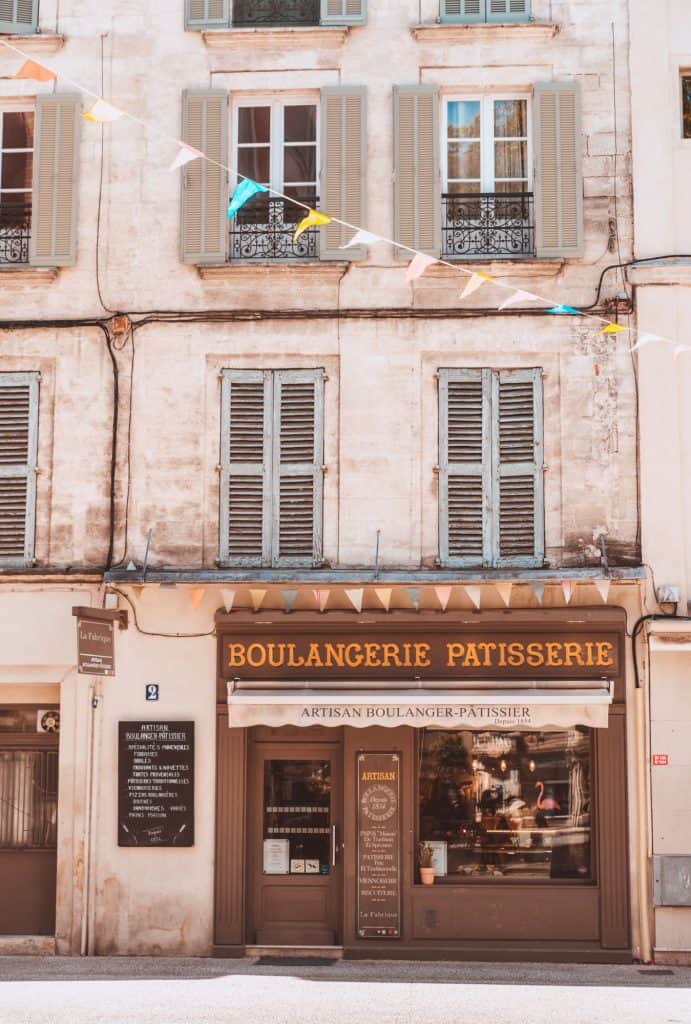
For visiting vegans , there are surprisingly plenty of options too. La Cantine du Nid offers healthy options in a relaxed atmosphere, the Coeur d’Artichaut has plenty of options for both vegan and gluten-free diets, and those looking for a more discerning dining experience can visit the Hotel de l’Europe for the vegetal menu.
In between meals, energy levels can be recharged by experiencing France’s café culture in the best way – slowly, and under the shelter of the broad-leaved plane trees in the city’s squares.
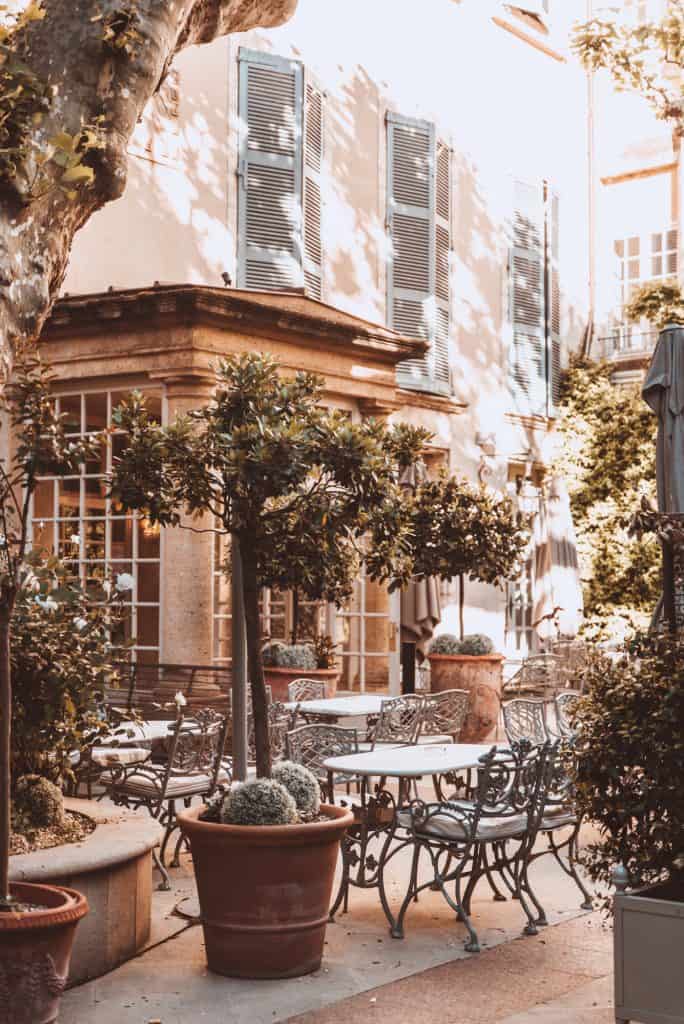
Best Avignon Tours
Sometimes you just want to see the best bits of a city without having to worry about logistics – and that’s absolutely fine! If that sounds like you, here are my picks of the best tours in Avignon.
3 Hour Walking & Wine Tasting Tour – take a stroll around the ancient city, experience the Pope’s Palace with your own guide, and then finish off with a glass of wine in a secret spot. Perfect for those just in town for the day.
Full Day Tour of Avignon & Côtes du Rhône – those wanting a full day excursion can join this tour that will introduce you to the Pope’s Palace, the historical centre, the Pont d’Avignon, and Les Halles before heading out into the countryside to sample some of the best wines in the region – straight from the cellar.
Le Grand Tour of Provence – short on time but want to experience the very best of Provence during your stay in Avignon? Book yourself into this full-day tour that takes in some of the finest attractions in the region, such as the Pont du Gard, Les Baux de Provence, and the villages of the Luberon.
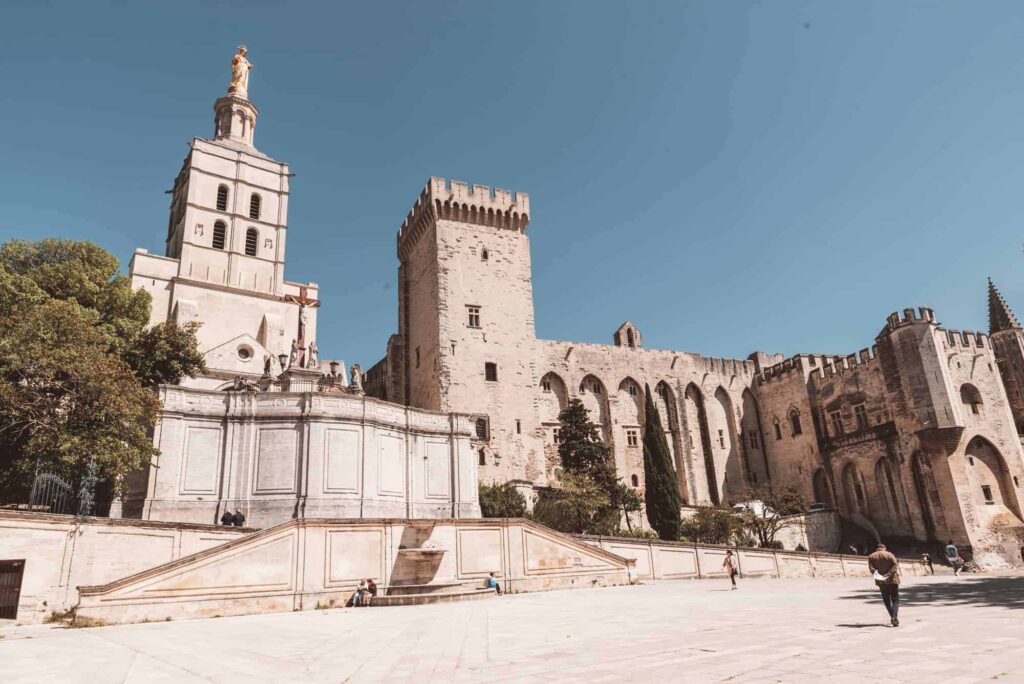
With so many incredible things to do in Avignon, you’ll have no trouble filling your time in this charming Provençal city. Whether you’re staying for a few days or a few weeks there are boundless opportunities to fall head over heels with one of France’s most loved cities.
Pin this for later!
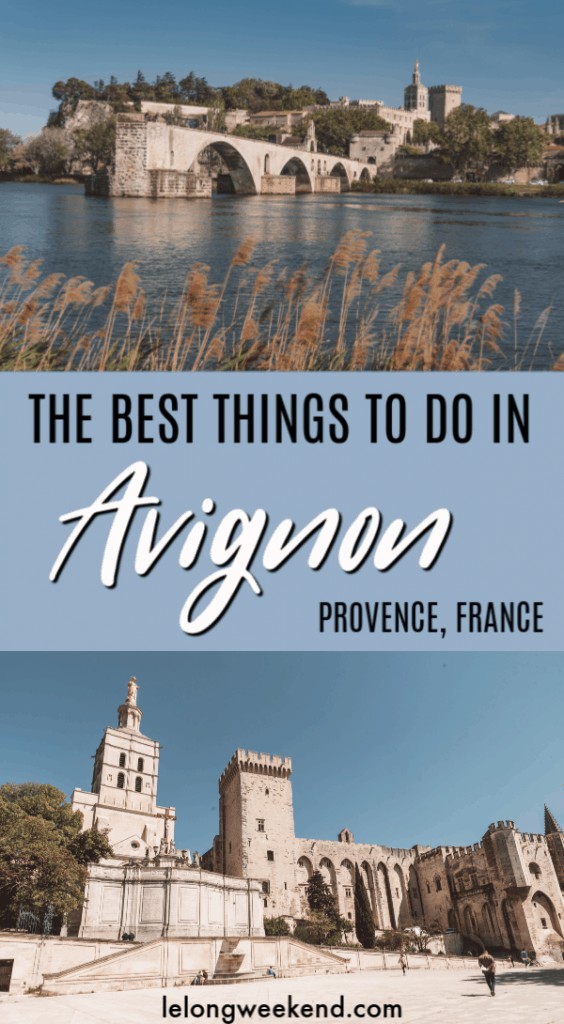
Similar Posts
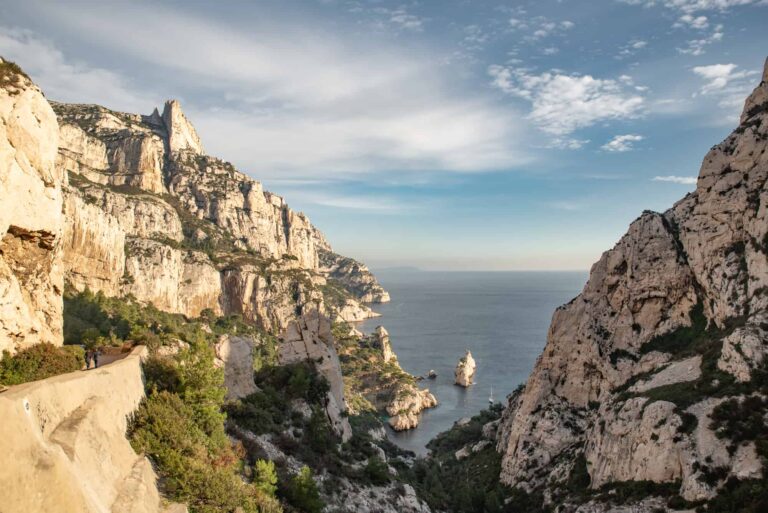
Hiking to Calanque de Sugiton in Marseille, France
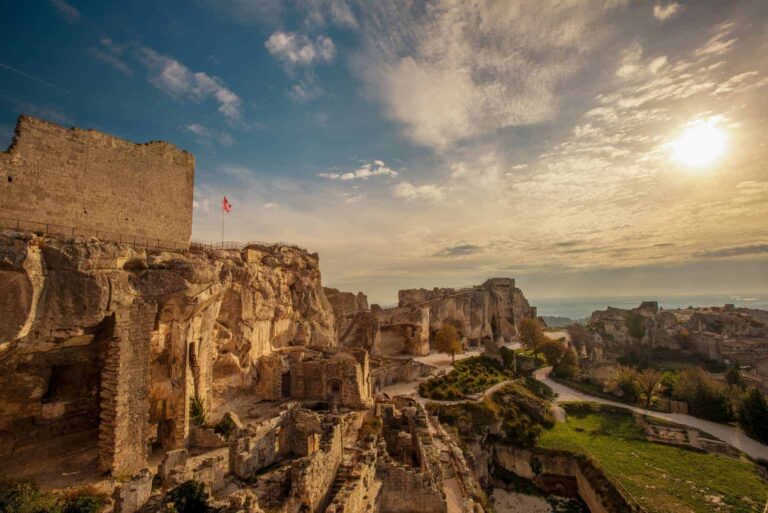
The Perfect Southern France Itinerary – 7 Days in Provence
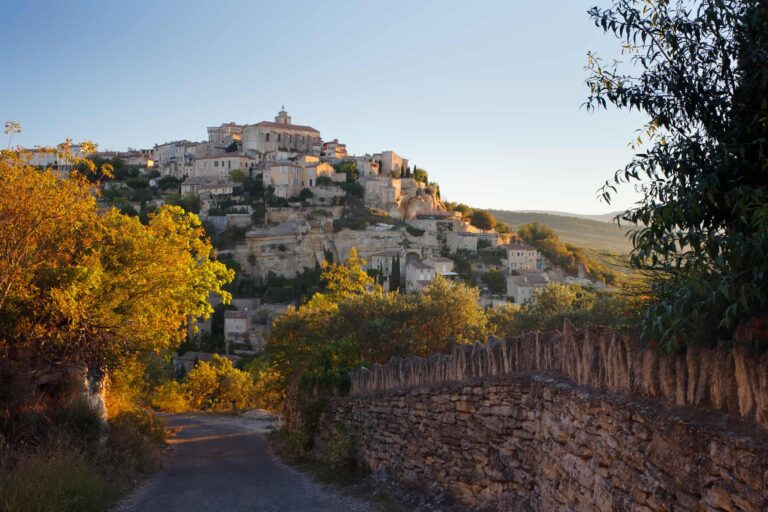
Guide to Gordes, France – Hilltop Village in Provence
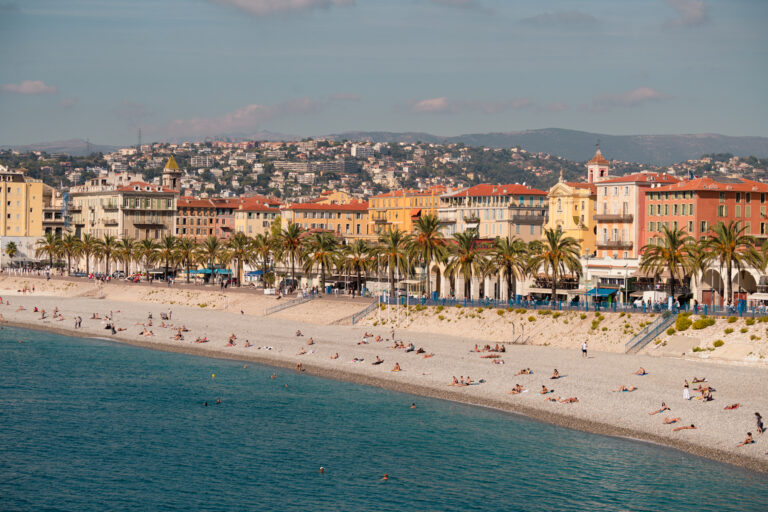
Best Things to do in Nice, France
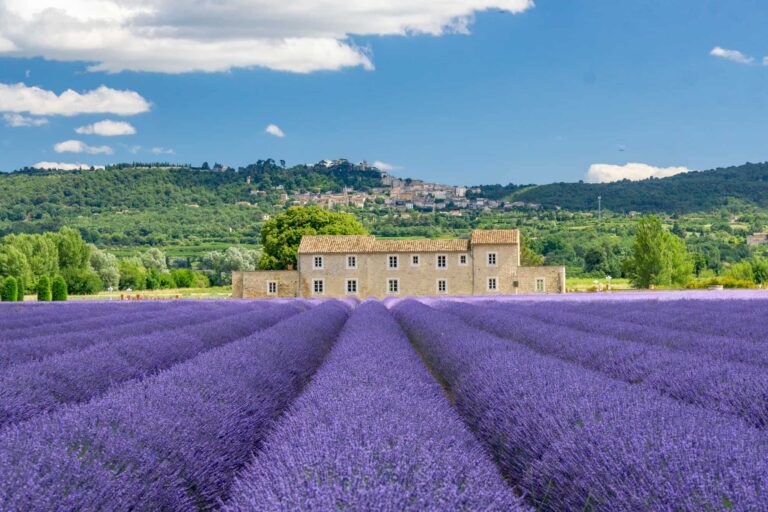
Visiting the Luberon Lavender Fields of Provence, France
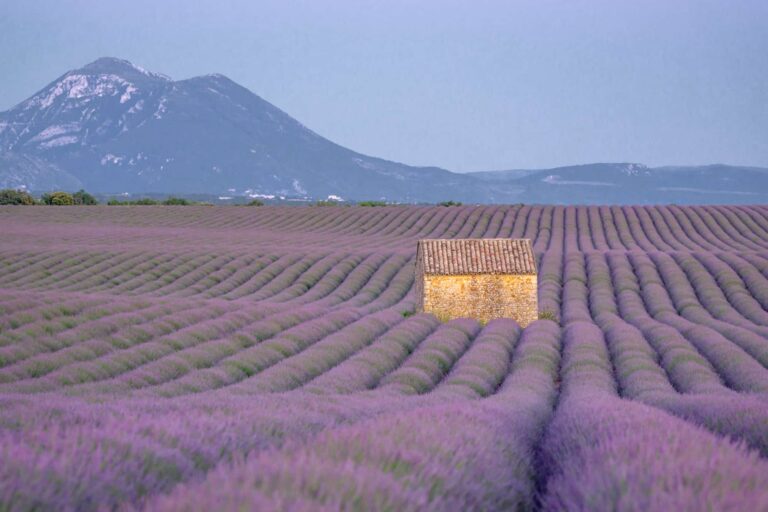
The Best Lavender Fields of Provence, France – 2024 Guide
Such a great and informative post! I visited last year with my other half and we loved it. We actually went slightly out of season (March) and really struggled to find good restaurants in the evenings – so many were closed at that time of year which was a shame but wouldn’t stop us from returning. I’ll make a note of the places you suggested so we can try next time 🙂
Loved this article, very informative. THANK YOU!
Leave a Reply Cancel reply
Your email address will not be published. Required fields are marked *
This site uses Akismet to reduce spam. Learn how your comment data is processed .

Home » Travel Guides » France » 15 Best Things to Do in Avignon (France)
15 Best Things to Do in Avignon (France)
In the 14th century Avignon was the most important city in Europe: It was the seat of the Catholic church, represented in spectacular style by the Palais des Papes, the largest gothic building in the world.
This period furnished Avignon with a glorious cityscape of gothic and renaissance buildings that today are protected as a UNESCO site. The Pont Saint-Bénézet for example has a special place in French culture, while there’s also an assortment of art and history museums that will keep inquiring minds enthralled for days.
Lets explore the best things to do in Avignon :
1. Palais des Papes

You can’t comprehend the scale of the 14th-century Papal Palace until you see it in real life.
Just to trying to convey the size, you could fit four gothic cathedrals in here and there are 24 rooms to visit on the tour.
It’s the marquee attraction in Avignon’s World Heritage site and one of France’s most famous and valuable historical buildings.
Get the audio-guide for the full story, and pause in the papal apartments with walls adorned with frescoes painted almost 700 years ago by the gothic artist Matteo Giovanetti.
2. Pont Saint-Bénézet

Known to all as the Pont d’Avignon, the mythic bridge is from the late-12th century, linking France with Papal Territory.
It was positioned on the tightest part of the bend in the Rhône to lessen its exposure to the river’s notorious strong currents.
Originally there were 22 arches, of which four remain today, and the bridge was 915 metres long, sensational dimensions for the time it was built.
Over the next few hundred years the bridge was damaged and rebuilt by flooding, until finally a catastrophic flood in the 17th century carried off most of the arches.
What remains is beautiful though, and you can visit the gatehouse that defended the crossing, the stranded western terminal, the Tour Philippe-le-Bel and the Chapel of St. Nicholas above the second arch.
3. Place du Palais

The wide open space that sets off the Papal Palace isn’t here by accident.
It was laid out by the antipope Benedict XII in the early 15th century, when the winding streets around the palace were razed to enhance the grandeur of the structure.
On the square you’ve got the perfect view of the palace, as well as the renaissance Petit Palais, Avignon’s romanesque cathedral and the Hôtel des Monnaies (mint), which was renovated in the baroque style in 1619.
4. Collection Lambert

Collection Lambert is one of Avignon’s newer art museums and was founded in 2000 by the art dealer Yvon Lambert as a space to display the works he had donated to the French government.
The galleries are set across two marvellous 18th century Hôtels.
The museum expanded dramatically in 2009 when Lambert made another donation of 560 pieces, the largest gift of art to France since Picasso’s posthumous donation in the 1970s.
The art on show is contemporary, with photography, video, paintings and sculpture from the 1980s up to the last few years from the likes of Cy Twombly, Anselm Kiefer and Nile Toroni.
Temporary shows are put on in the Hôtel de Caumont, while the Hôtel de Montfaucon has the permanent collection.
5. Place de l’Horloge

Avignon’s main square is where you’ll find the city hall and opera house.
Place de l’Horloge is named after the Avignon’s gothic clock tower, but this can actually be quite tough to spot on the square as it’s hidden behind the newer neoclassical city hall buildings.
In the summer nearly half of Place de l’Horloge is taken up by rows of seating for the line of restaurants that spans the entire length of the square.
There’s a carousel for kids, while in December the Christmas mark is held in front of the city hall.
But the ideal time to be here is in July when public performances for the OFF theatre festival take place under the square’s plane trees.
6. Basilique Saint-Pierre d’Avignon

Local folklore has it that this church’s predecessor was destroyed by the moors in the 7th century.
The current gothic building was started in the 1300s during the papacy of Innocent IV, who was the fifth Avignon Pope.
Before you enter, take a little time to appreciate the monumental wooden tours, sculpted from walnut in 1551by Antoine Volard.
There’s a trove of art to see inside too, like the gilded choir from the 1700s, renaissance and baroque paintings, as well as the 15th-century relics of Saint-Pierre de Luxembourg, with his actual cardinal’s robes and hat.
7. Petite Train

If you don’t mind everybody knowing you’re a tourist, Avignon’s road train is a useful way to see the main sights but also get your bearings in a city that can be puzzling for first-timers.
It will take around 40 minutes and covers the famous bridge, the picturesque streets and neighbourhoods around the centre, the Rocher des Doms on the left bank of the Rhône and, naturally, the Palais des Papes.
The train is a particular favourite with older visitors, families with toddlers and anyone with limited time on their hands.
8. Île de la Barthelasse

At 700 hectares the Île de la Barthelasse is one of Europe’s largest river islands.
It belongs to Avignon and is connected to the city by the Pont Daladier, although you might find it more fitting to catch the free ferry across the Rhône.
The island is mostly peaceful orchards with only clusters of houses because a few times every century there’s a catastrophic flood.
The highest point of the island is just 18 metres; it’s what makes the Île de la Barthelasse vulnerable to inundation, but so enjoyable to discover on two wheels.
Hire a bike in the summer and bring a picnic to while away a few hours on the banks of the Rhône.
9. Musée Calvet

Open to the public for more than 200 years the Calvet Museum was founded after the local doctor and collector Esprit Calvet donated his art, library and cabinet of curiosities to the city of Avignon.
This diverse collection has since been expanded by donations from a host of patrons, and contains ancient archaeology, fine art, a wide array of decorative art and ethnological artefacts from Oceania, Asia and Africa.
There’s a serious amount of interesting stuff to get through, but the part many come to see is the Egyptology department with a sarcophagus, canopic jar and offering table.
10. Rue des Teinturiers

This old street traces the Vaucluse Canal and is painfully cute.
Rue des Teinturiers was the intense centre of Avignon’s silk spinning and dyeing industry from the 1300s up to the 1800s.
There are still charming clues in the form of four water-wheels mills suspended from the embankment next to the water.
The beautiful stone houses on the other side of the canal are linked to the cobblestone street by little bridges, and the whole route is shaded by tall old plane trees.
Look out for the Maison du IV de Chiffre, one of Avignon’s oldest mansions, as well as the home Jean-Henri Fabre, the revered 19th-century entomologist, at no. 14.
11. Musée du Petit Palais

Part of the same ensemble as the Palais des Papes is a smaller renaissance palace on the north side of the square.
If it looks a bit like a fortress that’s because it had been a citadel during the Western Schism that followed the Avignon Papacy.
The palace has barely changed since the start of the 1500s, when the future Pope Julius II revamped the building and added his coat of arms to the south facade, still visible above the entrance.
The Petit Palais is just the right building for 327 paintings and 600 sculptures by Italian and French artists from the gothic and renaissance periods.
Nearly all were commissioned for churches around Avignon, many from the 14th century during the Avignon Papacy.
12. Musée Angladon

Jacques Doucet was a Parisian tailor active at the turn of the century and regarded as one of the pioneers of fashion design.
During his lifetime he amassed an immense art collection, including world-famous pieces like Picasso’s Demoiselles d’Avignon, displayed as New York’s MoMA. Doucet’s heirs founded this museum in a fabulous early-18th-century mansion in the middle of Avignon to exhibit the remainder of Doucet’s paintings.
So you can revel in the palatial setting as you view works by Degas, Sisley, Cézanne, Picasso, Manet, Derain and Modigliani, as well as the only van Gogh painting hanging in Provence.
13. Avignon Les Halles

Every morning from Tuesday to Sunday some 40 merchants set up their stalls at this superb covered market on Place Pie.
If you’re renting an apartment you needn’t look any further for your food shop: There’s seasonal meat, fish, fruit and veg, as well as wine, olive oil, herbs, cheese and charcuterie from around the region.
Amateur cooks need to make sure they’re here on Saturdays as this is when the market welcomes prominent local chefs to its designated exhibition space.
You can watch them work as they put on cooking demonstrations and if you’re lucky you’ll get to taste their creations.
14. Pont du Gard

What could be Roman Gaul’s most photogenic ruin is 25 kilometres to the west of the city.
The Pont du Gard is magnificent, but it’s astonishing to think that it’s just a fragment of a system that once spanned 50 kilometres, descending just 17 metres on its route from Uzès to Nîmes.
What’s more it was made in just five years.
The 275-metre-long, 50-metre-high section built to cross the Gardon River has astounded people for two millennia, and you’d be remiss not to see it if you’re in Avignon.
On the site is a compact museum of Roman history with kid-friendly displays, and a video explaining how this work of ancient engineering was undertaken.
15. Les Baux de Provence

Just 30 kilometres south of Avignon, tucked in the magical countryside Alpilles, Les Baux de Provence is one of the “most beautiful villages in France”. It’s a tiny hillside settlement of houses bunched together on steep slopes, dwarfed by large slabs of limestone rock.
Even higher is the Château des Baux, a ruined fortress built in the 900s, promising a fun time for kids with its full-size recreations of siege engines.
They’ve got the largest trebuchet in Europe, flinging missiles all day long in summer.
Also local is the Carrières de Lumières, a multimedia art experience with the iconic works of a chosen artist (in 2016 it was Chagall) projected onto the high faces of a former quarry.
15 Best Things to Do in Avignon (France):
- Palais des Papes
- Pont Saint-Bénézet
- Place du Palais
- Collection Lambert
- Place de l'Horloge
- Basilique Saint-Pierre d'Avignon
- Petite Train
- Île de la Barthelasse
- Musée Calvet
- Rue des Teinturiers
- Musée du Petit Palais
- Musée Angladon
- Avignon Les Halles
- Pont du Gard
- Les Baux de Provence
Explore Avignon

Plan Your Trip to Avignon: Best of Avignon Tourism
Essential avignon.

Trending in the forums
Avignon Is Great For
Wine tastings.

Historical Tours

Cultural Tours

- Hotel d'Europe
- Hôtel La Mirande
- Hotel de L'Horloge
- Hotel Garlande
- La Divine Comedie
- Fou de Fafa
- La Sou' Pape
- Restaurant Avenio
- Restaurant Hiely Lucullus
- Palais des Papes
- Avignon Les Halles
- Rocher des Doms
- Street of Dyers (Rue de Teinturiers)
- Musee du Petit Palais
- Provence Highlights Full-Day Tour from Avignon
- Chateauneuf du Pape wine tour
- Châteauneuf du Pape Wine Day Tasting Tour including Lunch from Avignon
- Provence Cru Wine Small-Group Half-Day Tour from Avignon
- Afternoon Wine Tour to Chateauneuf du Pape from Avignon
France Travel Blog
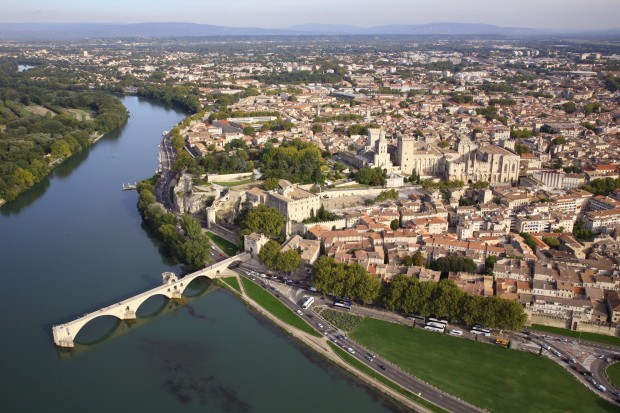
Avignon Travel Guide
Famous for its walls, among other things, the Avignon is located in south-central France in the region of Provence. The city used to be the seat of the papacy for about 67 years. Today, it is one of France’s leading tourist destinations and home to some of the most brilliant museums and splendid architecture. Place de l’Horloge is the city’s central square while the Pope’s palace is another attention-grabbing landmark. Avignon is one of the great French cities and I hope that this travel guide will help you explore it.
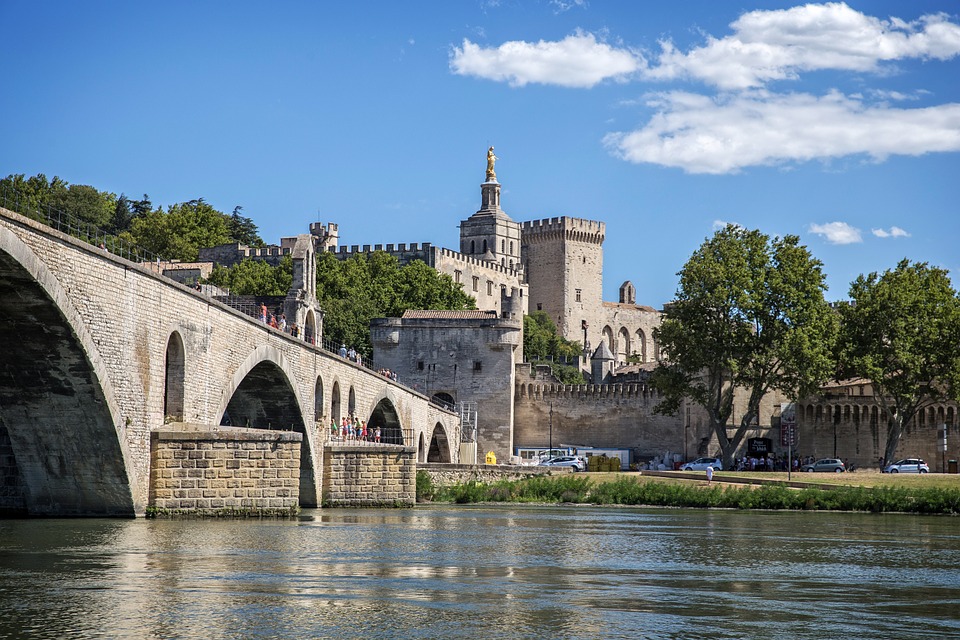
Towering above the majestic Rhône river, Avignon was the home of the pope from 1309 to 1377 as seven popes ruled the Catholic world when Italy was deemed highly unsafe. Between 1334 and 1335, this vast and rich structure was built as it is revered as the largest Gothic palace in the world. It served as both a fortress and palace.
Here is a Detailed Travel Guide on What to See and Do in the city of Avignon:
Avignon’s museums offer a tremendous array of collections. Be lost in the world of prehistory at the Musée Lapidaire (Lapidary Museum). There you will discover paintings from the Middle Ages at the Petit Palais museum. Fine arts at the Musée Calvet. The impressionists at Angladon. Decorative arts at Musée Louis Vouland (Louis Vouland Museum) and modern art at the Collection Lambert.
The city also has a well-known theatre festival, as it is the host for contemporary works in the performing arts. Also, Avignon is an essential center for culinary peculiar to the Provence region. Illustrious chefs prepare local and innovative menus in alluring restaurants throughout the city. And you can have a great time on a wine tour as the city is the capital of the Côtes-du-Rhône wines, as you relish every taste.
Accommodation
Throughout the city are fascinating attractions that will remind you of how beautiful France is. And although there are many good hotels in Avignon, they get quickly booked-up when the summer tourist season begins.
How to get there
Avignon is easy to travel to by train from Marseille, Paris, and other European cities. And although it does have its own airport, lots of visitors arrive through the Marseille Provence airport.
Palais des Papes
You cannot apprehend the scale of the 14th-century Papal Palace unless you see it in real life. In trying to describe the size; you could fit four gothic cathedrals in there, and it has 24 rooms to visit on the tour. The Palais des Papes is the biggest attraction in Avignon’s World Heritage site and one of France’s most popular and priceless historical buildings.
You can secure an audio-guide for the full story, and pause in the papal apartments with walls decorated with frescoes paints almost 700years ago by the gothic artist Matteo Giovanetti.
Musée du Petit Palais (The Petit Palace Museum)
Among the cast as the Palais des Papes is a smaller renaissance palace on the square’s north side. It slightly has the likeness of a fortress because it used to be a citadel during the Western Schism that trailed the Avignon Papacy. As you will see, the palace has hardly changed since the beginning of the 16th-century; when the future Pope Julius II furbished up the building and added his coat of arms to the south façade.
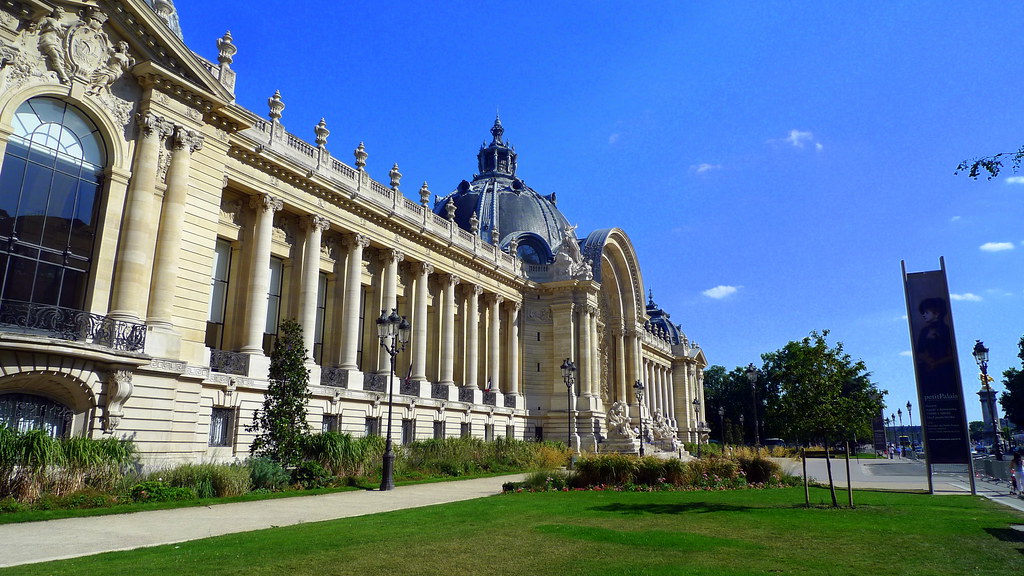
The museum houses about 337 paintings and 600 sculptures by Italian and French artists from the gothic and renaissance eras. The pope bought it in 1335 as a house, and it was used as a lodge for distinguished visitors (like Cesare Borgia in 1948, Francis I in 1533, and the Duke of Orleans in 1660). Strolling past the art, you will see how specific art movements developed from the Siennese School of the early period to the Renaissance developed. And if you are a lover of 15th-century European arts, there are lots to see here; from paintings to sculpture.
Old Town of Avignon
Walking tours can be breathtaking, especially when you stroll in a group. It is always pleasant to navigate a historical place as you see engaging, attractive spots. Walking in the old Avignon can be everything, and that could be the height of your tourist’s adventure. The old Avignon extends around the imposing Palais des Papes. And you can pick a map before setting off along the narrow cobbled streets which fill the old town. It used to be secured by the circular wall as you will see.
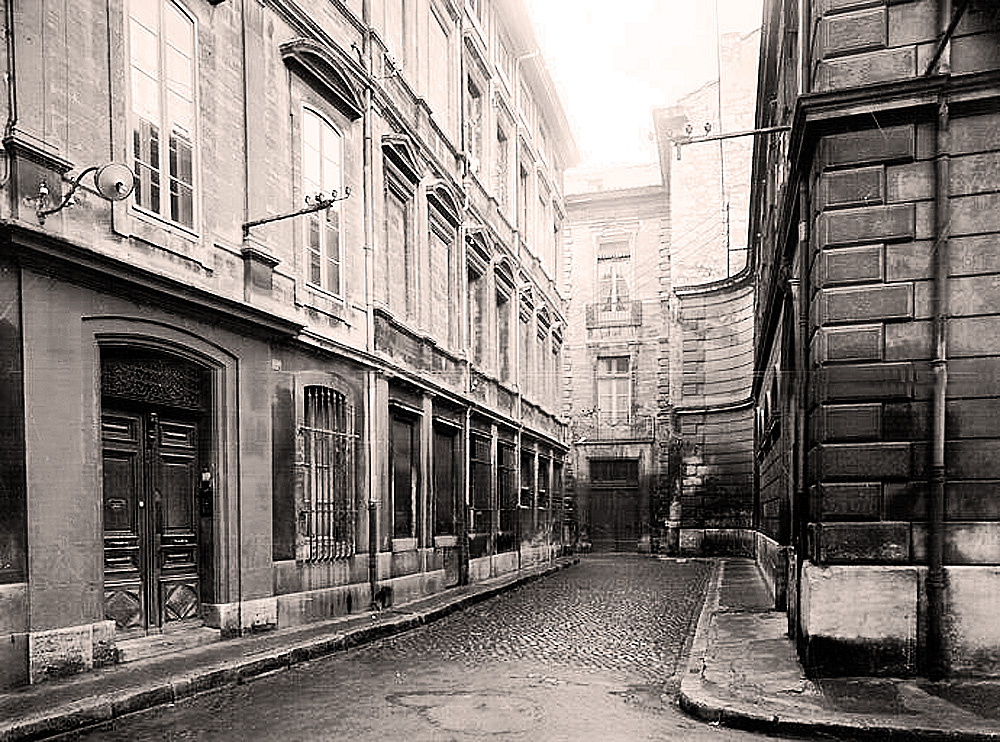
Do not miss King René’s house in the rue Roi- René. The rue des Teinteuriers which follows the river Sorgue, offering the waters that the 18th and 19th-century cloth dryers who lived there needed. Do not forget the Quartier de la Balance that flows to the Pont Bénézet, and the Place de l’Horloge, an enormous square shaded by trees with theatre, town hall, and many pavement cafes. You can also walk a little further to the 15th-century Palace du Roure for the courtyard and gateway that you can visit.
Rocher des Doms Park
How about a trip to adore nature? You will find this fantastic park, an oasis of green peace, north of the Palais des Papes. Find your way past the well-mowed lawn and fountains to the summit for a fantastic view of Avignon and the river. Just below you is the embellished Madonna gleams on the tower of the Cathedral Notre-Doms in front of the Pope’s Palace. You can get everything you need for a picnic in the Halles Market Place. It is comfortably poised while you eat some cheese, fresh bread, with some wine; overlooking the shining city below.
Petit Train
If you do not mind everyone staring at you as a tourist (not in a weird way though), the road train is a handy way to see the city’s landmarks. Also, that will help you find your way around a city that can be confusing for some visitors.
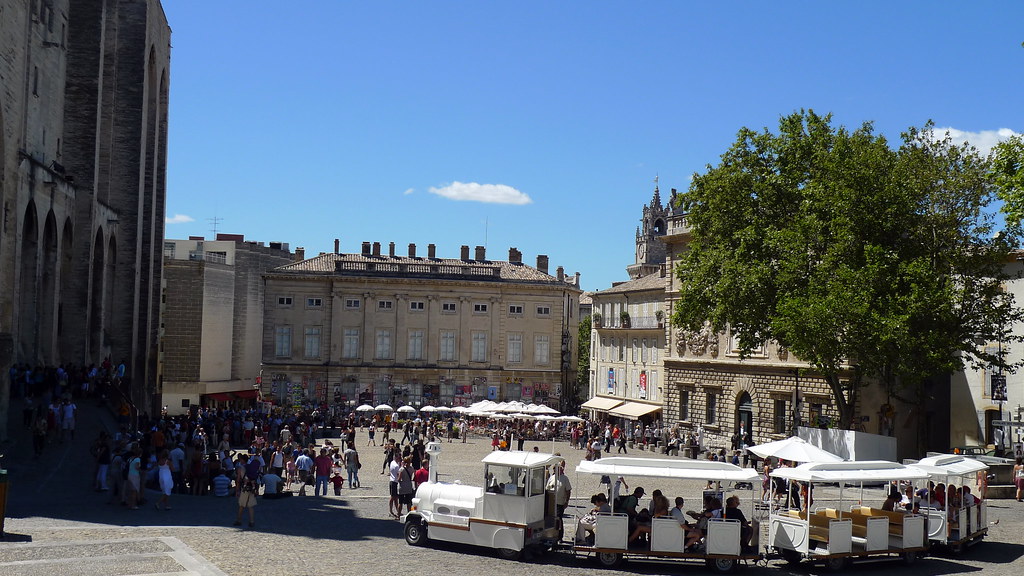
Covering the famous bridge, the picturesque streets, and neighborhoods around the center, and the Rocher des Doms which is on the left bank of the Rhône would take about 40 minutes.
Île de la Barthelasse
Here is another top spot you should add to your itinerary before taking on Avignon. With 700 hectares, the Île de la Barthelasse is one of Europe’s largest river islands. It belongs to the city and is linked to Avignon by the Pont Daladier. Although one might find it more fitting to grab the free ferry across the Rhône.
With peaceful orchards with only clusters of houses, the island is mostly quiet. The island’s highest point is 18 meters, and as such, the Île de la Barthelasse is exposed to the current. Hiring a bike in the summer and having a lavish picnic at the banks of the Rhone will be a brilliant idea.
Rue des Teinturiers
This was the flourishing center of Avignon’s silk spinning and dyeing industry from the 14th-century to the 19th-century. You will still find enchanting clues in the form of four water-wheels suspended from the bulwark next to the water. The gorgeous stone houses on the other side of the canal are connected to the cobblestone street by little bridges. And, the entire way is shaded by tall old plane trees. Do not forget to visit the Maison du IV de Chiffre. It is one of Avignon’s oldest mansions, and the home of Jean-Henri Fabre, the respected 19th-century entomologist at no.14
Basilique Saint-Pierre d’Avignon
According to a local folktale, the Basillique’s Saint-Pierre d’Avignon church’s predecessor was destroyed by the Moors in the 7th-century. The gothic buildings that are currently at the site were started in the 14th-century during the papacy of Innocent IV, who was the fifth Avignon Pope.
Just before you make your way into the church, take a little moment to adore the massive wooden tours. They were sculpted from walnut in 1551 by Antoine Volard. You will also find a wealth of art to see inside as we, like the decorated choir from the 18th-century, renaissance, and baroque paintings, and the 1400s relics of Saint-Pierre de Luxembourg with his real cardinal’s robes and hat.
Pont St-Bénézet
This site is popular among both visitors and locals. It is also known as the Pont d’Avignon, the mythic bridge from the 12th-century connects France with the Papal Territory. The bridge was positioned on the tightest part of the bend in the Rhône to minimize its exposure to the river’s cruel, strong currents.
There used to be 22 arches, of which you will see four today, and the bridge was 915 meters long- an impressive length for the time it was built. After a few hundred years, the bridge was destroyed by flood and rebuilt until an unfortunate flood in the 17th-century carried off most of the arches.
However, in the midst of the ruins is a piece of beauty. You can visit the gatehouse that defended the crossing, the stranded western terminal, the Tour Philippe-le-Bel and the Chapel of St. Nicholas on top of the second arch. In addition, the new museum show films and interactive media that display how the bridge morphed over the centuries.
Musée Calvet
The Calvet museum has been open to the public for over two centuries. That was after Esprit Calvet, a local doctor and collector, donated his art, cabinet of curiosities, and library to the city of Avignon. This diverse collection has since been expanding by donations from many collectors and contains ancient artifacts, an array of decorative and fine art, as well as cultural artifacts from different parts of the world.

There is even a considerable amount of exciting things to see, but the part many come to see is the Egyptology department. Among other things, they display a sarcophagus, canopic jar, and offering table. You will also see sculptures and silverware sit with French, Flemish, and Italian paintings from the 16th to the 19th century.
Markets and Special Shopping in Avignon
The contemporary covered market, Les Halles, in place Pie, is the perfect spot for some heavy shopping. About 40 different stalls sell the local produce of Provence from Tuesday to Sunday, from 6 am to 1 pm. The flower market at the Place des Carmes opens on Saturday mornings and the flea market on Sundays. And from June to September on the 3rd Monday of each month in the Allees de l’Oulle; a food market brings small scale producers to the city. You are sure to experience a massive array of food on weekends at St-Michel and place Crillon. You can start your shopping spree with some chocolates at one of the best chocolatiers, Puyricard. Also, it has branches all over Southern France.

Avignon Events and Festivals
The city hosts cultural fares, musical fests, art exhibits, and a lot of other social events that attracts visitor from far and near. Of all the events that the city hosts, the Avignon festival is the most popular, both locally and globally. This festival kicked off sometime in 1947 Jean Vilar, the actor-director, whose aim was to bring theatre to the people with top actors like Jeanne Moreau and Jean Negroni.
The Avignon festival is observed every year in July. The now 3-week-long event dominates the central courtyard of the Pope’s Palace which has a 2000 capacity. Featuring over 40 different performances of theatre, dance, fine arts exhibitions, and music throughout Avignon, the festival’s appeal is quite huge. In fact, companies from around the world have performed works from Shakespeare to Mikhail Bulgakov, Euripides to Chekhov. Another event is the Avignon Public Off which takes over 100 smaller locations.
Avignon Travel Blog – Conclusion
Avignon is full of history and a vibrant city with a lively social and cultural life. Whether it is the cinemas or museums, shops, wine, cuisine, events, tourists always come in their troves for one attraction or the other. Avignon is that welcoming.
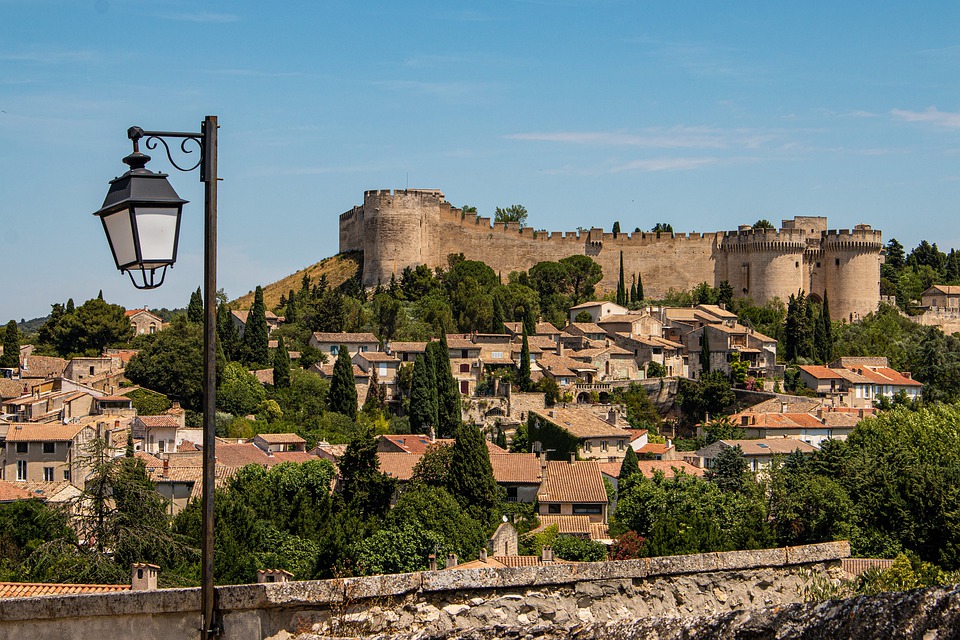
Peter is the editor of France Travel Blog. He has traveled to France many times and is ready to share the knowledge in this travel guide for France.
Related Posts
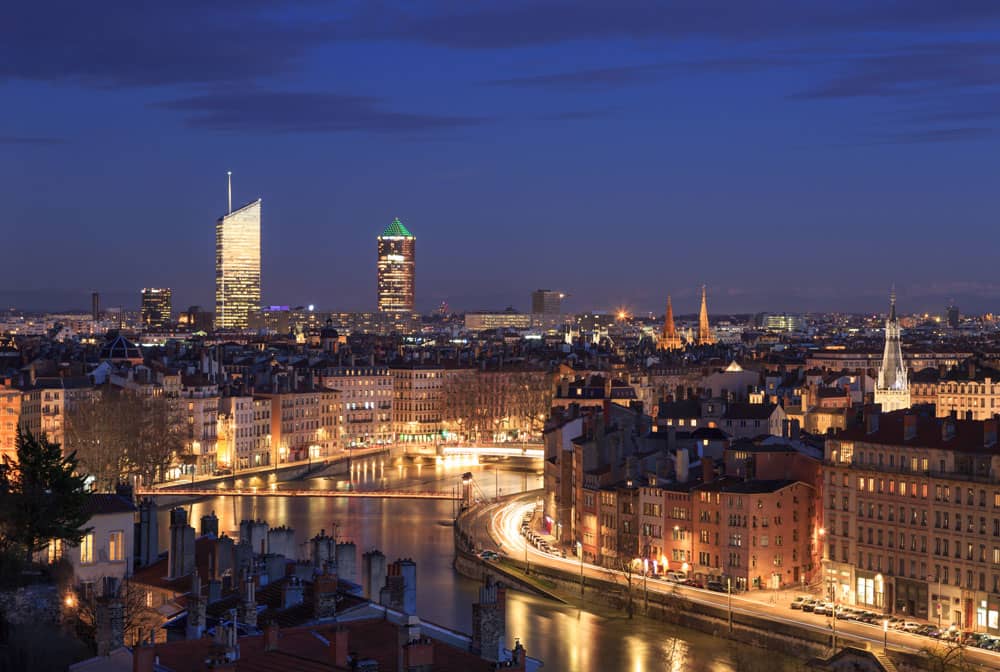
Lyon Travel Guide

Gordes Travel Guide: Tips for Visiting Gordes
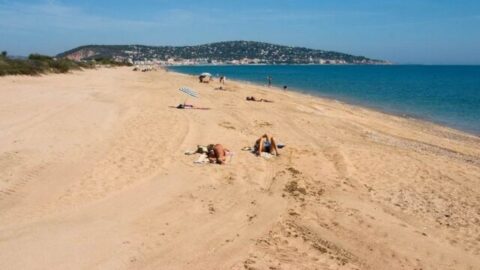
Best Beaches near Sete

10 Places To Visit On Your Next Europe Travel
Recent posts.
- Marseille Unveiled: Immerse Yourself in the Charm of the Mediterranean with a Captivating City Break
- A Beginner’s Guide to Road Cycling
- 5 Things to Look for When Buying Digital Cameras
- How to Take High-Quality Photos: Essential Tips And Composition Rules to Consider
- Can You Drink Tap Water In Paris? (2023)
- Entertainment
- Things To Do
- Travel Guides
- Travel Ideas
Social Links
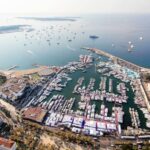
Best Beaches Around Cannes

Visa Requirements to Travel to France from Ukraine

What is Loire Valley Famous For

Using France To Inspire Your Home Design

Best Day Trips From Nice
Hit enter to search or ESC to close.
- United Kingdom
- Curated Stays
- Wine Travel
- About Isabelle
- Work with Us
23 Captivating Things to Do in Avignon: 2024 Insider’s Guide
- Isabelle Hoyne
- February 29, 2024
** Disclosure: some of the links on this site are affiliate links and should you make a purchase through these, I may receive a small commission at no extra cost to you. Thank you for your support!**
Uncover Avignon’s charm with our insider’s guide to the top 23 things to do in Avignon. From historic wonders to culinary delights, immerse yourself in this enchanting city. Explore attractions, indulge in local flavours and create unforgettable memories, discovering the essence of Avignon in every step.
Essential resources for your trip to Avignon
Top-rated tours and experiences: ☆ Avignon Walking Tour including the Pope’s Palace ☆ Tickets for Palais des Papes & Pont d’Avignon ☆ Provence in One Day Small Group Day Trip from Avignon ☆ Provence Lavender Full Day Tour from Avignon ☆ Chateauneuf du Pape wine tour Cultured Voyages recommended accommodation: Le Bristol ( well located, well designed ) // Hotel De Cambis ( rave reviews, stylish decor ) // L’Observance Bed & Breakfast ( gorgeous guesthouse with pool ) // Les Précieuses Suites & Sp ( gorgeous apartment with spa bath )
We arrived to Avignon in late March, having passed two sun-drenched months in vibrant Sevilla and got a bit of a shock.
The weather was decidedly cooler, thanks to the blustery Mistral wind which blows through this part of Southern France and sunny days were frequently interspersed with much drabber ones – truth be told, we’d hit Provence a little too early in the year.
However, as the weeks went on the beauty of Avignon gradually unfurled itself, bit by bit. Delicately pink cherry blossoms came and went and young, light-green leaves filled naked branches begging for new life.
Avignon had well and truly been awoken from its winter slumber, and its canvas had been painted anew with the brushstrokes of spring. Golden sunshine shone its light into the winding old streets, with ancient stone walls basked in light revealing intricate details and carvings made on golden stone – Avignon, for sure, is a city where it’s always worth looking up.
As each week went on, the streets filled with more and more people, gathering in squares shaded by elegant trees to meet, eat and drink.
With our patio doors flung open, sounds of spring found their way into our little apartment – the chirping of birds, rustling leaves, raucous laughter too, sometimes, as well as the ever so faint trickle of the old canal that meanders along historic Rue de Teinturiers nearby.
What brought us to Avignon originally were its more famous trappings – the imposing Palace of the Popes, the mighty city walls that surround the city, its famous bridge that leads to nowhere – but it was other things that made us fall in love with Avignon.
Things like its oddly-shaped squares, lined with cafés that were perfect for languid hours of people-watching. Or the kindness of its citizens, who patiently waited for me to butcher their language with my shoddy, school-girl French before coming to my aid in perfect English, many times over.
Also, how you could never really get lost in Avignon – somehow, someway, you would always stumble upon some narrow, well-placed, time-worn slip between buildings, which would eventually lead you down a path to one of those aforementioned, oddly-shaped squares.
Avignon is a special city, dusted with the magic of the South of France, along with its own specific brand of enchantment that’s been woven deep into its storied fabric. Take your time to explore it, take your time to read this blog post and discover the very best things to do in Avignon.
Table of Contents
An introduction to avignon, the best things to do in avignon, france, avignon attractions on the map, practical matters for visiting avignon, what to do in avignon – faq, why visit avignon.
Avignon is a city that boasts a rich history, centred around the majestic Palace of the Popes, which is a must-see attraction for anyone visiting the region.
But beyond its historical significance, Avignon is a vibrant university town, with a bustling arts scene that comes to life during the annual festival. The city’s architecture is truly stunning, with a mix of Gothic and Romanesque styles that give it a unique character.
And for those who love to explore, the compact city centre is filled with quaint shops, boutiques, and winding streets just waiting to be discovered.
As for dining options, Avignon offers an impressive selection of high-quality restaurants with diverse menus to satisfy any taste – I can more than happily testify to this, having spent a good number of weeks contentedly eating my way around the city.
A short history of Avignon
Avignon has a long history, with evidence of settlement dating back 5,000 years. It was once the stronghold of the Gallic tribe of Cavares, and later became the Roman city of Avennio.
In the 12th century, it gained independence and flourished in trade, but lost its independence in the 13th century after being occupied by King Louis VIII. This paved the way for the city’s later role as the seat of the papacy.
In 1309, Pope Clement V chose Avignon as the location for the papal residence, partly due to its central location within Christendom as well as the instability in central Italy at the time.
The papacy remained in Avignon for over 60 years, with seven popes residing there during that time. The papal presence in Avignon expanded significantly after the fourth pope, Clement VI, purchased the city in 1348.
Despite calls from St. Catherine of Siena and others for the popes to return to Rome, the papacy remained in Avignon until 1377, and the city continued to be one of the residences of the papacy during the Great Schism.
Having been governed by papal legates until then, Avignon was eventually annexed by the French National Assembly in 1791, and there was bloodshed during the seizure of the city.
The Palais des Papes, then an eight-towered fortress that served as the papal residence, was damaged during its seizure and was subsequently used as a barracks from 1822 to 1906.
Today, Avignon is an administrative and commercial centre, specialising in fruits and vegetables. The city’s economy thrives on tourism and light industries.
Learn about Avignon’s history on a walking tour
Avignon is so incredibly full of history, and taking a walking tour is a wonderful way to fully understand its history and cultural significance.
By exploring on foot, you can properly soak up the atmosphere of this UNESCO-listed city and appreciate its ancient Roman roots as well as its role as the seat of the Papacy in the 14th century.
This 3-hour walking tour of Avignon and the Pope’s Palace is a fantastic option for those looking to dive deep into the city’s history and beauty.
Led by an expert guide, the tour takes visitors on a journey through the heart of medieval Avignon, providing a comprehensive understanding of the city’s development and its place in European history.
One of the highlights of this tour is access to the Pope’s Palace, which is often subject to long waiting times during high season. By having priority access, you can explore the ornate chambers and chapels without wasting time waiting in lines.
In addition to the historical and cultural aspects of the tour, you will also have the opportunity to enjoy panoramic views of Avignon and the Rhône River from the top of the fortified city walls.
The tour concludes with a glass of Côtes du Rhône wine near the Place de l’Horloge, where you can admire the 19th-century architecture.
LEARN MORE | BOOK YOUR AVIGNON WALKING TOUR HERE
Visit the Palace of the Popes and the Musée du Petit Palais
If you’re planning a visit to Avignon, there are two must-see attractions that showcase the city’s rich history and cultural heritage: the Palace of the Popes and the Petit Palais museum.
The Palais des Papes is an imposing Gothic structure that was built over a period of less than 20 years in the 14th century. It served as the residence of the popes who lived in Avignon during the 14th century and is considered one of the most important buildings of its time.
Today, visitors can explore more than 25 rooms that are open to the public, including audience rooms, ceremonial rooms, and the Pope’s private apartments.
You’ll get a sense of the grandeur and opulence of the papal court and the incredible craftsmanship that went into building and decorating the palace.
Before you visit the Palais des Papes, it’s a good idea to stop by the Petit Palais museum. This museum houses a stunning collection of medieval art and artefacts, including over 300 Italian primitives, sculptures from the 12th to the 16th centuries, and significant holdings from the Avignon School.
The museum is housed in a beautiful former palace that was renovated in the late 1400s and is a ‘ Musée de France .’
When you’re ready to visit the Palais des Papes, be sure to take advantage of the histopads, which are digital tablets that really elevated the visit.
With augmented reality, you can see what the rooms of the palace looked like in the 14th century and get a better sense of what life was like during the time of the popes.
I’ve read in other posts that people found the histopads glitchy, but I didn’t find this at all – they worked great and had plenty of information should you wish to read more – I feel like the software may have been improved since the original complaints.
The visit to the Palace of the Popes usually takes about two hours, and in high season, it can be very busy. To avoid long waits, it’s a good idea to book your tickets in advance. Note that admission is free for children under eight years old.
PLAN YOUR VISIT | Book skip-the-line Palace of the Popes tickets here . The Palace of the Popes is open every day, all year round. Beginning of March to end of October, open 9am – 7pm. Slightly later opening and earlier closing outside these months
// Entry to the Petis Palais is free, with the museum closed on Tuesdays. Nov-Feb open from 10am-1pm / 2pm-5pm. Mar-May & Oct open from 10am-1pm / 2pm-6pm. Jun- Sep open 10am-1pm / 2pm-7pm.
Enjoy the atmosphere on Rue des Teinturiers
Rue de Teinturiers is a beautiful and atmospheric street that comes alive at night. It gets its name from the intense textile industry that flourished there between the 14th and 19th centuries.
The street follows the narrow Sorgue river, fed by the waters from the Fontaine de Vaucluse. You can still see four water wheels as testimonies to this past.
In the past, mills were installed in the houses across from each wheel, and the machines were driven by an axle that ran under the street. The demolition of some old premises uncovered one of the drive shafts still with its mechanisms.
The street is lined with old, large stones all carrying unique (and sometimes strange) carvings that decorate the uneven cobbles, and tall shaded trees as the river gently trickles by.
It’s a lovely place to stroll and take in the historical charm of Avignon, especially at night when the street comes alive with restaurants, bars, and cafes.
At the bottom of Rue de Teinturiers, on the corner of Rue des Lices, you can see one of the remaining chapels and the bell tower of what was once one of the largest churches in Avignon in 1226.
Further along the street, in the shade of the sycamores, stands the Grey Penitents’ Chapel, open to the public during mass hours.
This brotherhood, founded by King Louis VIII who visited Avignon in 1226 is the oldest brotherhood in Avignon, and is still active today. Every November 30th, members celebrate a miracle that occurred in 1433.
Despite flooding by the Rhône and the inundation of the Sorgue, the water in the nave remained parted, leaving open a passage by which the penitents could evacuate the blessed sacrament. This strange procession is recreated each year, with penitents making their way up the aisle on hands and knees!
Discover Avignon’s atmospheric squares
I’ve mentioned in the introduction to this post how much I fell in love with Avignon’s many squares. While most guides will recommend Place de l’Horloge as a must-see square, there are plenty of other charming squares worth visiting that trump the heavily-touristed Place de l’Horloge in my opinion.
For example, Place Pie , located in front of Les Halles marketplace, is a lively square full of sidewalk cafes, bars, and brasseries. It’s a real sun-trap and we found ourselves heading here for a drink and to people watch when the sun was out.
Meanwhile, Place des Corps Saints is a foodie’s paradise, with excellent restaurants (like the wonderful L’Agape), a beautiful church, and plenty of shade from stately plane trees.
Just a few streets away from Place des Corps Saints is Place Saint-Didier, my favourite square in Avignon and one which has an unassuming, neighbourhood feel to it. Covered by the shade of some huge trees, this is where the silkworm market used to be, as an inscription on a stone wall tells us today.
There are plenty of shops, cafes, and a charming church to explore here. You’ll find the bakery Violette and speciality coffee shop Tulipe on the edge of this square.
As you walk up Rue de la République, the main street in Avignon, you’ll come across Place de l’Horloge , the city’s main square.
While it’s worth checking out for its lovely carousel mayor’s office, don’t miss the nearby Place du Palais , in front of the Palace of the Popes, which offers a expansive view of the palace, the basilica of Notre Dame des Doms, and the Petit Palais.
In the popular neighbourhood around Rue de la Carreterie, which although close to city centre still feels off the beaten track, you’ll find Place des Carmes , a square with a covered marketplace, thriving theatres, and plenty of restaurants and cafes.
Finally, if you’re looking for a chic square to relax and enjoy a glass of bubbly, head to absolutely beautiful Place Crillon , one of the most bourgeois squares in Avignon, where you can soak up the sun and admire the city mansions and the beautiful Hôtel d’Europe.
It’s especially lovely when viewed with your back to the old city wall.
Walk along the Pont d’Avignon
If you visit Avignon, then you’ll likely catch sight of Saint Bénezet bridge , better known as the Pont d’Avignon . This historic bridge is famous throughout the world thanks to the children’s song “ Sur le pont d’Avignon “.
The bridge was built in the 12th century and originally spanned approximately 900 meters and was made up of 22 arches, making it the only place to cross the Rhône between Lyon and the Mediterranean sea.
However, it was washed away several times by flood waters and was finally abandoned in the 17th century.
Today, all that remains of the bridge are four arches and a chapel dedicated to Saint Nicolas. Despite its partial state, it is classified as a World Heritage site by UNESCO and is a of engineering that was continually being worked on and repaired.
It is also a source of legends and an emblematic monument of the area.
If you visit the Pont d’Avignon, make sure to avail of the multi-media display and audioguide, which offers descriptions based on scientific research about the legends and history of the bridge.
You don’t need to spend a whole lot of time at the bridge – probably about 30-45 minutes in all, but if you’re interested in history then you will enjoy the experience.
PLAN YOUR VISIT | Open daily year round. Opening times vary throughout the year, from 9/10am – 5/7pm depending on the season. Tickets available on the door, but you’re better off purchasing a combined Pont d’Avignon and skip-the-line Palace of the Pope ticket .
Discover some of Avignon’s beautiful religious buildings
With such strong links to the papacy, it should come as no surprise that Avignon is home to several beautiful churches and religious buildings, each with its unique history and architectural style.
One of the most impressive structures is the Basilica of Notre Dame des Doms , located near the Palace of the Popes. It was built in the 1100s and underwent renovations in the 15th and 17th centuries.
The church’s gilded lead statue of the Virgin Mary is an iconic landmark that seems to reach up to the sky and is visible from many points around the city (we even caught a shimmering glimpse when cycling round Barthelasse Island) and you can now explore its grand interior after a two-year renovation.
The basilica is open to the public from September to June, Monday to Saturday, and on Sunday afternoons, with free admission.
Another noteworthy site is the Gothic Notre-Dame Collegiate Church and Cloister .
This church, built under Cardinal Arnaud de Via, houses several paintings and a replica of the famous Pièta de Villeneuve Lez Avignon. Visitors can explore its historic cloister and church free of charge, except during liturgical services.
The Saint-Pierre church is a hidden gem tucked away in a small square. The church’s intricate facade, with richly-carved walnut doors and decorative ornaments, dates back to 1512, while the interior features impressive woodwork, paintings, and an altarpiece.
Visitors can access information at the presbytery, and entrance is free, but no visits are allowed during services.
Other religious buildings include a neoclassical synagogue , which has been rebuilt several times after fires, and the Penitents Gris Chapel , a 16th-19th-century chapel with stunning stained-glass windows and a history dating back to the 17th century.
RELATED READING | Best Day Trips from Avignon for Curious Travellers
Get lost in Avignon’s city centre
When in Avignon, don’t miss the opportunity to explore the city’s rather lovely backstreets. They offer a glimpse into the local pace of life and also reveal the city’s medieval roots.
Wandering through these winding lanes, you’ll come across pastry shops, quaint cafes, interior design stores and tiny galleries, all of which exude a unique charm.
As you stroll through the cobblestone streets, you’ll notice the niches on house fronts and the old-fashioned street signs with names like “Street of the Animal Furriers” and “Hosiery Street”. Each of these names is a reminder of the city’s past and adds further to the overall medieval atmosphere.
Make sure to visit the legendary Rue des Teinturiers, where waterwheels and canals used to power the city’s textile industry.
The medieval Rue Peyrolerie is another worth walking down, as you’ll pass under the buttresses of the Palace of the Popes through a street that is hewn from rock – this street was where the art of boiler-making was practiced in the Middle Ages.
At every turn, history is waiting to be discovered in Avignon’s backstreets.
Find some treasures in Avignon’s boutiques
Shopping in Avignon is an indulgent experience that fashion lovers will certainly appreciate. With an eye for all things stylish, the Avignonnaise have curated a range of luxury boutiques that offer the latest trends and quality pieces delivered with French flair.
The famous Rue Joseph Vernet has been a hub for trendsetters and style-seekers for years, attracting customers in search of the latest fashion.
For those looking for a range of French (and other) designers, the streets of Saint-Agricol and Petite Fusterie offer a range of boutiques that provide a secret alcove for brands like The Kooples, Max Mara, Longchamp, Sandro, Gérard Darel, ba&sh, Maje, Father & Sons and more.
Jewellery and leather goods enthusiasts will not be left out as Avignon also hosts many great jewellers, perfumers, and beauty stores. The array of stores in Avignon offers something for everyone, catering to various tastes and budgets.
Myself (and my mother who visited) spent several happy hours browsing the shops.
Admire Avignon’s unique buildings
Avignon is home to some wonderfully unique buildings. One of the most striking features of some of these structures is their Trompe L’Oeil façades.
Trompe L’Oeil is a painting technique that gives the illusion of three-dimensional objects on a two-dimensional surface. These paintings on buildings create a visual effect that makes it look as if there are statues, columns, or other architectural elements where there are none.
In Avignon, if you look up, you’ll likely start noticing many of these paintings within boarded up windows.
In addition to Trompe L’Oeil, many of Avignon’s buildings have intricately carved decorations over their windows and doors. These carvings are made of stone and depict various characters from history or mythology.
There are also plenty of religious carvings set into niches high up on street corners. They serve as a testament to the skilled craftsmen who built these buildings centuries ago – some look so old and it’s really impressive to think the sculptor’s artwork has withstood both the elements and the test of time.
At night time, many of these over-door carvings are illuminated with LED lights – so keep an eye our for them.
I had a couple of favourites, but one that’s definitely worth looking out for and easy to find is the gargoyle over the doorway of the building directly across the street from the entrance to Le Nid.
Discover Avignon’s exceptional art collections & museums
Art lovers will really enjoy Avignon’s offerings. There are many museums to explore, both free and with an entry fee. What I particularly loved about them is that they are quite small, but well curated, meaning that it’s difficult to reach a saturation point as you can toddle in and out of them as you wish.
Let’s first begin with the museums that charge an entry fee:
Collection Lambert is a must-visit museum for contemporary art lovers. The museum is housed in two 18th-century townhouses in the heart of Avignon and features an outstanding collection of major works from the second half of the 20th century and beginning of the 21st century.
The museum’s collection includes works by famous artists such as Jean-Michel Basquiat, Miquel Barceló, Sol LeWitt, and Bertrand Lavier. The museum also hosts ambitious exhibitions and a varied cultural and educational program.
Musée Angladon is another museum that you shouldn’t miss. It’s a “home that is a museum,” which holds a collection of treasures and has kept the charm of an art-lover’s interior. The museum features works by Modigliani, Cézanne, Van Gogh, Picasso, and many other prestigious artists.
There are several other marvels to discover at Musée Angladon, making it a very worthwhile museum to visit. It was incredible to get so close the paintings and I would highly recommend a visit.
Musée Louis Vouland is located in a magnificent 18th-century private mansion. Visitors are invited to discover a decidedly French taste with furniture, porcelain sets, tapestries, chandeliers, and other pieces of decorative arts from the 17th and 18th centuries.
The museum also hosts high-quality temporary exhibitions each year, and a monthly programme of readings, concerts, thematic guided tours, and other workshops.
Now let’s talk about the free museums:
Avignon is home to five free museums that complement each other well and display several thousand works of art – objects, documents, paintings, sculptures – housed in some of the most beautiful buildings in Avignon. Click here for further information. These museums are:
- Musée Calvet , housed in a listed 18th-century private residence, displays painting and sculpture collections from the 15th–20th centuries, along with Egyptian objects, bas-reliefs, mummies, and more.
- Palais du Roure , another 15th-century palace, which houses a museum of Provençal history and traditions.
- Musée Requien , Vaucluse’s Museum of Natural History.
- Musée Lapidaire , a former Jesuit chapel displaying Etruscan, Greek, Roman, and Gallic antiquities.
- The Petit Palais , home to a wealth of medieval religious art and that I recommend visiting before you head into the Palace of the Popes.
Cycle around Île de la Barthelasse
One of my favourite things that we got up to in Avignon was cycling around Île de la Barthelasse. It offered a fantastic opportunity to experience Avignon’s countryside while being so close to the historical city centre.
It was a super relaxing bike ride in a green setting that offered a perfect escape from the hustle and bustle of the city, which felt a million miles away.
La Barthelasse is a unique place that is worth exploring. It is the largest river island in Europe, covering 700 hectares of farmland that overlooks the Palace of the Popes. The island is rich in woodland that is home to many species of birds, beavers, and otters, providing evidence of preserved nature.
To access Barthelasse Island, you can take a free ferry service that runs every few minutes and gets you across in just two minutes. Once there, you can enjoy the shade of the huge plane trees on the towpath, where you can also get beautiful views of the city.
You can also purchase fresh fruits and vegetables at the Ferme de la Reboule, a local farm, or have lunch beside the water at Le Bercail restaurant, which boasts views of the Pont d’Avignon and the city walls.
For those who are more energetic, you can rent a ‘ Vélopop ‘, a city bike that can be hired from docks located all over the city, and follow one of the signposted cycle routes between apple trees and cherry orchards.
Alternatively, you can rent a better quality of bike for a half or full day. We rented ours from South Spirit Bikes .
Head across the river to Villeneuve-les-Avignon
Villeneuve-les-Avignon, located on the other side of the Rhône River from Avignon, is a charming medieval town with a rich history and plenty to see and do. The town’s origins date back to the tenth century, when a small abbey was built at the top of Mont Andaon.
Villeneuve gradually developed around the abbey, and in the twelfth century, the town erected a protective wall to fend off Avignon’s advances. The Fort Saint-André and Tour Philippe le Bel were built to guard the new frontier for the Kingdom of France.
The arrival of the Papacy in Avignon in 1309 transformed the city, and Villeneuve benefited from the newfound prosperity. Agriculture and wine-growing were developed to meet the needs of the growing population, and magnificent palaces were constructed on the riverbanks.
One of Villeneuve’s most entrancing jewels is the Chartreuse du Val de Bénédiction, founded during the 14th century as a monastery.
The site has been superbly refurbished and is a fascinating place to visit, with its monks’ cells, painted frescoes, cloisters, and church, which houses the mausoleum of Pope Innocent VI.
Other sites of interest include the old town, the museum Pierre de Luxembourg, the chapel of the Pénitents Gris, and the hill of Les Mourgues.
You can climb the Tour Philippe le Bel for good views across to the papal buildings of Avignon, and the Collegial Notre-Dame Church has a cloister and some noteworthy artworks.
The town also has several medieval properties, originally the palaces for the cardinals of Avignon, to admire as you pass. Finally, don’t miss the weekly markets, which take place on Thursday and Saturday mornings.
RELATED READING | Best Things to Do in Arles: From Van Gogh’s Legacy to Ancient Roman Ruins
Take a boat trip on the Rhône
If you’re looking for a unique way to experience Avignon, I highly recommend taking a boat trip on the Rhône River. From April to September, you can hop aboard the Saône and embark on a one hour and fifteen minute outing that showcases some of the most beautiful sites of the Papal City.
During the sightseeing trip, you’ll have the opportunity to see Avignon’s famous landmarks from a different perspective.
You’ll get to admire the wonderful Pont d’Avignon, the majestic Palace of the Popes, the bustling marina, the Rocher des Doms, the elegant Pont Eiffel and the picturesque banks of Barthelasse Island and Piot Island.
You’ll even get to catch a glimpse of Villeneuve-lez-Avignon and the Philippe-le-Bel Tower from a great vantage point. They also offer lunch and dinner boat trips, along with further sightseeing tours to Arles, Tarascon and Villeneuve-lez-Avignon.
MORE INFO | for more information, or to book click here .
Explore the stalls of Avignon Les Halles
If you’re a food lover, then the shrubbery-shrouded Les Halles will likely call out to you during your visit to Avignon.
While not the most beautiful building you’ll ever see, or potentially not the biggest or ‘best’ covered food market you’ll ever come across either, it’s packed to the rafters with the flavours of Provence and allows you to rub shoulders with the locals as they pick up their groceries, or stop in for a glass of wine.
One of the most popular spots in Les Halles is La Cabane d’Oleron , which was always busy any time it was open. Here, you can enjoy celebrated oysters such those from Utah Beach and Fines des Claire, along with mussels, platters and a range of other seafood delicacies.
I loved the atmosphere here – exceptional quality without any ceremony, with deliciously fresh seafood washed down with a glass of chilled white wine.
But there’s more to Les Halles than just oysters. With over 40 vendors offering a wide variety of specialties, you’ll find everything from artisanal cheeses to fresh produce, spices, cured meats, and baked goods. It’s a true paradise for foodies and the energy and friendliness of the vendors is palpable.
Also, if you need a break from perusing, you can always stop by one of the little bars in the market. Locals come here to prop their elbows and enjoy a glass of wine or a coffee, and it’s a great way to soak up the vibrant atmosphere of Les Halles.
If you happen to be in Avignon on a Saturday, make sure to catch the chefs’ demonstration. From 11am to 12 noon, talented chefs from the city showcase their skills by preparing a dish using produce from Les Halles.
It’s a great way to learn more about Provençal cuisine and get inspired to try cooking some of these dishes at home.
OPENING HOURS | Open every morning from Tuesday to Sunday // 6am – 1:30pm (weekdays) / 6am – 2pm (weekends)
Walk around the Remparts d’Avignon
Becoming a go-to activity when we fancied stretching our legs, it was quite the novelty to be able to walk around a fully walled city.
The ramparts are a testament to the rich history of Avignon and are one of the few remaining fortifications from the 14th century in France. These walls surround the entire old city and are 4.3 kilometres long – perfect for getting that step count up!
The ramparts were built in the mid-14th century, during the Papacy of Pope Innocent VI, to protect Avignon from the attacks of roving bands of mercenaries. They were finished in 1370 under Pope Urban V.
Today, the ramparts are a UNESCO World Heritage site and offer stunning views of the city and the Rhône River.
You can complete a full circuit around the outside, although I preferred to follow the walls along the inside – you’ll have to go outside them a couple of times however as certain areas within are private property and inaccessible.
Still, it’s worth the slight inconvenience as you’ll catch glimpses down intriguing little streets that you probably wouldn’t have otherwise stumbled upon. To access the highest part of the ramparts, you can enter through the Avignon Bridge and make your way up to the Rocher des Doms Gardens.
The views from there are expansive and offer a perspective of the city and its natural surroundings, including the river, Barhalesse Island and the Norman tower in Villeneuve-lez-Avignon.
Head to Le Nid for some hipster vibes and speciality coffee
There’s really only one place to go in Avignon if you’re on the hunt for speciality coffee, but thankfully that offering, in the form of Tulipe , is a rather good one.
Tulipe is part of a larger concept store called Le Nid d’Avignon, which also includes CQFD, a boutique featuring fashion and design products, and Inspire Yoga, a yoga studio.
The entire space is focused on well-being and responsible consumption, encouraging visitors to consider a new definition of the art of living.
At Tulipe, the coffee shop within Le Nid, you’ll find a carefully curated selection of specialty coffees, including single origin and organic options. The coffee is sourced from small producers and the space itself is upmarket yet inviting, with eclectic decor and plenty of natural light.
Andy became particularly partial to heading down to Tulipe to do a bit of work and you’ll find several others doing the same whenever you pop in too.
You can also choose to sit outside on their chic, striped furniture and watch the word go by while enjoying one of their delicious pastries or cakes – of which there are plenty of vegan options.
Dine at some of Avignon’s superb restaurants
Avignon is a city known for its superb restaurants and delightful cuisine, with chefs who love to work with their local products. Here are some of the top restaurants to try in Avignon:
Carré du Palais : This elegant bistro is known for its vast selection of AOC wines and offers outdoor seating with views of the palace, as well as inside the grand buildings it’s located in. The chef curates a gourmet menu using fresh, local, and seasonal products. Highly recommend this buzzy, slick operation.
L’Agape : Situated in the lovely square Place des Corps Saints, L’Agape offers chic bistro cuisine prepared by Chef Julien Gleize, who uses ultra-fresh ingredients from the best artisans and growers in and around Avignon. We really, really enjoyed our meal here.
Maïnama : Located on Rue des Teinturieries, Maïnama is an artisanal burger restaurant with flavors from around the world. The charming, laid-back owner adds to the welcoming ambiance, as does its situation at the edge of the Sorgue river.
La Mirande : Located in the historical medieval part of the hotel by the same name, this Michelin starred restaurant curates traditional cuisine served at one big shared table, with the chef preparing a market-inspired menu.
La Canoa : This cheery eatery boasts a glorious outdoor setting and serves up extremely fresh flavours in their ceviche dishes. Additionally, they offer an assortment of moreish empanadas. Sit down on the polished stone street under the sun, enjoy a glass of rosé, and revel in the simple pleasures.
Big Fernand : Gourmet French burgers, this restaurant only works with fresh, top-quality French products that are locally sourced. I gorged on a delicious blue cheese concoction. Three types of fries with a range of different dipping sauces, all made in house.
Mamma Corsica : This charming restaurant serves Corsican cuisine, featuring traditional recipes and new creations with Corsican ingredients straight from the island, in a great location just off Place Pie.
Grand café Baretta : This restaurant/brasserie is located in the heart of Place Saint Didier (my favourite square). Perfect for taking five and resting your weary feet.
Vivotto : Gourmand, healthy “fast” food with an Italian accent. Their artisanal cuisine uses only fresh and natural products, with most dishes being gluten-free. Sit outside under the cherry-blossoms for a beautiful dining experience.
Overall, dining in Avignon is a fantastic experience, with plenty of delicious restaurants to choose from. Whether you’re looking for French cuisine or something else, Avignon has it all.
Visit some local caves to taste the wine of Provence
If you’re looking for a unique and authentic experience while in Avignon, I highly recommend visiting some local caves to taste the wine of Provence.
La Cave Des Pas Sages is a great little bar off the tourist trail, nestled under old trees next to a water mill on Rue des Tenturiers. The wine there is really well-priced and the atmosphere is cozy and charming.
Another great option is Vins-7 , which is not strictly a bar as you’re required to eat in order to have a drink. The owner, a former sommelier, is super knowledgeable and there is a great selection of wines, especially from the Rhone region.
Tapis Rouge is another excellent wine bar, located in the heart of the historic centre of Avignon. They have a focus on Rhone varieties, and their staff is friendly and knowledgeable.
We enjoyed a lovely glass of Châteauneuf-du-Pape here. To accompany the wines are quality products that include cheeses from Les Halles d’ Avignon, Ardèche charcuterie from Teyssier, and wild Scottish salmon from Kaviari.
RELATED READING | Provence Itinerary: 5 Days of Enchanting Scenery, Historic Landmarks & Culinary Delights
Chill out in Parc Rocher des Doms
If you’re looking for a tranquil spot to unwind in the heart of Avignon, you should pay a visit to Parc Rocher des Doms. This beautiful English-style public garden is situated atop the Rocher des Doms and provides breathtaking views over the surrounding countryside, the Rhone plains, and Mont Ventoux.
In the 18th century, it became a popular strolling spot, highly appreciated for the quality of the air and the views over the beautiful landscapes.
Major work was done in the 19th century to turn it into a public park with trees and grasses from the former Jardin des Plantes being planted, water pools created, and statues of famous persons being erected.
You can reach the gardens from the Popes’ Palace Square, the watchman’s walk along the ramparts from the Pont d’Avignon, or the escalier Sainte Anne, behind the Palace of the Popes. You can even take the little tourist train up to the garden.
The park is generously planted with shrubs and trees, covers 29,000 square metres / seven acres, and dotted with signs in English and French outlining its history.
The park’s centrepiece is a large pond with swans, ducks, geese, and carp. The highest point, a small crag, offers some of the park’s best sweeping views across the valley.
There are plenty of benches for the weary tourist, two small children’s playgrounds, a picnic area, and several toilets. And if you need a snack, there’s an adjacent snack bar serving sandwiches, salads, pizzas, hot snacks, and waffles.
Note that its opening hours are restricted outside the summer season.
Experience Avignon’s theatres and festivals
The Festival d’Avignon, founded in 1947 by Jean Vilar, is a much-cherished event for theatre-goers. For a month every July, Avignon becomes a city-theatre and transforms its architectural heritage into majestic performance venues.
The festival offers a program of around 45 shows from France and abroad, with a total of about 300 performances and over 400 events, including readings, debates, and screenings.
Apart from the Festival, theatre in Avignon is a year-round affair. The area boasts numerous established and emerging theatres with productions performed throughout the year.
Special events such as Fest’hiver in February and festivals like Morières de Rire and Roquemaure de Rire bring theatre enthusiasts together for unique experiences. With more red velvet theatre seats than inhabitants, the city is steeped in a rich theatrical culture.
Avignon’s theatres are diverse in both architecture and maximum occupancy, with some seating as few as 50 and others seating up to 2,000 people. Keep an eye out for them as you make your way around Avignon – I was astounded at the sheer volume, and often on tiny, quiet streets too.
The city is also home to several historical and outdoor scenic venues that provide a unique atmosphere for theatrical performances.
MORE INFO | For more information on theatre performances and/or festivals, check here for current events .
Take the Petit Train to get your bearings
If you want to explore the beautiful city of Avignon but have trouble getting around on foot, taking the Petit Train d’Avignon is an excellent option.
This train offers a memorable tour of the city’s most stunning sights, including the UNESCO World Heritage Site, Palais des Papes, the medieval shopping streets, picturesque districts, and the famous Pont d’Avignon.
For children, there is a specially designed audio commentary that immerses them in a medieval and futuristic history.
The Petit Train will climb some hills so you don’t have to, allowing you to discover the marvellous panoramas and monuments of Avignon, Villeneuve-les-Avignon and the Island of Barthelasse.
You can buy a ticket valid for the day, allowing you to get on and off at your own pace and leisure to explore the city.
By taking a combined ticket (City tour + Little Train), you can take advantage of the intimate richness of Avignon city centre, the majesty of the river and the discovery of Villeneuve-les-Avignon.
MORE INFO | See here for further information
Attend the opera in Avignon
The Opera in Avignon is intimately linked to the history of the city and is a testament to several families’ will in the 17th century to make Avignon a stronghold of culture in France.
The Opéra Grand Avignon has undergone several renovations and restorations over the years to become the magnificent building it is today.
The theatre was initially built in 1824 on the Place de l’Horloge, but it was destroyed in an arson fire in 1846 and had to be rebuilt on the same site. The Opera has played host to several famous artists over the years and has been an essential venue for national-level performances.
In 2017, the Opéra Grand Avignon was refurbished to improve its visibility, comfort, and air conditioning for the audience. The four-year-long restoration was completed in 2021 and the result is a stunning blend of modern comfort and historic charm.
If you’re lucky enough to attend a performance, you’ll be amazed by the beauty and elegance of the building, from the corridors that lead to your armchair to the magnificent stage where the performers showcase their art.
The Opéra Grand Avignon is a must-visit destination for opera lovers and history buffs alike.
MORE INFO | Click here for the season’s schedule and to book tickets .
Use Avignon as a base to explore the region of Provence
If you’re planning to explore the beautiful region of Provence , I highly recommend considering Avignon as a base camp. It’s the perfect location for those who want to make the most of their time in this region of France , especially if you only have a few days to spare.
From Avignon, you can easily explore many of the highlights of Provence, including the stunning Alpilles, the iconic Mont Ventoux, the picturesque Chateauneuf-du-Pape vineyards and the unique Camargue areas. All of these attractions are less than an hour’s drive from Avignon.
We rented a car from Avignon TGV station via Rentalcars which we found to be a very straightforward process. You’ll need to get from Avignon city centre to the TGV station (by train or by taxi).
In terms of parking if you’re planning on renting a car, there are several paid larger car parks, on-street paid parking which you can pay for via an app called Flowbird, as well as free carparks outside the city centre.
Accommodations may also have private parking, or will be able to assist you in terms of best options.
If you prefer to use public transportation, Avignon is also an excellent choice. Many cities in the region, such as Marseilles, Nîmes and Arles can be easily reached by train from Avignon.
You’ll also be able to find less frequently running busses to some of Provence’s smaller nearby towns, like L’isle-sur-la-Sorgue and Saint-Rémy-de-Provence as well as a bus to the Pont du Gard.
RELATED READING | A Guide to the Châteauneuf-du-Pape wine region
Most popular day trips from Avignon
Avignon is a fantastic base from which to explore the Provence region.
You can choose to hire a car (there are a number of free carparks outside the city walls if you’re worried about paying for parking) or you could alternatively take day trips independently via train to places like Nîmes, Arles , Orange and Marseilles.
For harder to reach areas, or if you don’t want to get too caught up in logistics, then you could consider taking a number of guided day tours from Avignon. I’ve included a curated list of some of the best below.
- Provence in One Day Small Group Day Trip from Avignon
- Chateauneuf du Pape wine tour
- Provence Highlights Full-Day Tour from Avignon
- Provence Cru Wine Small-Group Half-Day Tour from Avignon
- Luberon, Roussillon & Gordes Half-Day Tour from Avignon
- Provence Lavender Full Day Tour from Avignon
I appreciate that there has been a lot included in this guide, therefore I’ve put as much of these things to do in Avignon it as I can into a map, which you can save for your own trip to Avignon should you wish.
Attractions, outdoor areas, museums and galleries, restaurants, shopping and wine bars have all been colour coded and saved into different layers. Click the star beside the title on the map to add to your own Google account.
When is the best time to visit Avignon
The best time to visit Avignon all depends on your preferences and what you want to do.
The peak tourist season in Provence is during the summer months, from June to August. The weather is hot and sunny, and the region is bustling with tourists from all over the world.
This is also when the famous Avignon Theatre Festival takes place in July. However, keep in mind that the crowds can be overwhelming during this time, and it can be challenging to find affordable accommodation.
Personally, I stayed in Avignon in the spring, and I found it to be an ideal time to explore the town and surrounding areas. By early May, the weather was beautiful, with plenty of sunshine yet tolerable temperatures.
There was a nice buzz in the city centre, but without the hordes of tourists that come during the peak season.
If you’re interested in visiting wineries and vineyards nearby , then one of the best times to go is during the harvest season, which usually takes place from late August to October.
During this time, you can witness the grape-picking process and even participate in wine tastings. Crowds will also have fizzled out a little, as will the temperatures as you head towards autumn.
How to get to and around Avignon
Avignon is a well-connected city in the south of France and there are several ways to get there:
By plane : The closest airport is Avignon-Provence Airport, located about 10 kilometres from the city centre although you likely will not find flights from your original destination to here. Alternatively, you can fly into Marseille Provence Airport, which is about 75 kilometres away, and take a train or bus to Avignon.
By train : Avignon is served by two train stations: Avignon Centre and Avignon TGV. Avignon Centre is located in the heart of the city and serves local and regional trains, while Avignon TGV is located outside of the city and serves high-speed trains. We actually flew home to Ireland via Lyon when we departed Avignon and were at Lyon Airport’s TGV station in 50 minutes from Avignon TGV, making this a great alternative option.
By car : Avignon is well-connected by highways and there are many car rental agencies available.
Once you’ve arrived in Avignon, there are several ways to get around:
- On foot : Avignon is a small city and most of the main attractions are within walking distance of each other, within the old city walls. With the exception of the hill up to Parc Rocher des Doms, it is also very flat.
- By bike : Avignon has a bike-sharing program called Vélopop, which allows you to rent a bike for short periods of time.
- By bus : Avignon has an extensive bus network that connects the city centre to the surrounding areas.
- By taxi : Taxis are widely available in Avignon and there are several taxi stands throughout the city. We were also able to hail taxis via Uber and Bolt (but just make sure to give yourself plenty of lead time if you need to be somewhere for a certain time, as they may take a while to reach you).
What is the difference between Avignon Centre and Avignon TGV
Avignon Centre is located in the heart of the city and serves local and regional trains. If you’re staying in Avignon or plan to explore the surrounding areas by train, Avignon Centre is likely the station you’ll be using.
Avignon TGV is located outside of the city, about 6 kilometres from the city centre, and serves high-speed trains. If you’re travelling from other parts of France or Europe and want to get to Avignon quickly, Avignon TGV is the station you’ll be arriving at.
To get from Avignon TGV to the city centre, you can take a taxi, train, or rent a car. Trains run regularly between Avignon TGV and Avignon Centre and the journey takes only around 5 minutes.
RELATED READING | A Guide to Saint Remy de Provence: a Provençal Paradiseuide to Saint Remy de Provence
Where to stay in Avignon
Cultured voyages recommended hotels in avignon.
Hotel d-Europe | Avignon’s most luxurious hotel
A 16th-century gem in Avignon’s heart, a short 5-minute walk to Palais des Papes and Avignon Bridge. Enjoy elegant rooms with free Wi-Fi and savor gastronomic delights at the on-site restaurant.
Hotel De Cambis | boutique belle with patio
Nestled within the historic city walls, Le Magnan is a tranquil oasis surrounded by lush greenery. Immerse yourself in comfort and modern amenities, with picturesque garden views from most guestrooms. Indulge in a delightful breakfast on the charming garden patio.
Hôtel Le Bristol | beautifully decorated, well-located 4-star
Discover the perfect blend of convenience and comfort at Hôtel Le Bristol, ideally situated within Avignon’s historic ramparts. Experience the charm of recently renovated rooms with modern amenities and a cosy lounge that invites relaxation.
Start your day with a delicious breakfast before exploring the city’s highlights, all just steps away.
Le Magnan | rave reviews, stylish decor
Enjoy a truly exquisite experience at this recently renovated hotel, where well-designed rooms ensure a comfortable and clean stay. Located at the heart of Avignon, it offers convenience and a delightful view of the nearby church.
Highly recommended for its friendly staff, ideal location, and fantastic amenities.
Cultured Voyages recommended guesthouses & apartments in Avignon
L’Observance Bed & Breakfast | superb B&B with outdoor pool
Discover a hidden gem in Avignon, where hospitality reigns supreme. This spacious property offers a perfect base for exploring the city on foot, with attentive hosts and a serene pool surrounded by gardens.
Indulge in a comfortable room, delightful breakfast, and personalised recommendations for an unforgettable stay.
Les Précieuses Suites & Spa | stylish apartment rental
Step into a beautifully renovated apartment in the heart of historic Avignon. This tastefully decorated duplex offers comfort and convenience, with easy access to major attractions, restaurants, and all you need for a memorable stay. Ideal for families or groups of up to four, it’s a true gem.
La Banasterie | Avignon’s (charming) oldest B&B
Experience the enchantment of history at La Banasterie, Avignon’s oldest B&B (founded in 1521). Nestled in the heart of the city, steps away from the Palais des Papes, it offers individually decorated rooms, a charming terrace, flowered patio, and a library.
Is Avignon a walkable city?
Avignon is a very walkable city. The old town, which is surrounded by medieval walls, is compact and easily navigable on foot. The main attractions, such as the Palais des Papes, Pont Saint-Bénézet, and the Avignon Cathedral, are located within a short distance of each other and can easily be visited on foot.
Walking is also a great way to discover the city’s charming streets, squares, and hidden corners. There are also very few hills – Avignon is a very flat city, so it’s not too taxing to explore by foot at all.
How many days do you need in Avignon?
You can visit Avignon in one day, but I would recommend staying for at least two or three days to explore the city and its surroundings. This will give you enough time to visit the main attractions, take a leisurely stroll through the charming streets and enjoy the local cuisine and wine.
You can also use Avignon as a base to explore the wider Provence region, which is home to stunning landscapes, historic towns and vineyards. In this instance, then you can easily plan for longer.
One added benefit to staying in Avignon as a base for exploring Provence , is that when you return home in the evening, you will in no way run out of superb restaurants to eat at.
What is Avignon best known for?
Avignon is best known for its UNESCO World Heritage-listed historic centre, which is home to the imposing Palais des Papes, the iconic Pont Saint-Bénézet and the picturesque Place de l’Horloge.
The city is also known for its rich cultural heritage, which is celebrated every year during the Avignon Festival, one of the most important theatre festivals in the world. Additionally, Avignon is renowned for its food and wine, including the famous Chateauneuf-du-Pape wine which is made nearby.
Is it worth visiting Avignon?
Absolutely. Avignon is a beautiful city with a rich cultural heritage and a vibrant local culture. Whether you are interested in history, art, architecture, or gastronomy, Avignon has something for everyone.
The city is also a great base for exploring the wider Provence region, which is home to some of the most beautiful landscapes and historic towns in France.
RELATED READING | Why It’s Worth Visiting Avignon: 11 Unmissable Reasons
Is Avignon better than Aix en Provence?
Both Avignon and Aix-en-Provence are beautiful cities with unique cultural and historical attractions. I enjoyed my time in both cities, but as a ‘cultural’ traveller who explored the region of Provence, I was happier to have chosen Avignon as a more long-term base (I spent a week in Aix).
Avignon is best known for its UNESCO World Heritage-listed historic centre and its rich cultural heritage, while Aix-en-Provence is famous for its elegant streets, fountains, and museums.
The choice between the two cities depends on your personal interests and preferences. However, if you are interested in exploring the wider Provence region, Avignon may be a better base as it is more centrally located.
I would, however, recommend that you visit both if you can – despite being relatively close to on another, both cities have a distinctly different feel.
Do they speak English in Avignon?
Yes, English is widely spoken in Avignon, especially in the tourist areas. In fact, the level of English spoken is truly impressive and made me very embarrassed to be stumbling through ill-remembered school-French.
However, I always think it’s nice to learn a few basic French phrases to show your appreciation for the local culture and make the most of your visit. A “ bonjour ” followed by “ parlez-vous Anglais? ” can go a long way – you’re a visitor in their country, after all.
What to see in Avignon in one day?
If you only have one day in Avignon, I would recommend visiting the Palais des Papes, deliberating over Pont Saint-Bénézet (I wouldn’t deem this to be a ‘must-see’), and taking time to visit one or two of Avignon’s museums or churches.
I’d also highly recommend a jaunt down Rue des Tenturieres, as well as taking a leisurely stroll through the charming streets of the historic centre and enjoying the local cuisine and wine.
I’d also urge you to seek out a café in a square that sounds appealing to you, to sit and watch the world go by amongst the locals. By all means, pop your head in too to the food market in Les Halles – just remember that this closes in the early afternoon.
Related reading for the South of France
Interior provence.
- Avignon wine tours | 10 Wonderful Avignon Wine Tours Worth Taking
- Avignon day trips | 24 Best Day Trips from Avignon for Curious Travellers
- Arles | Best Things to Do in Arles: From Van Gogh’s Legacy to Ancient Roman Ruins
- Saint Remy de Provence | A Guide to Saint Remy de Provence: a Provençal Paradise
- Châteauneuf-du-Pape | Visiting Châteauneuf-du-Pape: A Journey Through a Historic Wine Region
- Châteauneuf-du-Pape accommodation | Hostellerie du Château des Fines Roches – A Luxury Provençal Retreat
- Provence itinerary | Provence Itinerary: 5 Days of Enchanting Scenery, Historic Landmarks & Culinary Delights
- Where to stay in Provence | Where To Stay in Provence: 10 Best Places + Accommodation Picks
Coastal Provence & French Riviera
- Antibes | Things to Do in Antibes: 23 Must-Visit Attractions & Memorable Experiences
- Is Antibes worth visiting? | Is Antibes Worth Visiting? Discover Why This Riviera Gem Is a Must-Visit
- Antibes travel guide | Visiting Antibes: Insider’s Guide to a Riviera Gem
- Sentier du Littoral Wall | Walking the Sentier du Littoral of Antibes – Essential Guide
- Cap d’Antibes Coastal Walk | coming soon
- A day in Cannes | coming soon
- 1 day in Nice | coming soon
- Nice wine tours | 10 Fantastic Nice Wine Tours Worth Taking
- 4 days in French Riviera | coming soon
- 5 days in French Riviera | coming soon
- 7 days in French Riviera | coming soon
- South of France Road Trip | coming soon
- Where to stay on the french riviera | Where to Stay on the French Riviera: 11 Best Locations (& Hotels)
Like this post? Please share or save for later

Related Topics
- Inspiration
Hi there! I'm Isabelle, aficionado of immersive travel experiences and unique, luxurious hotels. You'll most likely find me camera in hand, or nerding out on research in advance of my next trip. A major foodie, history and scenery lover, nothing makes me happier than soaking in the atmosphere and culture of the destination I'm visiting.
You May Also Like
- Lisbon & Tagus
Is Sintra Worth Visiting? 12 Pros, 5 Challenges + Top Tips
- March 5, 2024
- French Riviera
Where to Stay on the French Riviera: 11 Best Locations (& Hotels)
How many days to spend in sintra: tips, itineraries + more.
- February 23, 2024
Input your search keywords and press Enter.
20 of the Very Best Things to Do in Avignon, France

There are so many things to do in Avignon, France’s little city center that it’s almost unbelievable. Within the city’s ancient stone walls you’ll find palaces, museums, galleries, markets, parks and more… and they’re all within easy walking distance of one another. Whether you have a day or a week, the city makes a perfect home base and Avignon is definitely worth visiting!
I recently spent about two weeks in Avignon and had a chance to visit all of the city’s best attractions (and a few duds that I won’t bother mentioning in this guide). Despite the length of my stay I never got bored, since Avignon has so many unique things to do and is connected so easily to nearby towns and cities around Provence.
Most of my favorite things to do in Avignon are included in the Avignon City Pass, which you can purchase online, at the Avignon tourist information office on Rue de la Republique, or at the entrance to most of the sites listed below. I opted to buy the five-day pass that also included the attractions in Villeneuve-les-Avignon, as I knew I’d want to visit them during my visit. Whether you have a pass or not, keep reading to see exactly what is worth your time and money on your trip to Avignon!
The Palace of Popes (Palais des Papes)

The most famous UNESCO World Heritage Site in Avignon is the Pope’s Palace (Palais des Papes). It surprises many visitors to learn that from 1309 to 1377, the Pope of the Catholic Church didn’t live in Rome. Instead, he moved the papacy here, to Avignon, to escape political divides in the Vatican. Nine popes made Avignon their home, until Gregory XI returned to Rome 68 years later. That year marked the beginning of The Great Western Schism, where two, or even three, rival popes ruled and fought for control of the faith. That is more information than you’ll learn here at the Palais des Papes in Avignon, where the signage is minimal, confusing and, at times, dysfunctional.
Palace of Popes iPad Tour / Histopad

What you need to know about the Popes’ Palace in Avignon is that is an overwhelmingly underwhelming experience. The massive stone palace is essentially empty, save for the hoards of tourists who are herded through the empty rooms like cattle. Queues to enter are extremely long, and once you get inside you’re just standing in an empty room, shoulder-to-shoulder with other tourists who can’t figure out where to go or what they should be looking at.
The palace has adopted an iPad app called Histopads that theoretically guides you through the 25 rooms that are open to the public. Using these iPads you are supposed to be able to virtually envision the way the rooms may have been when they weren’t completely empty, and you can learn a few random facts about the palace and its history as you progress. However, the technology barely works, everyone is bumping into one another as they stare at the screens, and there is often only one scanning station per room so you have to queue to scan the code with the information about what you’re (not) seeing. It was – by far – the worst technology I’d ever seen in a museum.
Palace of Popes Gardens

There was one part of my visit to the Palais des Papes that I enjoyed. Behind the palace there are Papal Gardens, these newly-reopened gardens are an oasis of calm and tranquility away from the busy palace interior. In the past, these gardens were accessed directly from the Pope’s chambers, allowing him quiet moments of reflection and meditation. Today, they are ticketed separately from the palace itself, and of the two I would choose the small gardens over the massive palace every time.
Le Pont d’Avignon (Pont Saint-Bénézet Bridge)
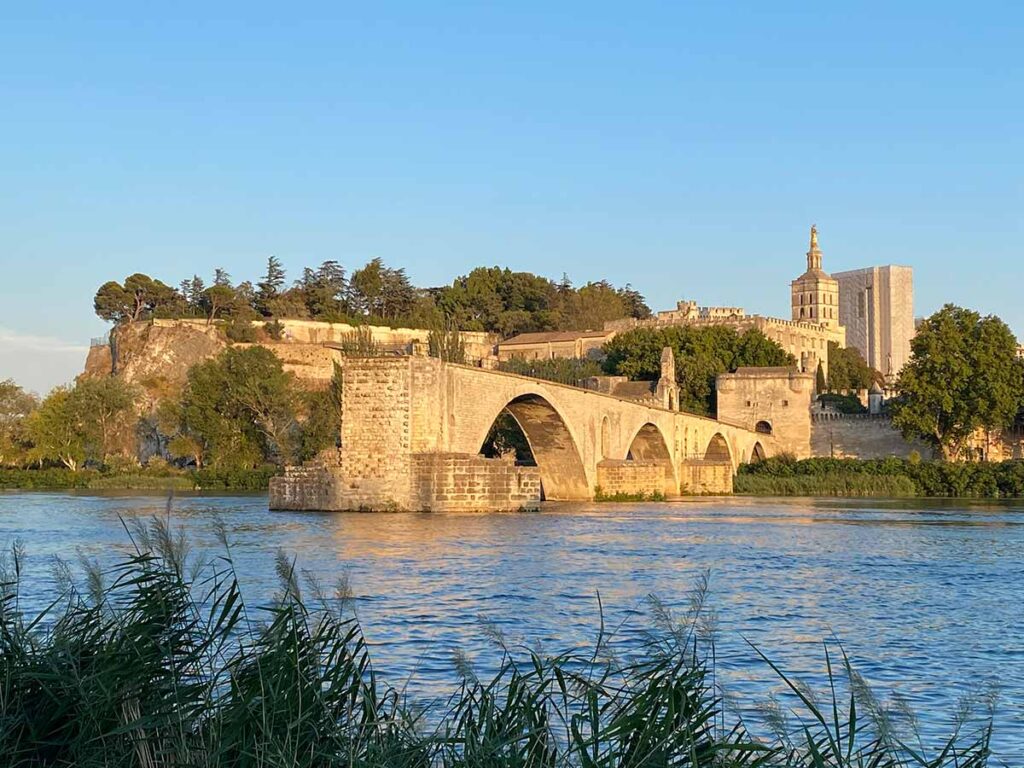
In the under-65 demographic, it’s likely that Avignon is more famous for its bridge than its papal history. Just a minute or two down the hill from the Palais des Papes you’ll find le pont d’Avignon , officially known as the Saint-Bénézet Bridge. A quick walk along or across the Rhone riverfront gives you excellent views of what remains of this iconic bridge.
Looking for more France travel tips?
Follow Fearless Female Travels on Facebook for actually-useful tips on traveling in France, solo female travel, and more! (No annoying emails – I promise!)
The famous song about the bridge dates back to the medieval era, but it became especially popular in the early 1950s, after the Canadian National Film Board created a short film (starring puppets!) based on the song, which you can stream for free here . Pro tip: Fast-forward to about 1:45 for the good stuff.
The bridge is open to the public. My strategy was to arrive about five minutes before it opened, and then I skipped the bridge museum and went directly to the bridge itself. I was the first person onto the pont and I had the bridge to myself for about twenty minutes, before the first few people started finishing in the museum. The caveat with this strategy is that the ticket agent told me I wouldn’t be allowed to go into the museum after already being on the bridge, but I’m not sure how strictly they follow that rule.
Collection Lambert Contemporary Art Museum

Musée Angladon

If you don’t have much time in France but still want to see works from some of the country’s most famous artists, Musée Angladon will be a must-visit in Avignon. The museum features the curated art collection of Jacques Doucet, a French fashion designer who achieved success, and wealth, in the late 1800s. The permanent collections here include paintings by Degas, Van Gogh, Picasso, Cezanne, Modigliani and Manet. The museum is laid out like a typical mansion of that era, and many of the furnishings throughout the building also belonged to Doucet.
Musée Louis Vouland

Louis Vouland was a French industrialist who had a passion for the decorative arts. He filled his 18th-century hotel particulier with opulent furnishings and art, and asked that his estate be converted into a house museum after his death. Highlights include rare ceramics, tapestries and timepieces, along with a collection of paintings from artists from the “New School of Avignon”. Look closely at the paintings to see which ones feature locations you’ve already seen around town!
Free Museums in Avignon (Municipal Museums)
Avignon has a collection of municipal museums that are situated in various locations in the Avignon city center. Admission to these five museums is completely free, so visiting these regional museums is the perfect thing to do in Avignon for travelers on a tight budget.
Musée Lapidaire

Fun fact: A lapidarium is a place where stone monuments, tablets and fragments are displayed. In Avignon, the Musée Lapidaire showcases Greek, Etruscan, Roman and Gallo-Roman antiquities. The collection includes both monumental works and items from the daily lives of citizens in those cultures. It’s housed inside the chapel of the College of Jesuits on Avignon’s main street, just a few doors down from the tourist information office.
Musée Calvet
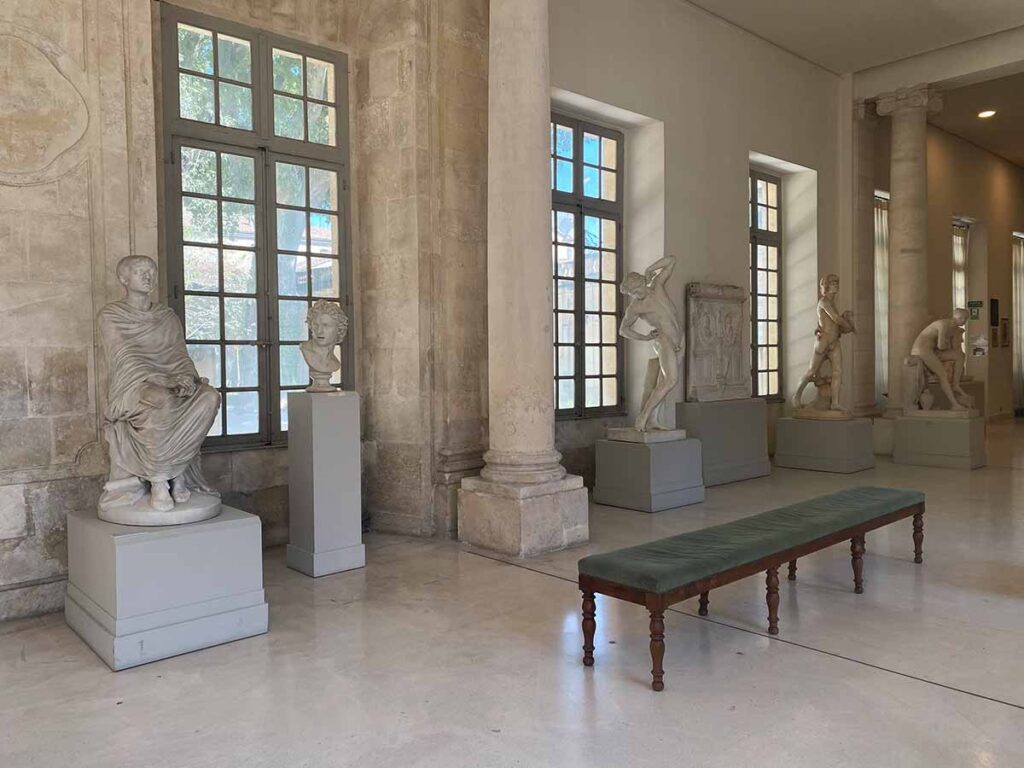
Of all of the free museums in Avignon, Musée Calvet was definitely my favorite. The collection here focuses on both fine arts and archaeology, with most of the collection being made up of paintings, sculptures and drawings. The collection is housed in a hotel particulier that belonged to the first consul of Avignon, and the setting is as breathtaking as the collection. Look for gilded and embossed ceilings (can you find the dragon?), the suspended staircase, and a garden that was once home to countless peacocks (a few of which are now taxidermied and on display throughout the network of municipal museums).
Palais du Roure
The former family home of the Florentine Baroncelli family, the Palais du Roure is now a house museum focused on preserving and sharing the history, literature, culture and traditions of Provence. The collections here center on popular arts, with many being displayed in rooms that show how people throughout the region once lived.
Musée du Petit Palais

Called “le petit palais” to distinguish itself from the very big (papal) palace beside it, this 14th-century building houses an important collection of Renaissance artwork, including almost 400 paintings and 600 sculptures. Most tourists head directly to Botticelli’s Virgin and Child, although I didn’t… since the museum was only “technically” open on the day I visited. At the time I visited, the museum was open but the galleries weren’t. So you could stand in an empty hallway and look at posters, but not view any of the art. Reviews on Google Maps indicate that I’m not the only visitors to have experienced gallery closures, so consider asking your hotel in Avignon to phone ahead to confirm opening hours if you’re planning to visit. That being said, if you are able to get into the galleries, seeing a Botticelli for free is a pretty good deal!
Musée Requien

The saddest of the five municipal museums in Avignon, the Musée Requien is a small natural history museum. You can breeze through this one in ten or fifteen minutes, passing through rooms on geology, paleontology, ornithology and zoology. 150 years ago the museum was founded as a “cabinet of curiosities”, and even today it’s not much larger than cabinet-sized. All that being said, if you’re in Avignon with kids they might enjoy looking at the skeletons and taxidermied animals here more than they’d enjoy looking at another painting of the Provencal landscape.
Les Halles d’Avignon Market

If you’re a foodie, one of the best things to do in Avignon is to check out the city’s famous Les Halles food market. The exterior facade of the market has been converted into a living wall, covering more than 325 square meters with greenery that moves in the wind and changes color with the seasons.
When I was staying in Avignon, I stopped by Les Halles every two or three days to stock up on food that I could quickly and easily prepare in my accommodation: fresh fruit with yogurt, bread spread with luscious butter, individual quiches and tarts, and all the cheese. If you don’t have a fridge in your hotel room you can always pick up some treats for a pique-nique and then enjoy them in one of the nearby parks, or along the river.
Avignon’s Free River Ferry
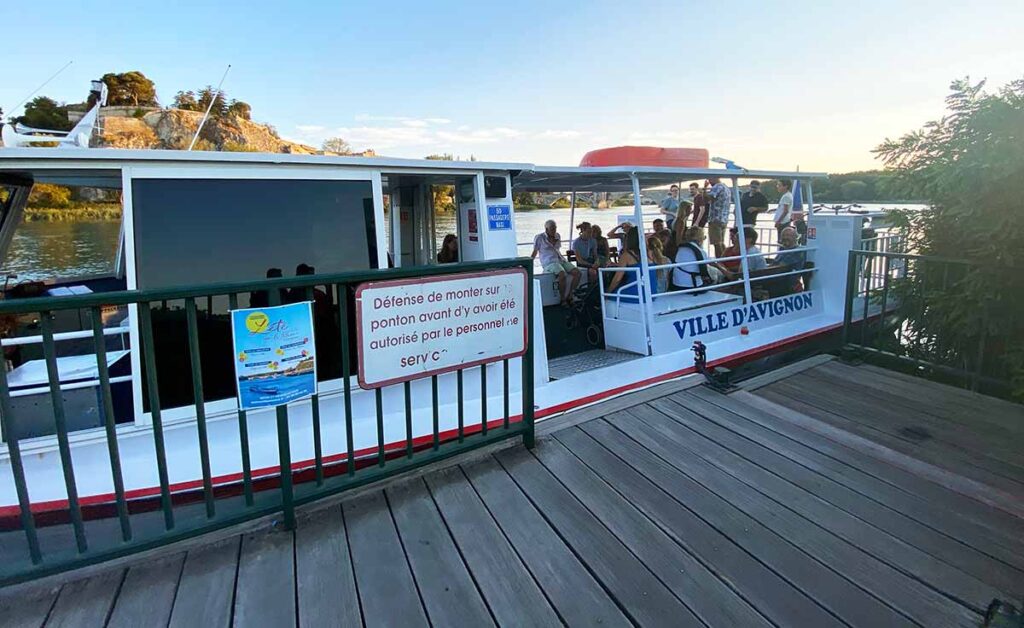
If there is a free boat you can bet I will take it. In Avignon, there is a free ferry service from le pont d’Avignon across the Rhone River to Barthelasse Island. The trip takes about five minutes and offers some of the best unobstructed views of the bridge.
The company that operates the ferry also offers traditional river tours, including short sightseeing trips )operating from May to September) and longer lunch and dinner cruises that sail as far as Arles and Tarascon. Much like Paris and Lyon , Avignon has a beautiful waterfront that is worthy of a boat trip.
Rue des Teinturiers Water Wheels

Although I always recommend taking a day trip to L’Isle-sur-la-Sorgue , if you’re pressed for time you don’t have to leave Avignon to see some pretty water wheels. Just a few blocks east of the city center you can find Rue des Teinturiers (Dyers’ Street), which used to be heart of the city’s textile industry.
This is where you’ll find Avignon’s water wheels: four ancient structures situated along the small canal (down from more than twenty in the heyday of the fabric era), and the surrounding streets are lined with independent boutiques, cafes and galleries. If you’ve had your fill of pope stuff, take a break and spend an hour wandering around this cool district.
Avignon’s Historic City Center

Mostly I was just looking for an excuse to post this unfiltered photo of the sky on my last full day in Avignon! The clouds were crazy, and while it felt like a thunderstorm would start any minute, we didn’t see even one drop of rain!
The historic center of Avignon is circled by the city’s ancient stone ramparts (you’ll pass through them as you enter town, whether that is by car, train or bus). Rue de la Republique runs through the center, south-to-north, connecting the train and bus station to the Place de l’Horloge and the Palace of Popes. The center is full of old hotels particuliers (grand townhouses), historic churches and tranquil squares. The closer you are to Place de l’Horloge, the more things cater to tourists. All you have to do is walk a few blocks in any direction to find shops, restaurants, cafes and other businesses that cater to a more local audience.
Visit Villeneuve-les-Avignon
Less than three kilometers from the historic center of Avignon, on the opposite side of the Rhone River, you’ll find Villeneuve-les-Avignon. Spending a day exploring this suburb of Avignon was one of my favorite things to do in Avignon, so I wrote a complete guide to taking a day trip to Villeneuve-les-Avignon . While you can just walk over, it’s a pretty boring walk, so I recommend hopping on Bus #5 instead. Once you arrive, you’ll want to explore the Fort-St-Andre (shown above), the Chartreuse Monastery, the Abbey Gardens and the rest of the quiet medieval center.
Other Day Trips from Avignon, France

Avignon is a great home base for day trips throughout Provence and the surrounding areas. You don’t need a car to explore many of the cities, towns and villages around Avignon, as most are easily accessible by bus and train. A few of my favorite day trips from Avignon include:
- L’Isle-sur-la-Sorgue – A delightful small town full of water wheels and flowery riverfront promenades.
- Arles – Although the ancient Roman arena (shown above) is the most noteworthy landmark, Arles has a rich artistic and archeological history within its compact center.
- Saint-Remy-de-Provence – One of the prettiest small towns in Provence, where you can follow in the footsteps of Vincent Van Gogh
If you’re planning a trip to Avignon, you have to check out my complete guide to ten absolutely unforgettable day trips from Avignon .
Shopping in Avignon, France
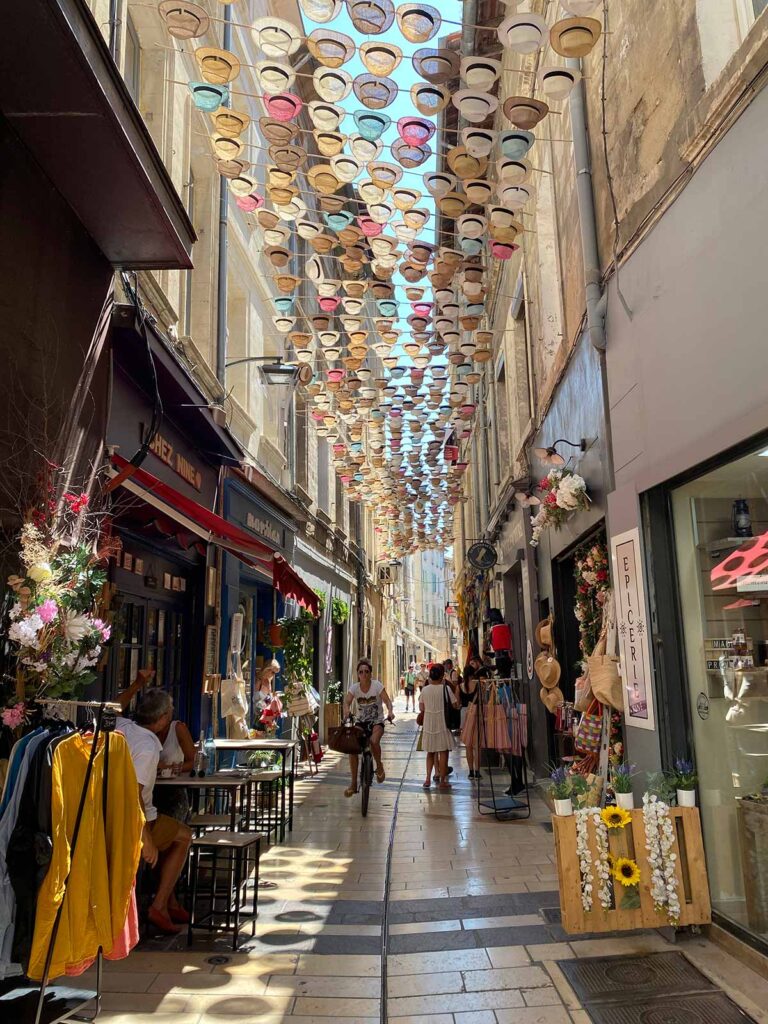
Avignon has lots of cute shops and boutiques where you can pick up some typically French products and souvenirs. The highest concentration are found along Avignon’s shopping streets just east of the Place de l’Horloge.
Be on the lookout for typical local sweets (if you’re not planning to visit nearby Aix-en-Provence , now is your chance to buy their famous calissons ), lightweight linen clothing and, like in the photo above, pretty hats to help shade your face from the summer sun. Before you buy any expensive gourmet food items, check the Carrefour City on Rue de la Republique to see if you can get the same product for half the price (or less!).
Restaurants, Dining and Food in Avignon, France

Avignon has lots of great restaurants, and dining out can be an experience in itself. Although I did some self-catering during my stay, I still had time to try out a few restaurants that I can highly recommend:
- Restaurant L’Épicerie Avignon – My favorite restaurant in Avignon is located on Place Saint-Pierre. Here, in the shadow of the church, I had one of the best “vegetarian plates” that I tried in all of France. As you can see from the photo above, it featured salad, tartines, quiche, cheese and a big slice of fresh melon. Reservations highly recommended!
- Le Gout du Jour – Recommended in the Michelin Guide (but not starred… yet…), this tiny, intimate bistro offers two tasting menus each evening: one featuring meat and/or fish, and one that is vegetarian. At other restaurants in the region you would pay double for a meal this thoughtful and innovative. Reservations required, and I do want to warn you that service can be a bit slow.
- La Table Hot – The restaurant next door, E.A.T., seems to get all the attention, but I preferred La Table Hot. In the summer four or five tables spill into the narrow alleyway near Porte de l’Oulle, and the menu is scratched onto a chalkboard on the wall.
Planning a trip to Avignon? I’ve rounded up the best hotels in Avignon (plus a few guesthouses, apartments and even a castle, too!).
I’ve also written a new itinerary for spending one week in Provence , where you’ll use Avignon as a home base for several nights, but also visit much of the surrounding region.
Planning a trip? Pin this post for later!
The 10 best day trips from nice, france (beaches, perfumes, views & more), the best hotels in cabo san lucas – where to stay in downtown cabo, you may also like, one day in barcelona, spain – an easy-to-follow..., what is the best time to visit the..., barcelona to paris train – tips for traveling..., visiting the alcazar of segovia – 10 things..., how to use the calgary transit app, the best places to visit in mumbai in..., a 7-day kerala itinerary (solo female traveler approved), how to visit the bharatpur bird sanctuary in..., is lisbon walkable the ups and downs of..., faro vs albufeira vs lagos – popular algarve....
Tourism, holidays & weekends guide in the Vaucluse
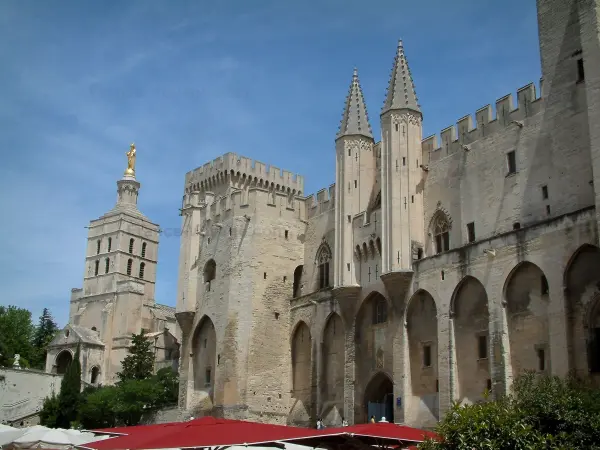
The City of Popes from 1309 to 1376, Avignon in the department of Vaucluse is a town steeped in history. Its historic centre is listed by UNESCO and its old town has kept some impressive reminders of its past! Protected by ramparts, it includes the emblem of the city: the Palace of the Popes (Palais des Papes). Open to visitors, this superb Gothic monument dates back to the 14th century and consists of the old palace of Benedict XII, built between 1334 and 1342, and the new palace of Clement VI, built between 1342 and 1352. The Palace's vast square is also surrounded by other prestigious buildings like the Small Palace (Petit Palais), which is in fact the former residence of the archbishops. Built between the 14th and 18th centuries, this elegant building of almost 3,000 m² now houses a museum that exhibits Italian paintings from the 13th to 16th centuries, such as Botticelli's Madonna and Child, as well as Romanesque and Gothic sculptures. You can also admire the former Mint (Hôtel des Monnaies), with its beautiful 17th-century Baroque façade featuring eagles and dragons. Then visit Avignon Cathedral (Notre-Dame-des-Doms), built in the 12th century and remodelled in the 15th and 17th centuries. An example of the Provençal Romanesque style, it contains a magnificent Romanesque cupola, a white marble bishop's seat, and the Gothic tombs of Popes John XXII and Benedict XII. Outside, look up to see the huge, gilded statue of the Virgin Mary at the top of the bell tower.
Then wander through the medieval streets to admire the period houses, Renaissance mansions and old town squares. You are sure to find your way to Rue des Teinturiers, a picturesque pedestrian street paved with pebbles. The busy Rue de la République connects the ramparts to the plane tree-shaded Place de l'Horloge, the lively heart of the town with its many cafés and restaurants. Here you can see the Neo-Classical façade of the 19th-century town hall and its clock tower, a former 14th-century belfry with a jacquemart clock.
It's worth taking some time to admire the many buildings you will come across on your walk. These include the Basilica of St. Peter, with Renaissance door leaves on its façade, 17th-century woodwork in the choir and a 15th-century pulpit making it well worth a visit. Also be sure not to miss the night-time illuminations that transform the building into a sublime spectacle during the Hélios festival in summer. The Gothic Collegiate Church of St. Didier has a beautiful 15th-century carved altarpiece depicting Christ Carrying the Cross. On Place des Carmes, the last vestige of an old convent is the Augustins bell tower, with a wrought iron campanile on top. In the church, the painted wooden statues date from the 16th century.
Don't forget to take a walk to the top of the Doms Rock, where the town's origins lie. The lovely garden there is ideal for a rest in the shade and offers superb views of the Alpilles, the Rhône and the unmissable Pont d'Avignon bridge. Made famous by the well-known folk song and also known as the Pont Saint-Bénézet, this medieval bridge used to connect the town with Villeneuve-lès-Avignon , 900 metres away. Although part of it was destroyed by the Rhône's repeated floods, it still has four arches and two superimposed chapels left. An exhibition space called "Le pont retrouvé" and touch screen tablets will help you discover a side of this iconic monument that you've never seen before!
Art-lovers have a number of museums to choose from: the Calvet Museum, which exhibits collections of fine and decorative arts and ethnography; the Lapidary Museum, which focuses on archaeology; the Louis Vouland Museum, with its prestigious collection of furniture and objects from the 17th and 18th centuries, and works by Provençal artists from the 19th and 20th centuries; and the Angladon Museum, which houses a remarkable collection of modern art.
Additional information Avignon
The town of Avignon is a former city of the popes. It is located in Provence-Alpes-Côte d'Azur, in the department of Vaucluse , on the border of Gard and Bouches-du-Rhône. It takes place on the left bank of the Rhone, near Nimes, Orange , Montpellier or even Arles .
The city of Avignon, a UNESCO World Heritage Site, is known for having welcomed the popes between 1309 and 1423, in parallel with the Roman popes. It changes its face in the course of the eighteenth century with more modern developments and the disappearance of many narrow medieval narrow streets. Today, Avignon is best known for its architectural heritage, as well as for its cultural influence throughout the world.
The town is one of the few French cities to have preserved its ramparts and its historic center which attract many tourists every year. Gastronomy, especially wine production, is also the success of Avignon.
Things to see and do
The Palace of the Popes, a monument of the 14th century, is surely the most famous tourist site of the whole city of Avignon. Classified in UNESCO, it is one of the largest Gothic constructions of all the Middle Ages. Formerly a pontifical residence, this fortress was the seat of Western Christianity during much of the 14th century. The Palace of the Popes consists of the intertwining of two distinct buildings, the old palace of Benedict XII which takes place on the rock of the Doms, and the new palace of Clement VI. It is now one of the ten most visited French monuments each year, and hosts important cultural events each year, as is the festival "in" of Avignon. During the visit, you can enjoy the twelve towers, as well as many rooms such as the hall of the conclave which used to serve as an apartment for the guests or the room of the Great Audience. The deer room is at present one of the most famous pieces of the Palais des Papes, notably because of its decoration. Visitors can discover a beautiful painted hunt on the western wall. The architectural ensemble is also composed of several chapels, as well as different courtyards like the courtyard of 1800 square meters, or the courtyard of the cloister.
Another famous tourist site in Avignon, the famous Saint-Bénezet bridge. Highlighted by a famous song, the building dates back to the 12th century and has also been listed as a UNESCO World Heritage Site. Today it has only four arches that have withstood the vagaries of time.
The historic center of Avignon is still surrounded by ramparts dating from the fourteenth century. Four kilometers long, they are equipped with seven doors open on the city and 39 towers.
Classified as Historic Monuments, the Salt Grenier is an ancient salt storage place built in the mid-14th century. Close to the ramparts, the current monument dates back to the 18th century and now serves as a venue for exhibitions and shows during the "off" festival of Avignon.
Walking through the old center of Avignon, you can also admire many private mansions. There are no less than 130 built between the 15th and 18th centuries. One can thus note that of Brancas which welcomed Minister Necker during his disgrace, that of the Laurens, that of Brantes, or the Hotel de Sade which once belonged to the family of the same name.
The Hotel de Villeneuve-Martignan, built in the 16th century, is now used as a place of reception for the Calvet museum, classified as Musee de France. There are collections on archeology, fine arts, and decorative arts such as tapestry, ironwork and porcelain.
Other museums also take place in Avignon as the museum of the Petit Palais with its collections of primitive Italian paintings, the Requien museum which deals with natural history, the lapidary museum and its antiques, or the Jean-Vilar house The Bibliothèque de France, and the Angladon Museum. The latter takes place in the mansion of Massilian and uncovers collections of art from the eighteenth to the twentieth century. A collection of works of contemporary art, the Lambert collection can be admired in the Caumont hotel since 2000.
The Saint-Pierre collegiate church of Avignon is a monument dating from the mid-14th century, which took its place on an ancient building of the 7th century. Mainly in Gothic style, it has been classified as a Historic Monument. Inside, several works of art are present, like the monumental altarpiece of St. Peter.
Leisure activities
Places of interest, events and festivities.
- Several weekly markets take place from Tuesday to Sunday morning. There is also a flea market on Sunday mornings, a flea market on Tuesdays and Thursdays, and a book market every first Saturday of the month in the morning.
- In January, Cheval passion sets up shop.
- In February, it's time for the Hivernales d'Avignon, a contemporary dance festival. It highlights choreographic shows, workshops, exhibitions or even projections and meetings around dance.
- The last weekend of March, the city offers the Avignon motor festival.
- The famous Avignon "in" and "off" theater festival takes place in the city every year in July. Founded in 1947 by actor Jean Vilar, it offers official shows in the main courtyard of the Palais des Papes, as well as other festivities in the rest of the city.
- At the beginning of August, it's time for the Avignon Jazz festival, rich in concerts and other events throughout the city.
- The first Saturday of October: the potter's market, Place Saint Didier, with 40 potters and ceramists from different regions of France, selected for the technical and artistic quality of their work.
- Every year between late November and early January, a traditional Provencal nativity scene with santons by Marcel Carbonel is installed in the peristyle of the town hall.
- On 4 may 2024
- Départ : place de l'Horloge
- Come and see for yourselves or rediscover the Papal City from a brand-new angle ! - Come join the 3rd edition of this night-time urban trail in Provence !!
- On 18 may 2024
- Différents monuments et musées
- An amazing evening, like no other. Discover or rediscover the city's monuments and museums, their collections. Lots of different offers on hand - special event, guided visits with the curators … at special low rates or free of charge.
- From 31 may to 2 june 2024
- Parcs et jardins de la ville
- All attention is focused on gardens during this fun weekend with lots of special events designed for all ages and especially for families.
- From 29 june to 21 july 2024
- Divers lieux
- Founded in 1947 by Jean Vilar, the Festival d'Avignon is now one of the biggest international theatre events featuring contemporary live performance. For 78 years now, the city of Avignon turns into a thriving theatre city.
- From 3 to 21 july 2024
- Divers lieux de la ville, Divers lieux de la ville
- The place to be in summer, one of the biggest performing arts festivals in the entire world ! Theatre, dance, music, circus… the Festival Off means more than 1500 shows during the 3-week duration of the festival in July. - The dates of the 2024 edition have not yet been set by the organizer.
- From 6 to 16 july 2024
- 18 rue Guillaume Puy, CDCN Les Hivernales
- With "We (also) dance in summertime !" by Les Hivernales - CDCN d'Avignon, the dance festival dedicated to choreographic art is back this year for its new edition from 6 to 16 July.
Detailed information
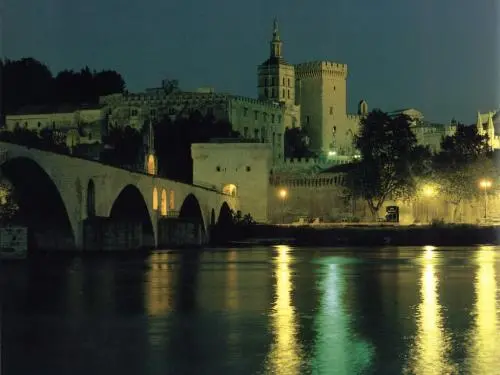
Visits, leisure and activities nearby
- Pont du Gard
- The Camargue.
- The Luberon and its villages: Gordes , Roussillon ...
- La Fontaine de Vaucluse .
- L'Isle-sur-la-Sorgue and its secondhand trades, including the International Antiques Fair and Flea of L'Isle-sur-la-Sorgue Easter.
- Lake Monteux , its outdoor theater, his Splashworld amusement park.
- Entraigues-sur-la-Sorgue and its tower of the Templars.

Restaurants

Bed & breakfasts

Vacation rentals

Related articles Avignon

The Perfect 1, 2 or 3 Days in Avignon Itinerary
Published on April 18, 2023
by Brittany Scott-Gunfield
Disclaimer: This article contains affiliate links. That means if you click a link and make a purchase, we may make a small commission. As an Amazon Associate we earn from qualifying purchases. For more information, see our privacy policy.

Our Avignon itinerary will take you on a fantastic journey through the historic streets of this provencal city, from palaces and popes to wine and walls. Over 1, 2 or 3 days in Avignon, you’ll have plenty to do at a relaxed pace to really get a feel for life in this former papal residence.
Table of Contents
How Many Days in Avignon?
Although small in size, Avignon has a long and rich history, from the Romans to the present day, with most of the city’s attractions becoming World Heritage Sites in 1995.
Its main significance lies in being one of only three papal seats outside of Rome, and of course, the Papal Palace remains Avignon’s main tourist attraction. However, you’d be forgiven for wondering how many days to spend in Avignon, as little else is known about the city unless you’re a true francophile, a local, or from its twinned town of Colchester, England.
For 1 day in Avignon, you can plan to see the main historic sites as they are located very close together within the city’s walls, such as the Pope’s Palace and gardens, and the neighbouring semi-destroyed bridge.
If you have 2 days in Avignon, you can add a walk around the ramparts and through the charming city streets as well as a visit to a museum.
However, if you have 3 days, you can even go on a day trip to one of the vineyards on the Rhône, to the hilltop villages or to the nearby historic city of Arles, overflowing with Roman history and delighted with memories of Van Gogh.

Getting To & Around Avignon
Avignon is located in the South of France, relatively centrally, at 100 km northwest of Marseille , 100 km northeast of Montpellier and 230 km directly south of Lyon . The easiest way to reach Avignon from outside France is by flying into Avignon-Provence Airport, which is a 20-minute drive from the city centre or one hour via bus line 62.
From other cities in France, you can reach Avignon by high-speed train (TGV) from most major cities, including Paris , or via coaches or ridesharing applications. Avignon’s central train station is just outside of the city walls, however as it’s a small city, it’s just a ten-minute walk to the centre. You can view train schedules here.
You can enjoy a very pleasant long weekend in the city without needing a car, however, if you want to go further afield during a longer stay or as part of a Provence itinerary , you should rent a car to be able to get around more easily, particularly to the charming small villages located to the South and East of Avignon or even make your way to Aix-en-Provence .
Rental cars are available from Avignon-Provence Airport as well as other rental agencies outside of the city centre. You can browse car hire options here .
Within Avignon, there are buses and trams around the outside of the city walls, and some bus routes crossing the centre, however, due to the proximity of Avignon’s main highlights and the charming cobbled streets, it’s much better to explore the city on foot or by rental bike.
There is also the “Petit Train” also known as the little touristic train that takes you through a small circuit around the city to see 11 stops, including the Palais des Papes, Rocher de Dom and the Pont d’Avignon. Or a longer city circuit takes you over the rivers to Barthelasse island and the Philippe le Bel Tower.

1, 2 or 3 Days in Avignon Itinerary
Day 1 – historic centre.
Whether you take the Petit Train first or explore Avignon on foot, in one day in Avignon, you can take your time while visiting the most important historic buildings and relics the city has to offer. You can also take a walking tour to get more historical information about the city.
Palais des Papes
The Pope’s Palace is undoubtedly the highlight of any Avignon itinerary, so naturally comes as the first stop on ours. While most people know of the Vatican City being a papal enclave in Italy, few know that Avignon was formerly one in France, after Pope Clement V moved to France in 1309.
It was in 1316 that Pope John XXII began construction on the Palais des Papes, aided significantly by his successors Benedict XII and Clement VI, as demonstrated by the slight archaeological differences in the palace’s design.
The Papal Schism took place in 1378 as the College of Cardinals in Rome, eager to bring the papacy back to Rome, elected the first Pope Urban VI before nullifying this election and electing Pope Clement VII instead.
Due to Pope Urban VI’s unwillingness to step down, Pope Clement VII was forced to return to Avignon, with the support of King Charles V of France, beginning the era of two Popes that caused chaos in Europe as leaders were forced to recognise only one.
The schism ended finally in 1429 with the resignation of the Avignon and Roman Popes, the death of the Pisan Pope who ruled briefly from 1409 to 1410, and the election of Pope Martin V.
Later becoming a governmental residence and then barracks during the French Revolution, the Palais des Papes is now open to visitors who can learn more about the former papal residence, complete with awe-inspiring frescoes by Matteo Giovannetti and gardens.
If you’re spending one day in Avignon, you can buy a ticket that includes a visit to the Pont d’Avignon. You can also visit the Notre Dame des Doms d’Avignon (the main cathedral of the city), next to the palace, which is also a UNESCO World Heritage Site from the 12th century, holding several tombs on the Popes of Avignon.
Head down from the Palais des Papes, past the impressive baroque façade of the Hôtel des Monnaies to the palace gardens.

Jardin des Doms
Sat alongside the Rhône River, is a beautiful elevated public garden that gives visitors views of the provencal countryside and Mont Ventoux to the Northeast.
It’s the perfect place for a picnic, so pick up a fresh baguette and some fromage before you arrive, to sit and relax among the ponds, ponies, and palace to the rear, before continuing your Avignon itinerary.
The Jardin des Doms, also referred to as the Rocher de Doms, is free to enter every day from 7.30 am until sunset.
Pont d’Avignon
Actually called Pont Saint-Bénézet, but affectionately nicknamed the Pont d’Avignon, this mediaeval bridge over the Rhône was built in 1234 with 22 stone arches, replacing the wooden bridge that had been located there one hundred years before.
Unfortunately, the new stone Pont Saint-Bénézet faced the same misfortune as the wooden bridge, being regularly destroyed by the Rhône floods and finally being abandoned after a major flood of 1669.
Now with only its gatehouse and four remaining arches in Avignon, the Chapel of Saint Nicholas on the second pier of the bridge, and the Philippe-le-Bel Tower on the West side, little remains of the historic bridge, but it’s still worth a visit.
Famous in France due to a little ditty from the 15th century, while you’re on the bridge, make sure to give a rendition of “Sur le Pont d’Avignon, l’on y danse, l’on y danse…” as you spin in circles with your partner for the full experience; if you’re alone, here’s your chance to make a friend!

Tour de Philippe-le-Bel
Crossing the Rhône River on Pont Édouard Daladier, or taking a free boat, to the Île de Piot, and continuing across Pont du Royaume over the West divergence of the Rhône River, you’ll reach the small village of Villeneuve-lès-Avignon, where after a couple of minutes walking along the riverside, you’ll come across the wonderful Philippe-le-Bel Tower.
This tower marked the end of the Pont d’Avignon and provided the French gateway to the Papal enclave of Avignon before the river destroyed it in the 1600s. Meaning, Philip “the fair” the tower’s name comes from King Philippe IV who commissioned it around the turn of the 14th century.
Closed in January and on Mondays, you can go up the tower for €4.50 before finishing your evening with a stroll along the riverside, or a 15-minute walk up to one of France’s oldest olive oil manufacturers, Maison Bronzini, formerly The Moulin de la Chartreuse, to try some delicious natural olive products and perhaps buy a souvenir, or enjoy a freshly prepared meal in their new restaurant.
Day 2 – Ramparts
Continue to discover the historic sites if you have 2 days to spend in Avignon, with its well-preserved ramparts, museum and exquisite cuisine.
Remparts d’Avignon
As you start your second day, you can see remnants of the former defensive perimeter from the 1200s in the city planning as you navigate the winding cobbled streets towards Avignon’s Ramparts.
This 8-metre tall city wall extends for 4.3 km around the historic centre since it was built by order of Pope Innocent VI in the mid-1300s to protect the papacy from angry French mercenaries. Over the centuries, the ramparts have met a great number of attacks and required numerous repairs; today there are 15 entrances for vehicles and a further 11 for pedestrians.
As it’s free to go up and walk around every day of the year, this is a must-do activity over 2 or 3 days in the city. You can pick up a brochure in the tourist information centre before walking around the ramparts, or book a guided tour to learn more about the history of the city walls.

Palais du Roure
The Palais du Roure is less of a palace and more of a hôtel particulier – an old French mansion belonging to one family over many years.
Formerly the home of the Baroncelli-Javons, a Florentine family, for 5 centuries before being changing hands and eventually being bought by author Jeanne de Flandreysy in 1918, the Palais du Roure is now a diverse centre of provencal history and culture, an art museum and the location of Flandreysy’s bell collection.
Although the contents are a touch bizarre, this Gothic mansion is architecturally charming and is free to enter to see the permanent collections from Tuesday to Saturday.
Musée Calvet
Just a 4-minute walk from the Palais du Roure towards the Rhône, lies another incredible hôtel particulier, this time from the 18th century, and a Jesuit Chapel forming the Calvet Museum.
Esprit Calvet, who gives the museum his name, was an enlightenment-era economist and collector, who donated his full collection of antiques, his library and natural history collection to the city of Avignon to be turned into a museum upon his death in 1810.
The mansion houses a wonderful fine art collection, while you can find all kinds of gemstones, precious metals, porcelain and tapestries in the lapidary area of the museum located in the former chapel. You can also find a number of archaeological finds from other continents that Calvet had collected.
Closed completely on Tuesdays and every other day from 1 – 2 pm for lunch, the museum’s permanent collection is free and you can pay on arrival for any current exhibitions.
Eating in Avignon
Due to its location and climate, the food in Avignon is exceptional, with seafood from the nearby Mediterranean, Spanish influence from the West, French influence from the North and perfect vegetable-growing land, giving the city an abundance of fresh ingredients to use in its cuisine.
Depending on which season you’re visiting Avignon in, you can find ample fresh cherries and strawberries, asparagus and garlic, and of course cheese, at most regional markets in the area as well as being served in the bistros and auberges.
Try the typical Avignon dish Foie de Veau en Persillade (veal liver in a parsley sauce) from central restaurant Caf’Thiers on Rue Thiers to get a taste of the area, or pick up some famous provencal charcuterie from your nearest butcher, supermarket or market stall (such as in Les Halles d’Avignon) to enjoy with your picnics or apéritifs. You can even do a cooking class with a chef at Les Halles market!
There is no doubt that eating local cuisine is one of the best things to do in Avignon.
Day 3 – Day Trips from Avignon
Avignon is a small city but in a great location, so once you’ve seen its highlights, take a day trip to one of the many interesting provencal villages and historic sites, by car, public transport or guided tour.
Pont du Gard
Just 26 km West of Avignon is the amazing 1st-century aqueduct, the Pont du Gard.
Either by car or line 115 bus from Avignon’s central bus station to Vers-Pont du Gard, you can easily arrive at the historic site, walking from the entrance into the grounds, with the museum where you can learn about the history of the aqueduct, shops full of local souvenirs and cafe where you can have a pleasant breakfast or light lunch. You can also take a guided half-day tour that also visits some other nearby villages.
After 15 minutes walking through the site, you’ll arrive at the incredible bridge. Although 2,000 years old the Pont du Gard is an amazing piece of architecture today, with its three arched tiers spanning 275 metres across the river Gardon. You can buy entry tickets here.
You can cross the aqueduct to get a different perspective and head to the Terrace restaurant for dinner if you have your whole day there, or explore the other historically significant bridges, Pont du Combe Roussière, or Pont de Valmale, or visit the ancient Chapel of St Peter or ruins of the formerly 50 km long aqueduct.

Driving 50 minutes South or taking the TER for 17 minutes from Gare d’Avignon to Gare d’Arles, you’ll arrive in the magnificent city of Arles. The centrepiece of the city is the Arènes d’Arles – an incredible two-tiered Roman amphitheatre. You can also take a guided half-day tour.
You can visit the amphitheatre to learn of its history as a place of gladiator battles, or book an event in advance, as the amphitheatre now hosts concerts and other events throughout the summer months.
You can also wander down the Alyscamps; a seemingly Gothic version of the Parisian Champs Élysées, this spectacular tree-lined route takes you past many ornate sarcophagi into an old Roman cemetery with a church from the 1100s.
Or, you can head to the Fondation Vincent Van Gogh, an art museum dedicated to the artist who lived in the city from 1888 to 1889, proving to be one of his most prolific periods in which he produced 200 paintings and 100 drawings and watercolours, including one of his most revered works, Sunflowers.
Although many of his famous works are scattered around Europe or housed in the Van Gogh Museum in Amsterdam, this museum provides a great opportunity to see a broad spectrum of the artist’s work in the very place that inspired them. It was also while living in Arles that Van Gogh cut off his ear while being visited by friend Paul Gaugin.

Châteauneuf-du-Pape
One of the best day trips that you can do, even if you just have 2 days in Avignon, is to the village of Châteauneuf-du-Pape, just 12 km north of Avignon. There are a number of tour options such as this half-day tour or this afternoon tour.
Although its name is larger than the village itself, Châteauneuf-du-Pape is an absolute must-see place in Provence and one of the best places to visit in Avignon, especially for oenophiles, or connoisseurs of wine, as the region produces around 14 million bottles of wine annually.
Gaining its name officially in 1893, Châteauneuf-du-Pape is named due to the ruins of the mediaeval castle that sit above the village that was originally built for Pope John XXII in the 1300s. Nowadays, the village is much more famous for its production of deep red wines, which you can taste at many of the 320 local vineyards and wineries, covering 7,746 acres.
One of the most notable is Château Fortia, a family-run vineyard whose post-WWI struggle prompted husband and pilot Baron Le Roy and his friend Joseph Capus to begin work on a system of naming and protecting French wines, which was adopted in 1936 and is known today as the appellation d’origine contrôlée, or AOC.
Or visit Château La Nerthe; one of the oldest wineries in the region, dating back to 1570 and now one of Châteauneuf-du-Pape’s biggest and best.
Since 93% of wine produced in the Châteauneuf-du-Pape region is red, you won’t find much white wine, however there is a great variety in the types of red on offer, which you can see in the AOC wine shop, Vinadea.
Gordes, Roussillon and Sault
If you have 3 days in Avignon or more, you should definitely rent a car or book a guided tour such as this full-day tour or this half-day tour to visit the nearby villages of Gordes, Roussillon and Sault. A circular drive visiting each provencal village from Avignon would take under 3 hours, so you have plenty of time to spend in each village between enjoying the views from the road.
40 minutes driving from Avignon is the hilltop village of Gordes, with scenic views of the surrounding countryside and winding cobbled streets taking you past the white stone buildings.
Just 15 minutes East of Gordes, is the picture-perfect village of Roussillon. Sat at the foot of the red Vaucluse mountains which lend its colour to the pinkish houses, in one of the world’s biggest ochre deposits, surrounded by Provence’s famous lavender fields and green pine trees, Roussillon is bursting with so much colour, it’s hard not to take out your sketchbook and paint brushes or takes picture on every corner.
There are many little ateliers dotted around the village too, demonstrating the influence the amazing landscape has on the artistic side of its inhabitants.
Continue for 30 minutes to the village of Sault for a real taste of Provence. You can take a free 30-minute guided tour of the Distillery Aroma’Plantes where you can take part in workshops to make your own lavender oils and soaps with the natural fragrances available to learn the skills passed down through generations of the lavender farmers of Provence.

Where to Stay in Avignon
Hotel Boquier – Mid-range visitors to Avignon will love the cosy hotel. Situated in the city centre within easy reach of all of the top attractions, there is a range of rooms to choose from, parking included and breakfast on offer in the mornings.
Hotel De Cambis – Luxury travellers will love this sophisticated hotel in the centre of Avignon. There are plush and comfortable rooms to choose from, a hearty breakfast available in the morning and a range of other amenities for guests to enjoy.
Chapelle du Miracle – These apartments are a great choice for those who would prefer their own flat when visiting Avignon. There is a range of different apartments to choose from, all fully furnished with everything you may need and they’re located in an excellent location for exploring the city.
Not quite what you’re looking for? Click here to browse more Avignon hotels!
Although small, Avignon has a long and significant history which can be witnessed all over the city, from the food to the art and architecture. So don’t miss out and book your trip to Avignon today!
Are you planning a trip to Avignon? Have any questions about this itinerary? Let us know in the comments!

Related Posts:

The Perfect One Day in Lille Itinerary

2 to 3 Days in Chamonix Itinerary (Winter or Summer!)

The Ultimate 5 to 7 Days in the French Riviera Itinerary

About Brittany Scott-Gunfield
Brittany is a writer for The World Was Here First. Originally from Colchester, England, she is slowly but surely travelling the world as a digital nomad. She loves to hike around different landscapes and has a deep love for travelling around France (and elsewhere in Europe).
Leave a Comment Cancel reply

- The Tourist Office at your service
- Practical information
The Tourist Office is at your disposal to help you plan your stay and answer any questions you may have about Avignon and its surroundings.
Avignon Tourist Office
Until friday, march 29, 2024:.
Monday to Friday : 9 am – 6 pm Saturdays : 9 am – 5 pm The tourist office is closed : Sundays, December 25, and January 1. Exceptional opening: Sundays during school holidays (3 zones) from 10 am to 1 pm and on November 11 from 10 am to 5 pm.
Starting Saturday, March 30 (Easter):
Monday to Saturday : 9 am – 6 pm Sundays and public holidays : 10 am – 5 pm
From June 29 to July 21 (Festival):
9 am – 7 pm daily
From July 22 to August 31:
9 am – 6 pm daily
From November 2024 to March 2025:
Monday to Saturday : 9 am – 6 pm Saturdays : 9 am – 5 pm Sundays during school holidays : 10 am – 1 pm Other Sundays : Closed Public holidays November 1 and 11 : 10 am – 5 pm Christmas Day : Closed
September and October:
Tourist office boutique: reopening on march 25, 2024, until december 3.
Monday to Saturday : 9 am – 6 pm Sundays and public holidays : 10 am – 5 pm Festival d’Avignon 7 days a week : 9 am – 7 pm August 7 days a week : 9 am – 7 pm
House of the Park – Tourist Information Point
In June and September : 10:30 am – 6:30 pm In July and August : 10 am – 7 pm (Annual closure from October to May. 2024 reopening dates to be announced.)
The different payment methods

- To reach us:
By phone: +33 (0)4 32 74 32 74 By e-mail: [email protected] Address : 41 Cours Jean Jaurès, 84000 Avignon
- A team at your service!
Our bilingual or trilingual consultants can provide information in French , English , German , Italian , Spanish, Serbian and Dutch .
Experts of Avignon , they give you their tips and recommendations for a 100% local visit ! Hidden corners, must-see places, locals’ secrets, discover our experts’ favorites .
The tourist office is a multicultural space with over 6 nationalities and 8 languages spoken ! In high season, our team welcomes seasonal consultants : among them are French or foreign students , young European or international expatriates in our city, all in love with Avignon ! Mexican, Chilean, Italian, Dutch, German, and French from all over France, they communicate their enthusiasm and passion for Avignon!
Your day-to-day services
Welcome, advice, information on heritage, leisure activities, events, accommodation, food and wine, restaurants, visits in Avignon and Provence.
- At the tourist office
- Tourism and disability
- NF Quality Certification
The Etat Tourisme et Handicap mark constitutes the proof of concrete commitment as well as the guarantee of an efficient and adapted welcome . It is awarded to tourism professionals who are committed to a quality approach targeted at accessibility to leisure activities and holidays for all. This label is renewed every 3 years. We are labeled for 4 disabilities: motor, visual, hearing, mental .
Visit our special page to discover Avignon with its disability . You can download directly our Accessibility and comfort guide . A complete guide to the accessibility of monuments, museums, walks, guided tours and all the useful information to prepare your stay !
Accueil Vélo is a national brand that guarantees quality reception and services along cycle routes for touring cyclists. This mark is renewed every 3 years. We hold at your disposal many free information and support materials : detailed fact sheets and departmental maps as well as free equipment : pump , VAE battery charge and repair kit .
You can also download our Guide Avignon à Vélo . A comprehensive guide to two-wheeled cycling in Avignon and its region !
A reward thanks to testimonials from our visitors . In 2022, the Tourist Office’s Accueil department was awarded the prix trophée de l’e-reputation, category Best Tourist Office in the Region Sud – Provence Alpes Côte d’Azur . The score of 8.8/10 was awarded to Avignon, based on the opinions of visitors to the Tourist Office, collected via the Fairguest tool between January 1 and December 31, 2022.
Our greatest reward is your satisfaction ! We are committed to making your stay an unforgettable experience . Your remarks and suggestions help us to improve the quality of our welcome.
Le comptoir des Avignonnais
Are you Avignonnais or live in Greater Avignon and want to (re)discover your city ? Are you looking for ideas for weekend or vacation outings ? Activities to do in Avignon or its close surroundings?
The office de tourisme , a veritable counter for the locals, is here for you !!
Theater, dance, music, cinema programs: all the cultural news is at the office de tourisme ! You’ll also find conference programs, exhibitions, not to mention festive and gourmet events.
- Activities and leisure for all, all year round!
- Local practical information
- Like a tourist
- Welcome to the new residents of Avignon!
Families can find at the Tourist Office all the activities to do with children or teenagers , all year round and during school vacations: treasure hunts, ideas for walks and visits in the town, attractions in the surrounding area…
Prepare your stay with your family!
For outdoor activity enthusiasts , the tourist office and the info point at the Maison du Parc propose all the info on sports, hiking or biking, gardens, sports routes.
Everything you need to know about Barthelasse Island!
The guide to leisure activities lists over 250 organizations offering courses for adults and children in fields as varied as painting, literature, magic, languages, circus… But also activities to let off steam (Capoeira, judo, karate ….), get some fresh air (golf , climbing, skydiving), breathe and find your balance (singing , yoga…), express yourself (music ,theater ). Not forgetting a section dedicated to sport adapté handisport .
Download the brochure!
Avignonnais and residents of Greater Avignon can find practical information and information on local life at the tourist office : transport in the city and to the region, schools, high schools and colleges, associations, information on shops and craftsmen, city and agglo magazines…
The Palais des Papes and the pont d’Avignon are free every Sunday for Avignon residents ! On presentation of ID and valid proof of address (less than 6 months). Learn more!
Want to re-discover your city?
From November to March , set off to discover Avignon with the Tourist Office’s guide-conférenciers: a program of themed tours lets you discover our city in a different way. Reservation recommended . Learn more!
I’m hosting my family?
To visit Avignon .
To visit the surrounding area: all documentation on major sites, vineyards, attractions in the region, is available from the tourist office.
We welcome newcomers and provide them with all the information they need to settle in Avignon, discover the city and the activities of associations welcoming newcomers.
Our teams welcome you Monday to Saturday, 9am to 1pm and 2pm to 6pm, Sundays 10am to 1pm and 2pm to 5pm.
- Côté boutique
Craze for our local and regional products stamped Avignon et Provence and for original, handcrafted creations, 100% Avignon and made in France! Stationery, Provencal specialties, cosmetics, accessories, t-shirts, fabric bags, beautiful books and tourist guides, you’re bound to find what you’re looking for!
- Ticket sales
You’ll be able to buy your tickets directly for monuments, museums, excursions, city tours and the Avignon Citypass!
The tourist office shop
During your visit to the tourist office, take the time to discover the selection offered by the shop: regional products, made locally, Avignon creators, “Avignon” flocked products, Festival posters… Impossible to leave without a little souvenir from Avignon!
The shop is open :
Monday to Saturday: 9 a.m. to 6 p.m. Sundays and public holidays: 10 a.m. – 5 p.m. Avignon Festival 7 days a week: 9 a.m.-7 p.m. August 7 days a week: 9 a.m.-7 p.m.
- See our products sold online
Discover also

- Agenda of the day
- Where to eat ?
- To do today
- Visits of the day

- Practical Information
- Discover the Little Train & Open Tour Itineraries
- The 19 highlights
- Contact & Booking
- FR • EN
VISITE AVIGNON by Lieutaud
AVIGNON, AS YOU HAVE NEVER SEEN IT
VISITE AVIGNON invites you to discover the cities of Avignon and Villeneuve les Avignon in a tourist Train and an open-top bus, the Open tour.
A city tour with thrilling, fun and bucolic itineraries, with a 1 day ticket and more than 19 incredible points linking the Kingdom with the Papal city through the island of la Barthelasse.
A combined ticket (Open tour + Train) will allow you to enjoy the intimate wealth of the city centre of Avignon, the majesty of the river and discover Villeneuve-les-Avignon, a voyage through time…
The comments of these two itineraries are available in 10 languages to which is added a comment especially written and designed for children (in French only).
TOURIST TRAIN
The tourist Train offers an unforgettable tour within the heart of the city of the Popes, allowing you to discover its most beautiful sites: the Palace of the Popes, a UNESCO World Heritage site, the Rocher des Doms, its medieval streets, its picturesque areas and of course the famous bridge, le Pont d’Avignon.
Become regal at the top of our open-top coaches, your hair blowing in the wind… Our double-deckers will ensure you a beautiful discovery of Avignon and Villeneuve-les-Avignon. A pleasant and varied itinerary to admire the city of the Popes and its surrounding treasures: The Palace of the Popes, the famous bridge of Avignon, “on y dance, on y dance…”, but also its cardinal liveries, its abbeys, a fort, its towers, ramparts and, if you listen carefully, the murmur of plays… the Rhone and the green setting of the island of la Barthelasse will offer you a natural and relaxing break… and if you wish to, you can continue your visit by bike!
We wish you a very nice ride!
FROM AVIGNON TO VILLENEUVE
TAKE A STROLL FOR 24 HOURS ALONG THE 19 HIGHLIGHTS

Inscrivez-vous à la newsletter
Abonnez-vous à notre lettre d'information pour recevoir nos dernières actualités.
Vous avez été inscrit avec succès !

IMAGES
VIDEO
COMMENTS
Avignon Citypass Benefit from the destination at the price. Earn more than 50€ on the tourist attractions of the City of Papes, direct access to museums and monuments of Avignon and Villeneuve-lès-Avignon, discounts on your visiting guides and certain places. Activities, as well as your favorite station 24 or 48 hours!
Avignon invites you for a stay beyond all imagination.The historic city centre, the Popes' Palace, all the episcopal buildings and the Saint Bénézet Bridge are listed as world heritage sites by UNESCO. The historic centre radiates from the Place de l'Horloge. Here, you find the City Hall built between 1845 and 1851 over a former cardinal's ...
Things to Do in Avignon, France: See Tripadvisor's 171,081 traveler reviews and photos of Avignon tourist attractions. Find what to do today, this weekend, or in April. We have reviews of the best places to see in Avignon. ... Hotels near Avignon-Centre Station Hotels near Avignon Station Hotels near Beaucaire Station Hotels near Montfavet ...
7. Place de l'Horloge. Hôtel de Ville (Town Hall) on the Place de l'Horloge. The idyllic Place de l'Horloge is a pleasant place to relax after a morning of sightseeing, at an outdoor café under the shady plane trees. Near the Palais des Papes, this beautiful square is the very center of Avignon life.
As the famous French song goes… "on y danse, on y danse"… But there's so much more to discover! The world-famous Pont d'Avignon, or Pont Saint-Bénézet, is often the starting point for exploring the city's historic centre.Although today it no longer joins the two banks of the Rhône, the bridge offers a pretty view of the city of Avignon and the Rocher des Doms.
Bzzz: sorry, wrong answer. For 70-odd years of the early 1300s, the Provençal town of Avignon was the centre of the Roman Catholic world, and though its stint as the seat of papal power only lasted a few decades, it's been left with an impressive legacy of ecclesiastical architecture, most notably the soaring, World Heritage-listed fortress ...
A must-visit on any trip to the south of France, Avignon oozes history and culture. Set on the Rhône river, it's best known for the enormous Palais des Papes (Popes' Palace), which reflects its ...
Our own favourite regions in the centre of Avignon are the streets around Rue Joseph Vernet in the north-west of the historic centre, and the pedestrian area to the west of the Rue de la Republique and around the Church of Saint-Didier. ... Tourist classifications for Avignon. Avignon is classified as a historical protected town centre ...
Avignon. Basilique St-Pierre, in the centre of the walled city of Avignon, was built between the 14th and 16th centuries in the Flamboyant Gothic style. Église et Cloître des Carmes. Avignon. Construction on this Romanesque and Gothic Carmelite church and cloister began in the 13th century. It became one of the first theatre and dance venues ...
Avignon is the capital of the French department of Vaucluse in Provence-Alpes-Côte d'Azur, and is on the banks of the Rhône river.Avignon was one of the European Cities of Culture in 2000 and its historical centre has been inscribed on the UNESCO World Heritage list.Prior to the latter's annexation by France in 1791, Avignon was the papal capital of the independent Comtat Venaissin.
Avignon's historic centre is an attraction in itself. One of the best ways to kill a few hours is to stroll the streets without an agenda and see what treasures you unveil. ... If you're feeling less energetic, there's also a little tourist train that will take you on a short tour of the old town and Rocher des Doms gardens for €9 ...
15. Les Baux de Provence. Just 30 kilometres south of Avignon, tucked in the magical countryside Alpilles, Les Baux de Provence is one of the "most beautiful villages in France". It's a tiny hillside settlement of houses bunched together on steep slopes, dwarfed by large slabs of limestone rock.
THE PALACE OF THE POPES. Avignon was the seat of the papacy in the 14th century. Built from 1335 and completed in less than twenty years, it is the work of two Pope builders, Benedict XII and his successor Clement VI. The monument is the largest Gothic Palace in the world, (15 000 m2, the equivalent of 4 Gothic cathedrals), and offers the ...
About Avignon. Avignon charms visitors with its ancient streets, restored medieval ramparts and the immense Gothic architecture of the Palais des Papes (Palace of Popes—the papacy was based here in the 14th century). The annual Festival d'Avignon, a major arts festival, attracts hundreds of thousands of visitors for theater, dance, film and ...
Avignon Travel Guide. By Peter 19 mins read. Famous for its walls, among other things, the Avignon is located in south-central France in the region of Provence. The city used to be the seat of the papacy for about 67 years. Today, it is one of France's leading tourist destinations and home to some of the most brilliant museums and splendid ...
If you're staying in Avignon or plan to explore the surrounding areas by train, Avignon Centre is likely the station you'll be using. Avignon TGV is located outside of the city, about 6 kilometres from the city centre, and serves high-speed trains. ... Yes, English is widely spoken in Avignon, especially in the tourist areas. In fact, the ...
970. There are so many things to do in Avignon, France's little city center that it's almost unbelievable. Within the city's ancient stone walls you'll find palaces, museums, galleries, markets, parks and more… and they're all within easy walking distance of one another. Whether you have a day or a week, the city makes a perfect home base and Avignon is definitely worth visiting!
Another famous tourist site in Avignon, the famous Saint-Bénezet bridge. Highlighted by a famous song, the building dates back to the 12th century and has also been listed as a UNESCO World Heritage Site. ... My Pad Provence 2 is located in the Avignon City Centre district of Avignon, 1.2 km from Avignon Central Station, 4.4 km from Avignon ...
Getting To & Around Avignon. Avignon is located in the South of France, relatively centrally, at 100 km northwest of Marseille, 100 km northeast of Montpellier and 230 km directly south of Lyon.The easiest way to reach Avignon from outside France is by flying into Avignon-Provence Airport, which is a 20-minute drive from the city centre or one hour via bus line 62.
By phone: +33 (0)4 32 74 32 74. By e-mail: [email protected]. Address : 41 Cours Jean Jaurès, 84000 Avignon. A team at your service! Our bilingual or trilingual consultants can provide information in French, English, German, Italian, Spanish, Serbian and Dutch.
VISITE AVIGNON invites you to discover the cities of Avignon and Villeneuve les Avignon in a tourist Train and an open-top bus, the Open tour. A city tour with thrilling, fun and bucolic itineraries, with a 1 day ticket and more than 19 incredible points linking the Kingdom with the Papal city through the island of la Barthelasse. A combined ...